History of Buddhist Temples in India
last update: 09 May 2020
During a trip to Phuket my wife and I visited a number of Buddhist temples on the island. We wrote up our visits, but I had a lot of trouble identifying which buildings served what function. So I took on the challenge to try to understand the history of the architecture of Buddhist temples.
This meant trying to understand the emergence of early Buddhist architecture in India. So on this webpage I've focussed on two examples from India, i.e. the Great Stūpa at Sanchi and the Karla Caves in Karli (examples of ancient Indian architecture).
The birth of Buddhism in India, and the evolution of Buddhist architecture over nearly 1,500 years, means that this webpage is inevitably going to be superficial at best. However, I hope I have managed to captured a little of what is a fascinating part of world history.
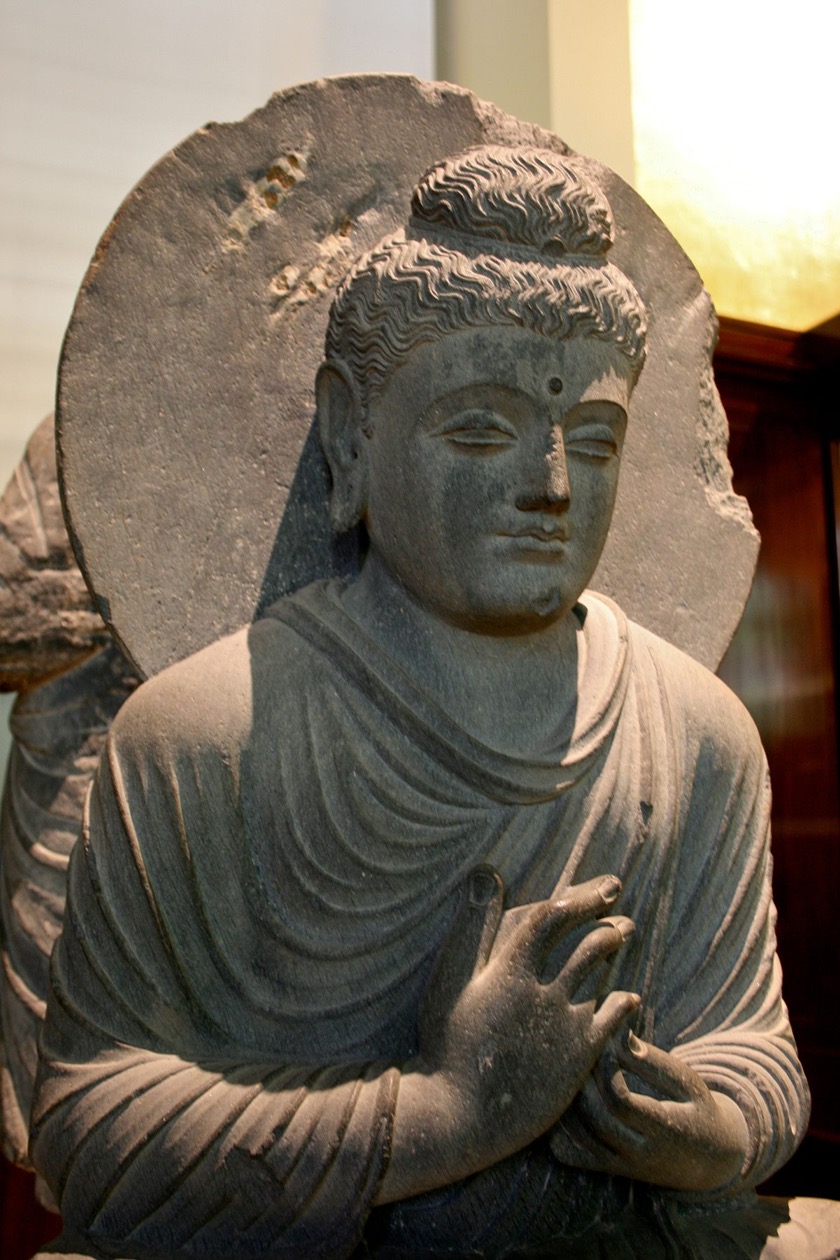
Above we have the Seated Buddha of Gandhara, which dates from the 2nd C or 3rd C AD, and is said to be one of the earliest known statues of Buddha. Below we have a Bimaran Casket with a representation of Buddha, which has been dated from the 1st C AD.
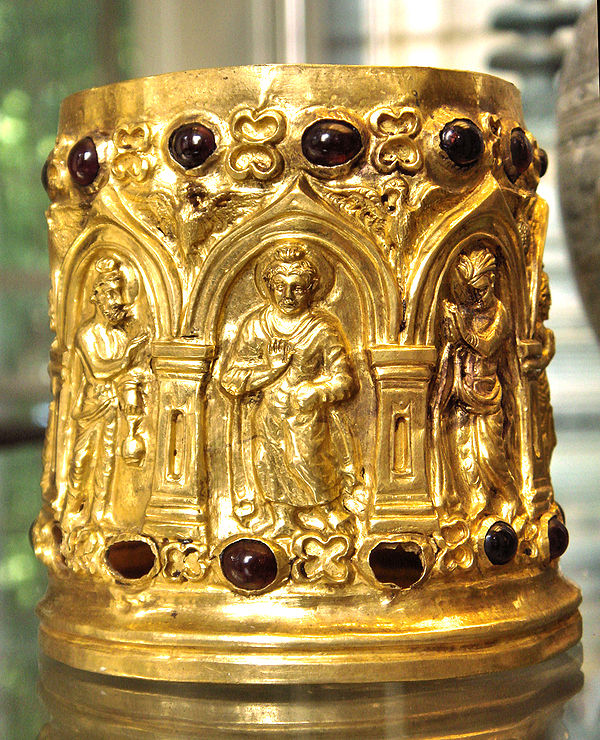
Early Indian religious structures
Early Indian architecture is often not dated, and there is an almost total lack of historical references in classical Indian literature. The approach adopted by many experts is to look at how architecture evolved along religious lines, i.e. Buddhist styles, Jainia styles, Brahman styles, and Indo-Islamic styles, and date artefacts accordingly.
But there are a few common traits that are worth noting. Except for Islamic buildings, the others had a predilection for minute and profusely ornamental carving and sculptures. Another noticeable characteristic is the stratification or layering seen on every surface, including towers and minarets. Finally there was a desire to produced amazingly picturesque surfaces that produce an impression of grandeur often quite out of proportion to the actual size of the building.
Inside early Indian structures there was a lack of internal spaciousness and majestic loftiness, what some people call 'architectural grandeur'. Vast areas could be covered by small inter-columniations and low ceilings. Many of the earliest buildings had a pyramidal stepping, and temples and shrines were often placed on terraces or platforms.
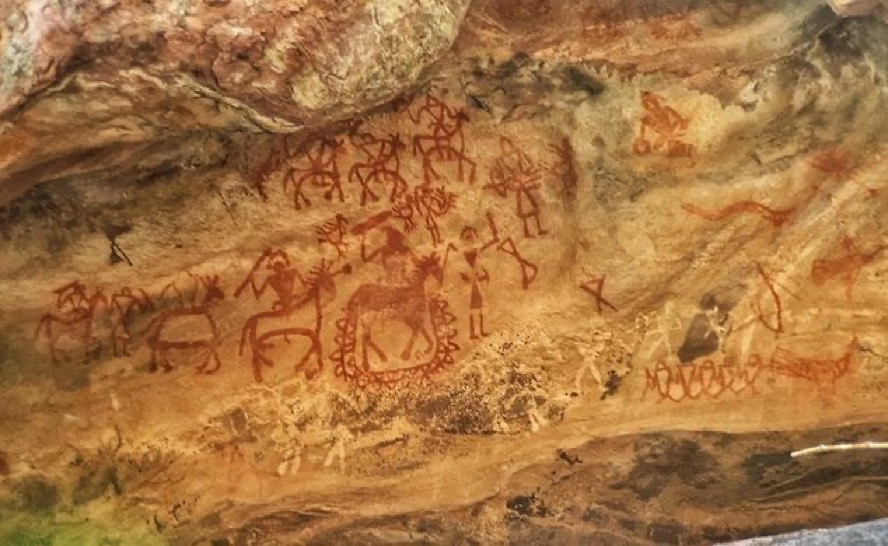
The Bhimbetka rock shelters consist of 750 rock shelters distributed over 10 kilometres, near Bhopal. They were home to the earliest traces of human life of the Indian sub-continent, and there is evidence that they were inhabited more than 100,000 years ago. The Indian Mesolithic period (ca. 6000 BC) saw the first evidence of the modification of caves, and in the 3rd C BC rock-cut architecture began to develop, either with or without the excavation of internal spaces (see Indian Rock-Cut Architecture).

In our quest to understand better Buddhist architecture we have to start somewhere. So let's start with Dholavira which was once a large city of the Ancient Indus Valley Civilisation, and may date from as early as ca. 2650 BC. Dholavira was one of the largest Harappan sites and was situated in the salt marshes of the Rann of Kachchh. The site lacks monumental palaces, so no big temples, etc., although baths could have been places for ritual purification. The so-called 'stepwell' (a kind of multi-storey pond) is about 73 metres long, 30 metres wide, and 10 metres deep, so the largest found in India so far. There were some huge circular structures that might have been graves or memorials, but no human remains were found. A hemispherical tumulus or kurgan in the shape of a spoked wheel has been connected with fire altars mentioned in ritualistic texts. The link with the altars and funeral mounds has not been proven, but some experts think that the Early Buddhist stūpa might have evolved from such mounds.
In the period 1200 BC to 600 BC the Vedic religion was practiced (often now called ancient Hinduism). The ideas and practices were based upon a large body of Vedic texts, that later went on to shape contemporary Hinduism. It is believed that temples did not exist during the early Vedic period. Towards the end of the Vedic period idol worship gained importance and the concept of a temple for the gods might have emerged. It is thought that community temples would probably have been made with a simple wood structure, clay walls and a thatched roof.
Aryan is often used to describe the Indo-Aryan peoples of the Vedic period (meaning those who came from northern India). They were presumed to have been fire worshippers, a practice that required no stately ceremonies, and consequently no temples.
The sacred texts of the Indo-Aryans was the Veda, but for a long time it was not reduced to writing. The Vedas consist of odes and hymns addressed to the various gods, such as Agni (fire), Varuna (sky), Mitra (Sun), Indra (Thunder), etc. Eventually the beliefs of the Aryans were merged with those of the local population, and one of the sacred texts, the Atharvaveda, best reflects this with the introduction of superstitions and tribal elements such as magic, exorcism, sacrificial rituals, etc. designed to appease evil and terrifying spirits. It is also true that some of the Vidic gods, notably Brahma, Surya and Indra, frequently appear in Buddhist texts as Buddha's attendants.
Each collection of verses was composed by priests or sages, and hindus think that the verses are of divine origin and were revealed to these priests. As an example, the Rigveda, one of the four sacred canonical texts of Hinduism, has 1,028 hymns with about 10,600 verses dedicated to cosmology and praise of the deities (the other three sacred texts are Samaveda, Yajurveda, and Atharvaveda). The verses would be recited when the priests threw oblations into a sacrificial fire. The four sacred texts also contain ancient texts for a priest, the Brahman, who later would be appointed to superintend and harmonise the functions of the other priests. Each Veda is again divided into four parts, i.e. Samhita, Brahmana, Aranyaka, and Upanishads, each explaining how the sacred texts deal with meditation, philosophy, spiritual knowledge, mantras, rituals, etc. The sutras gave directions for performing various duties, i.e. small domestic sacrifices, great sacrifices, and the enunciation of ordinary law and practice.
It is in the Upanishads that we see the introduction of karma, where a person's life is determined by the results of their actions upon their surroundings. A good deed will bring a good return and an evil deed will bring suffering and a bad return. It is the accumulative effect of a person's own deeds that ultimately binds them to the cycle of birth and rebirth. Karma from past lives determines the outcome of a birth in the next life. The ultimate goal is the spiritual release from one's karmas, and the attainment of enlightenment or release (moksha).
The period between 600 BC and 200 BC was the formative period for Jainism and Early Buddhism, and in the latter period Hinduism. The reality was that by 700 BC there were a large number of different sects in northern India that did not recognise the orthodox tenets of the Indo-Aryan religion. More than 30 different philosophical schools existed in 600 BC, but most died out or were merged into Jainism or Early Buddhism. It is also written that there were 64 different forms of Early Buddhism.
Mahavira (ca. 497-425 BC) is considered the founder of Jainism. Of regal status it is said he quit to become a mendicant, and after 84 days of meditation he obtained 'supreme knowledge', and then taught to not injure life, not to tell lies, not to steal, and not to possess property (chastity was added later). According to Buddhist literature Mahavira met with Gautama Buddha, founder of Buddhism, several times. The relationship between Jains and Buddhist was by no means cordial. There were conceptual similarities, but not of beliefs, faith or practices. One might view Jainism as extreme, for example they believed that even inanimate objects in nature were endowed with life. Mahavira offered deliverance through severe self-torture and death by starvation. Buddha enjoined his followers to adopt the 'middle way', however Jainism appeared to have been better accepted in northern India until the reign of Ashoka (ca. 304-232 BC).
In fact Buddha's teachings were much simpler than that of the Jains, and his religion was more acceptable to the lower classes (including the workers and servants or shudra). Buddha expounded the Four Noble Truths, namely suffering, the causes of suffering, cessation of suffering, and the paths to the cessation of suffering. He offered two paths, the Middle Path and the Noble Eight-Fold Path. The 'middle path' could be adopted by ordinary men and women, and whilst Buddha denied the authority of the Vedas he did not interfere with popular beliefs. The second 'path' placed greater constraints on those who practiced it, and I presume was destined for monks and nuns.
Both Jainism and orthodox Indo-Aryan religions were too intricate for the masses. However, during Buddha's lifetime Buddhism did not make much of an impression on educated people or powerful nobles (despite the fact that Gautama Buddha came from the same caste, the kshatriya). Buddha presented himself as a mendicant, and the tradition was that all powerful people should pay reverence to all mendicants, but that did not mean that they accepted his teachings. On the other hand, powerful merchants (the caste of vaishya) did patronise new religions including Buddhism, but it was Ashoka who finally raised Buddhism to a state religion.
We will encounter the mention of Rajgir (old name Rājagriha), one of the sites that received the first bone-relics of Buddha. But it's important to note that whilst it became a sacred city of Buddhism, it was in fact already one of the most important cities in India of the 6th C and 5th C BC. It was a heavily fortified city set within valleys, but protected by five hills. The fortification was called the 'Cyclopean Wall' and was built in much the same way as those of the Greeks and Persians, with bastions, watch towers and ramps. Dated to sometime prior to 6th C BC the wall was 48 kilometres long and had 32 large gates and 64 small gates. It's construction was with undressed limestone blocks normally ranging between 1 and 1.5 metres. The wall was high about 3-4 metres in places, and 2-2.5 metres in other places, but it was ca. 5 metres thick. There was also an inner fortification with an 8 kilometre wall. Rajgir played an important role in long distance trade being at the cross roads of several trade routes. Also Rājagriha is thought to have been one of the earliest Indian cities to become an important urban centre. We will see mention of the way Buddhism expanded by building monasteries at nodal points on trade routes, and the importance of patronage in the way their religious buildings evolved.
The Barabar Caves are the oldest surviving rock-cut caves in India, and date from the Maurya Empire (322-185 BC). The caves were dedicated to the Ājīvika sect that was still active at the same time as Early Buddhism and Jainism. The entrance includes the earliest surviving chandrashala, an ogee motif certainly imitating an arch made of wood or plants. Later temples started to adopt formal structures when they were built with bricks or blocks of stone.

It is interesting to note that in very primitive wandering forest communities (food-gatherers and semi-agrarian) the deadly snake appearing from beneath the earth played a key role. Firstly, it was regarded as the master of the underworld, having power to control the subterranean sources of water that sustained the fertility of the earth and all creatures living on it. Second, it was regarded as a malevolent and violent reptile, which could afflict deadly harm when offended. It quickly became deified as the Serpent god or the Nāga Devata. The Nāga often appears to look like a dragon, but it's a symbolic representation of a snake-like god.

People would seek his grace for fertility, fecundity and plenitude. Later Nāga also became the god of the weather, rain and clouds, possibly because lightning is like a swift moving snake. There is some evidence suggesting that temples dedicated to Nāga far outnumbered temples dedicated to other deities. It is not surprising that serpent-lore was liberally adopted and imbibed into the classical Buddhist and Brahmanical traditions.
In areas where people lived in isolated pockets, the world around them will have often inspired a deep sense of awe and fear. They believed in all-pervasive abstract and incomprehensible entities (forest-spirits) that might afflict their cattle and families. Some were violent demonic goddesses (Devī), who like the Nāga, once pleased granted fertility, fecundity and plenitude. They also had their temples. These demonic goddesses were adopted into Early Buddhism, and assimilated as mystic consorts of the male deities. But first, in Brahmanism they were given a sympathetic appearance, but only when appeased. Later they were absorbed into the terrifying manifestations of Kali, the destroyer of evil forces.
The Brahmans also assimilated native gods and goddesses into their pantheon and re-christened them with Brahmanical identities. And with tacit royal patronage the priests also secured control of landed property in the name of these new gods and goddesses. But in doing so they had to shed some of their most puritanical beliefs and practices.
The oldest layer of the Vedas (religious texts from ancient India), dating to ca. 1500 BC, introduces the concept of Brahman. There is no single definition of Brahman, but one idea is that it represents the Cosmic Principles that underlie all that exists (the concept of the ultimate reality).
Brahman is not the same as Brahma, a male creator deity in post-Vedic literature, who may have emerged from the metaphysical Brahman along with Vishnu and Shiva.
Brahmanism emerged from the earlier Vedic religion, with a stronger emphasised on the rites performed by a priestly class. Once the Vedas became the primary liturgical texts, there was a need for ritual specialists, the brahman, to perform the religious practices and honour the deities. Milk, grains and animals would be given into a fire and thus transported to the deities. Hymns and mantras had to be performed properly. Over time the brahman dominated the religious practices and established a ritual monopoly. Kings needed these rites to legitimise and stabilise their power. So the brahman were undisputed through to about 500 BC, and it is valid to call this period Brahmanism. However in the period 700-500 BC northern India became increasingly urbanised and smaller kingdoms were replaced by larger ones. Slowly there emerged a merchant society that was willing to support 'renouncer' traditions, including the ascetic movements such as Jainism and Buddhism. Both were considered heretic in that they challenged the sacred status of texts. Powerful rulers in the period 268 BC through to 100 AD supported Buddhism, whereas the Gupta Empire (319-543 AD) supported more the Brahmanical sacrificial traditions. Traditions that ritually legitimised the status of the king, maintained the boundaries between the social strata, and regulated the behaviour of people according to the general principle of dharma, i.e. order and obligation. The 'renouncers' advocated a homeless life, depending for food upon alms, and minimising personal ownership. Over time they became religious authorities in their own right, and people would ask them for spiritual advice and instruction. It was against this backdrop that Hinduism ideals crystallised and the leading gods and deities stepped forth.
For over 1,000 years before Christ, the centre of Vedic worship was the fire sacrifice. So there was certainly a need to control fire, to propitiate it and to personify it as a deity through the offering of food. As Brahmanism emerged, so appeared a number of gods that were seen as manifestation of Brahman. This changed Brahmanism from a religion for the elite and educated, to one that also allowed peasant worship. By 900 AD Hindu traditions emerged as a synthesis of Brahmanical and other popular religions. One of the major shifts was from the early Vedic sacrifice to the performance of puja. Puja, the most common form of worship today in India, has been described as a 'hospitality ritual'. During puja, the deity is called to the ritual and given water for washing his feet and hands. He is bathed, clothed, anointed with sandalwood, and given offerings of flowers or food. Then the worshipper circumambulates the deity to show his humility to the god, reciting hymns of praise. This type of worship could be performed by a family member in their own home, or officiated by priest in a temple.
Jainism slowly emerged between 900 BC and 500 BC, but it is often presented as a reaction to the leadership of an elite Brahman caste. Their focus was (and still is) on non-violence to any living thing, truthfulness, non-stealing, chastity and non-possession (poverty). The Jaina and Brahman religions existed side by side for several centuries with little friction and no sharp ethic line of division. Temples to both could be built in the same city, and in purely architectural terms it is difficult to know which temple belonged to which faith.
The earliest temples would have been made of wood, and no longer exist. They would have been small and designed to provide shelter for the gods. You can imaging them as constructed of wattle and supported by posts and beams. It is perfectly possible that the earliest stone temples followed the layout of wooden temples. There would have been some kind of simple square room, a sanctum sanctorum where resided the god. The entrance would be an open verandah with a roof and four stone pillars. With time the simple building would probably be surrounded by a cella-type construction made with wooden pillars. There is a good chance that the temple would have had a two-tiered pyramidal roof resting on the four walls of the sanctum. The logic here is that the ancient stūpa is believed to have had that form, and the earliest temples were probably designed to emulate the stūpa structure.
Initially Brahmanist temples followed a simple plan. A square inner space, the sacrificial arena or sanctuary (vimana) reserved for Brahman. In South India this would be a small, square, windowless, cave-like room, devoid of any ornamentation, where presided the deity in the form of an idol. It is here that the priest would perform puja, lighting the face of the deity with an oil lamp, and offering scented flowers and incense. Devotees were not allowed in, and could only wait in the doorway for a vision of the god. Above there would be a dome, originally modelled on the arch of leaves or bamboo that would have provided the earliest form of protection. Larger temples would often have an ambulatory route separated by lines of columns, with conical or rectangular sloping roofs. This would allow devotees to circumambulate the deity, and also provide access to spaces for other deities to reside. The inner shrine would be devoid of decoration, but the outer walls, etc. could be filled with stone-carved images. There would be a porch or waiting area framed by freestanding columns or a colonnade. The profile of the building was meant to represent Mount Meru, the abode of the gods and centre of the universe. The dimensions and proportions were dictated by sacred mathematical formulae designed to delimit sacred from profane spaces.

Mount Meru is a sacred five-peaked mountain in Hindu, Jain, and Buddhist cosmology, and is considered to be the centre of all the physical, metaphysical and spiritual universes. You can start to see how this symbolic representation might gradually influence the way temples would be constructed (building techniques permitting). I found it interesting that Chinese monks visiting India described temples with five storeys, each storey decorated with a different animal, 500 elephants on the bottom, then 400 lions, then 300 horses, then 200 oxen, and finally on the top 100 doves.
Temples in North India had the same type of floor plan, but the whole building would be broken into as many rectangular steps as possible. The porch would be covered with a stepped pyramidal roof, and the central chamber roof could be broken into innumerable minute surfaces with countless re-duplications of a simple geometric design.
World Heritage Sites in India
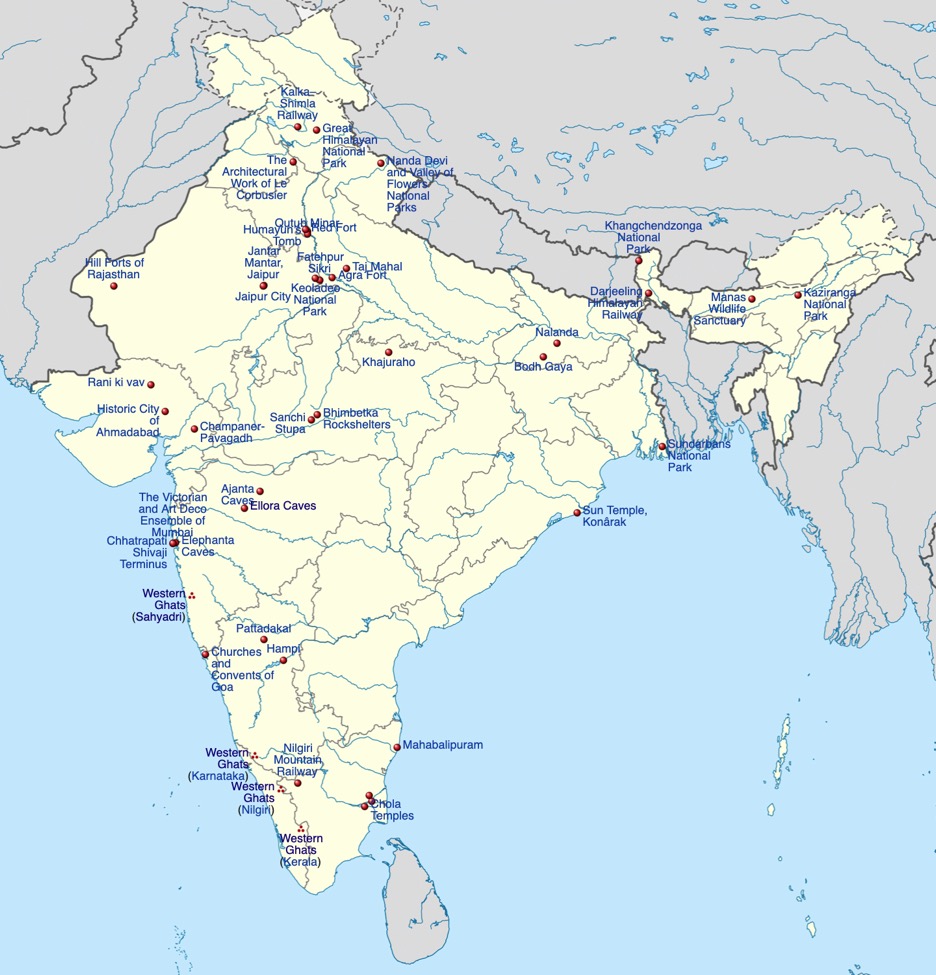
According to Wikipedia there are 34 World Heritage Sites in India, but we are only going to visit a few of those most associated with Buddhism. We will focus our 'visit' on the Great Stūpa at Sanchi and the Karla Caves in Karli (which is located in the Western Ghats - Sahyadri).
Early Buddhist architecture and temples
Most people accept that Siddhartha Gautama (ca. 480-400 BC), founder of Buddhism, lived, taught and founded a monastic order. No written records date from his lifetime, but it is accepted that a written Buddhist tradition did exist by the time of Ashoka (ca. 304-232 BC) the emperor of the Maurya Empire.
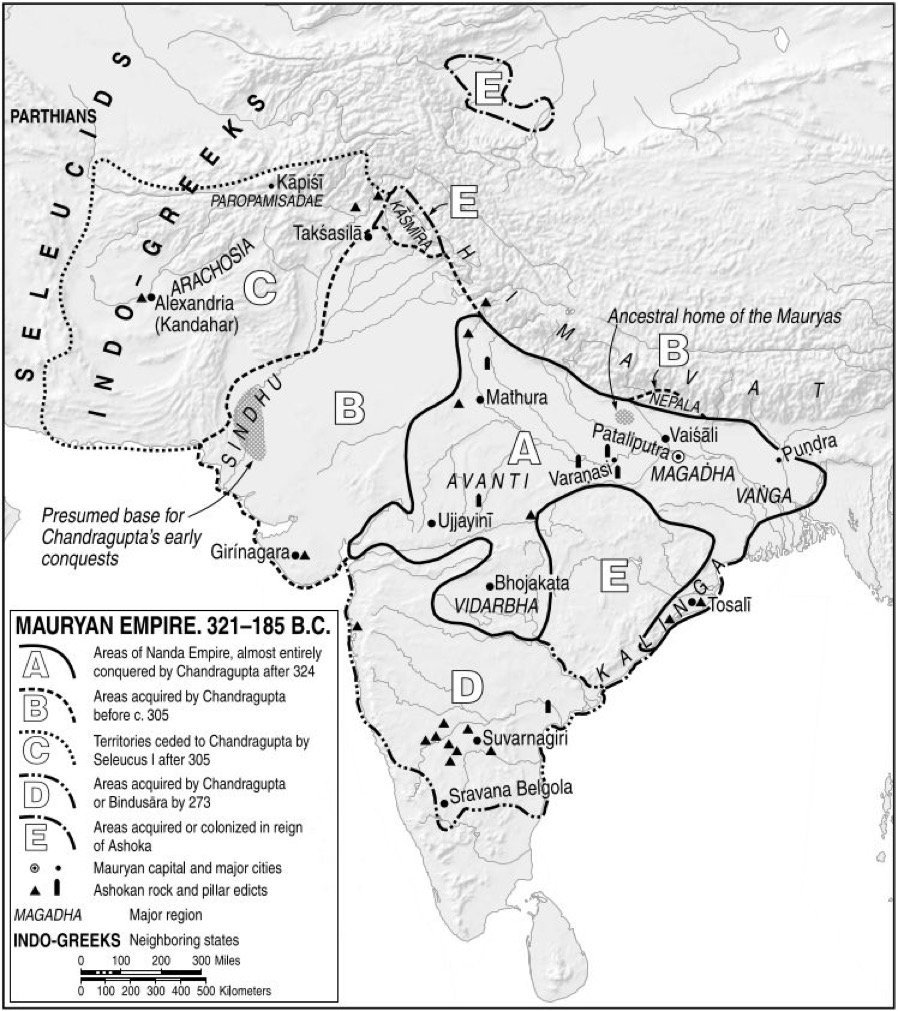
Upon his death Buddha's body was cremated and the remains, including his bones, were kept as relics. It is said that upon the death of Buddha, the relics were divided in to ten portions, eight body relics, one with the ashes of the cremation pyre, and one from the pot used to divide the relics. The body relics were given to eight kings and placed in eight different stūpas, to Ajatasattu, king of Magadha; to the Licchavis of Vaishali; to the Sakyas of Kapilavastu; to the Bulis of Allakappa; to the Koliyas of Ramagrama; to the brahmin of Vethadipa; to the Malla of Pava; and to the Malla of Kushinagar. Later it is written that Ashoka opened all the stūpas, excepting the one at Ramagrama, and further divided the relics and placed them in 84,000 new stūpas around the kingdom.
Just as a point of information there are also eight sacred places for pilgrimage, namely Lumbini, Bodh Gaya, Sarnath, Kushinagar, Shravasti, Rajgir, Vaishali and Sankassa.
It is generally accepted that Buddha and members of his order preached the dharma in the plain of the River Ganges, in the kingdoms of Magadha and Kosala. As an ascetic order Buddhism grew fairly rapidly because of support from the better-off strata of society, particularly merchants. Early Buddhists were able to build residences and later monasteries (vihāras). In addition forest-dwelling monks practiced a more intense form of austerity and meditation.
Strictly speaking, only monks and nuns constituted the membership of a Buddhist monastic order. They were responsible for preserving and passing on the teachings and providing the context for others to practice the religion. The ordained served to inspire the laity and teach them the dharma. Early monastic orders were autonomous and self-regulating, and there was no central decision making. So different monastic rules resulted in a variety of monastic traditions and schools. According to certain interpretations the ordained and lay supporters were all part of the same community, and the difference was that the ordained pledge to additional self-disciplines (the 'southern' tradition Theravāda has 227 rules for monks). In addition there was an important concept called sangha, for some schools it meant those who had become monks and nuns, but for others it was the whole community of Buddha's followers, both the ordained and laypeople. The monastic and lay communities were interdependent, the laity received teachings and guidance, and the monastics received food, clothing and shelter.
Initially it is written that there were 64 different sects or schools of thought in Buddhism, but only Theravāda and Mahāyāna remain today. There are also two minor or less popular schools, Vajrayāna and Zen Buddhism (although Zen Buddhism is often mentioned as being part of Mahāyāna Buddhism). These different schools have also been given other European-sounding names, respectively Small Vehicle, Great Vehicle, Diamond Vehicle/Thunderbolt Vehicle, and just Zen.
Theravāda places emphasis on the closed canon of Pāli Tipitaka first written around 100 BC in Sri Lanka. Mahāyāna refers to both the Pāli and to the sutras (teachings), written in Sanskrit and later translated into Chinese and Tibetan. The sutras are seen as a more appropriate way to understand the teaching of Buddha, rather that using only the original Pāli texts.
After the death of Buddha the new religion gathered strength, and by the reign of Ashoka (ca. 304-232 BC) it had become the dominant religion in India, and would remain so through to the 7th C AD. Early rulers tried to assume the role of a 'righteous king', and they protected the monasteries and supported the concept of a community of the ordained and lay people. The idea was to reinforce their religious and moral legitimacy. Ashoka not only established Buddhism as the state religion of his Maurya Empire, but he also opted for monuments as a way to spread Buddhism to different places (see Pillars of Ashoka). We should not forget that the Maurya Empire was based in Magadh, where Gautama Buddha lived much of his life.
After the Maurya Empire, there emerged a whole set of new kingdoms, the most important being the Shunga Empire (187-78 BC), Satavahana Dynasty (ca. 100 BC - 200 AD), Kushan Empire (30-375 AD), and Western Satraps (35-405 AD). All these dynasties patronised Buddhism at one time or another, and all helped in the construction of large Buddhist architectural monuments.
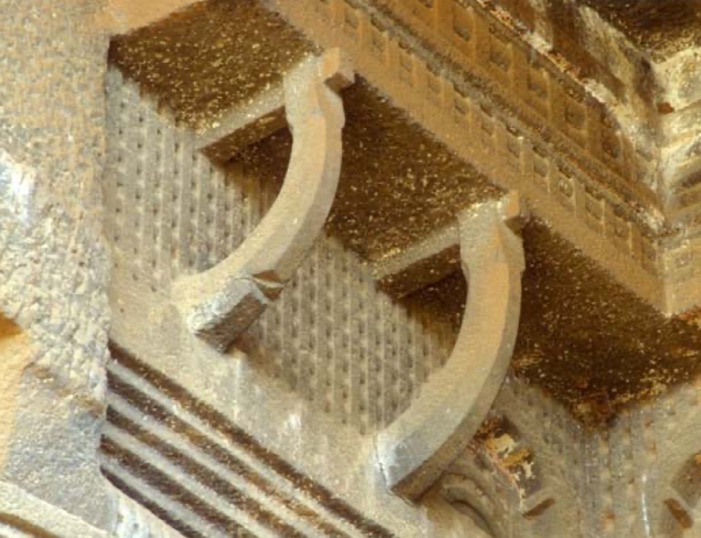
As already mentioned, all the formative and transitional architectural phases of Indian architecture have disappeared. The earliest buildings would have been made of wood, and in fact the caverns and caves show ample signs of wooden constructions, i.e. even mortices and tenons were repeated in the rock. Above we can see a traditional wooden balcony and support arms translated into stone.
In India, Buddhist structures or architecture are probably best classified as being either topes (including memorial columns and shrines such as the stūpa), temples (chāitya) or monasteries (vihāra), and as a separate category rock-hewn Buddhist caves. These were not isolated structures since, as a rule, they were often congregated on the same site.
As far as I can tell, in the Indian context, 'topes' are groves of trees, but in Pāli it ultimately meant a mound-like Buddhist sepulchre or memorial monument often erected over a relic. So it certainly includes the stūpa.
Stūpa is a Sanskrit word and meant "a knot or tuft of hair, the upper part of the head, crest, top, summit". In Rigveda texts it meant 'tree's stem', but it also can mean a 'pile of clay'. The origin might be linked to 'stup' which meant "to raise well up, raise aloft, elevate". The use of tope for stūpa was first introduced in English in 1839, and has its origins from the Punjab, but as mentioned above it probably derived from the original Sanskrit word stūpa via Pāli. Early dictionaries defined stūpa as "a Buddhist monument, dagoba, a relics shrine or relics casket". A dagoba was a pyramidal or dome-like form created over sacred relics of Buddha, or spots consecrated at the scenes of his acts.
The memorial columns, or lâts, isolated shafts, occurred mostly in northwest India and Sri Lanka, and many date back to the period of Ashoka.
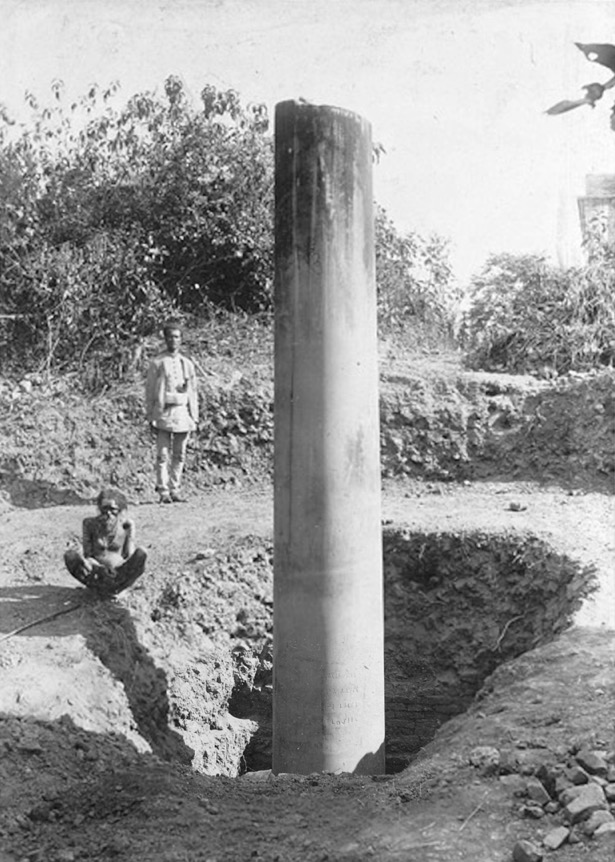
In 249 BC Ashoka visited Lumbini as part of his pilgrimage to the sacred Buddhist places. It is written that he worshipped in person at the sacred spot where the Buddha was born. To commemorate his visit, he built a stone pillar, which bears an inscription in Brahmi script to record the event for posterity. The inscription engraved on the pillar in five lines reads:-
“Twenty years after his coronation, King Piyadassi, Beloved of the Gods, visited this spot in person and worshipped at this place because here Buddha Sakyamuni was born. He caused to make a stone (capital) representing a horse and he caused this stone pillar to be erected. Because the Buddha was born here, he made the village of Lumbini free from taxes and subject to pay only one-eighth of the produce as land revenue instead of the usual rate.”
After the devastation of Buddhist shrines in India by the Muslims in the 13 C AD, Lumbini was deserted and eventually engulfed by the Terai forests. In 1896 a German archeologist came across a stone pillar and ascertained beyond doubt it was indeed the birthplace of the Lord Buddha.
Originally this column, or 'morality pillar', had a horse capital on top but later it was struck by lightning and broken in the middle leaving about 7 metres still standing. It is this pillar with its inscription that confirmed this site as the Buddha’s birthplace.
According to ancient Buddhist literature, when Ashoka visited Lumbini he also placed a “marker stone” on top of a pile of bricks as a commemorative monument, for himself and posterity to worship. The area just in front of the Ashokan column was excavated in 1992, and in 1996 a team of UN-sponsored archeologists announced the discovery of the Buddha’s birthplace. The archeologists excavated 15 chambers to a depth of about 5 m, and found a commemorative stone slab shaped like a womb atop a platform of seven layers of bricks dating back to the 3rd C BC, pinpointing the exact spot of the Buddha’s birthplace, the Sanctum Sanctorum. On the same site they also found a “marker stone” said to pinpoint the spot where Māyādevī gave birth to Prince Siddhartha.
In many texts Ashoka is just mentioned as a king who supported Buddhism, making it his state religion. However, he built a huge empire covering most of India, and until his conversion to Buddhism he was known and feared as a ruthless (even evil) leader. It is said that he decided to turn from armed conquest to the conquest of morality, but only after the Kalinga War (ca. 261 BC) in which hundreds of thousands of lives were lost, and 150,000 people were deported (he even went on to establish a Ministry of Morality). Once becoming a devout Buddhist, Ashoka nevertheless continued to support all the religions in his dominion (and he stopped the slaughter of animals). That did not stop him killing anyone who ridiculed Buddha. Also whilst he made Buddhist the state religion, he did not ask/order his subjects to convert to Buddhism.
In some texts a lât is the name given to columns cut out of one piece of stone, as opposed to a column or tower built of brick or stones. Also some texts include lât as another form of tope, i.e. something to mark the place of a relic.

One of the most impressive Ashokan columns is Allahabad Pillar, also dating from ca. 200 BC. It is a single shaft of polished sandstone nearly 11 metres high. The Ashokan inscriptions suggest that it was originally erected at Kaushambi, and it may have been moved when the region came under Muslim rule. It is thought to have once been topped with a lion, but the one seen today was only placed there in 1838. More recently there is a strong suggestion that the column pre-dates Ashoka, and has never been moved.
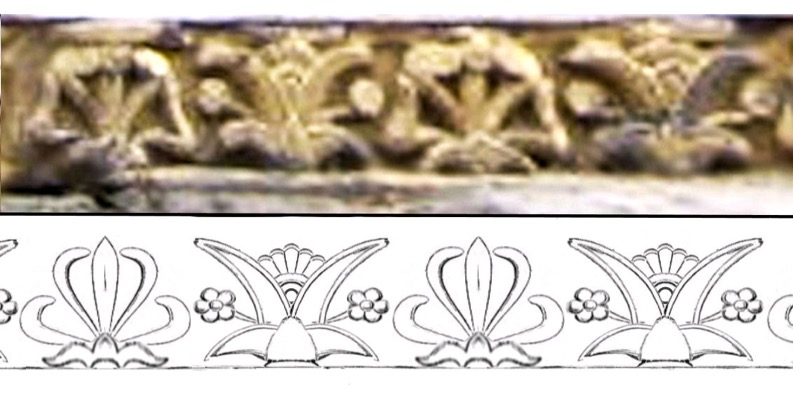
The column has an abacus (a necking just below the capital) decorated with a scroll of alternative lotus and honeysuckle flowers. The honeysuckle ornament derives from the Assyrians, which the Greeks then borrowed with their Ionic order. So it's interesting to see this motif appear on one of the earlier Buddhist monuments. The anchoring of the pillars varies, but all were designed to provide an excellent stability. The capital was separate and fixed to the column with a metal dowel.
The pillars themselves were made with a fine-grain highly polished sandstone and they stood between 6 and 21 metres above ground, the biggest weighed over 50 tons. The portions were 1 unit below ground, 4 units above ground, and a capital of 1 unit, and they were slightly tapered.
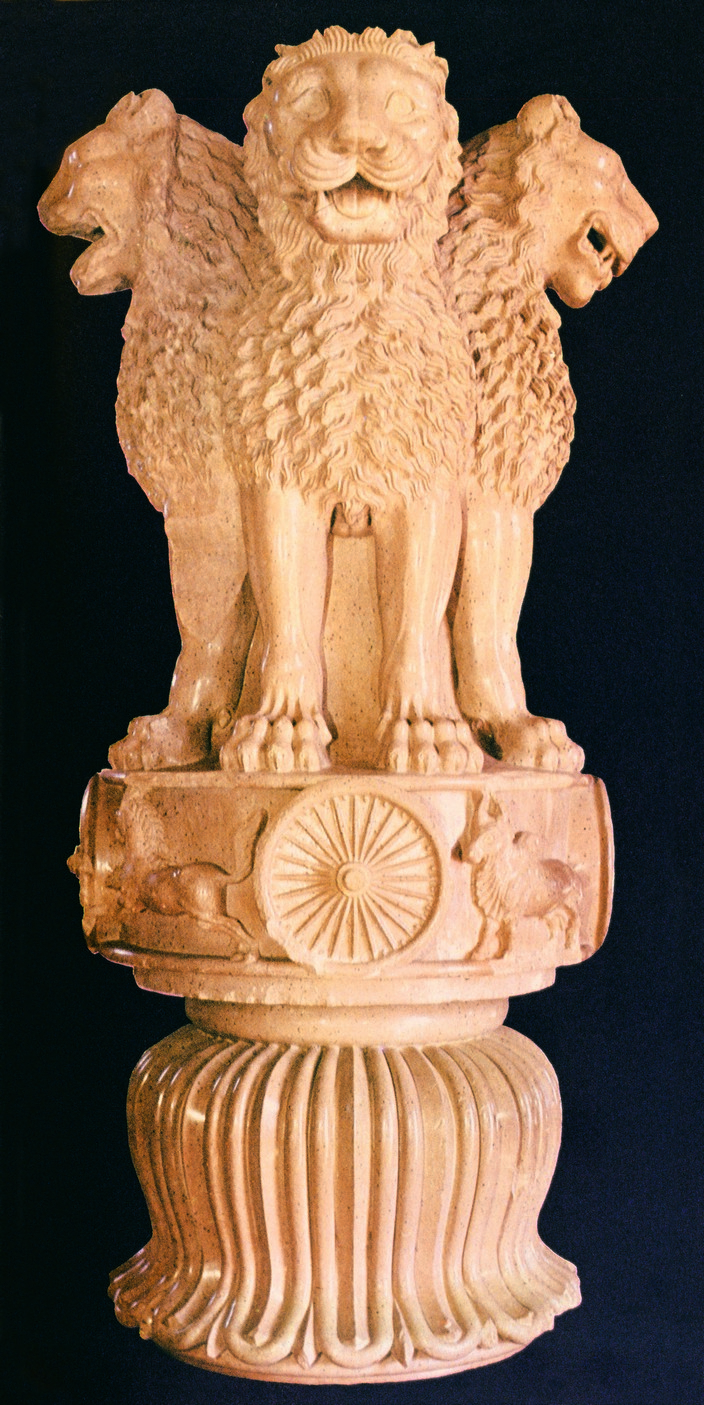

This is a photograph of the lion capital which is in Sarnath, which dates from ca. 241-233 BC. During his reign, Ashoka set up many stambhas or pillars which had inscriptions that tell us a great deal about his rule. Each pillar had an emblem on top as its capital. This lion capital was found at Sarnath in Uttar Pradesh and was chosen as the symbol of the Indian Republic. You will find this lion capital on all Indian coins, notes, government stamps and other official documents. It has four lions facing the four cardinal directions. Below the lions there is the Buddhist symbol of Dharmachakra known as the wheel of righteousness. Dharma has no single meaning, but in Buddhism it represents cosmic law and order, and can also mean the teaching of Buddha. Chakra meant wheel or circle, and initially represented the idea of influence and power, however later it took on the meaning of inner energy or psychic-energy.
The bull symbol denoted strength and goodness, the elephant, the horse and the deer were symbols of power, speed and grace respectively.
Hellenistic influence on Indian art
The reader will have notice a passing reference to a Greek inspired ornament on the abacus of the Allahabad Pillar, but in fact there is a whole Wikipedia webpage dedicated to this topic.
It would appear that Greek coins from the 5th C and 4th C BC were circulating in the Indus Valley (see the Achaemenid Conquest of the Indus Valley). Also it has been suggested that early Greek coins were at the origin of Indian punch-marked coins, the earliest coins developed in India. The Greeks were able to maintain a structured political presence at the door of India for about three centuries, through the Seleucid Empire (ca. 312-175 BC) and the Greco-Bactrian kingdom (ca. 256-126 BC), down to the time of the Indo-Greek kingdoms (ca. 180 BC to 10 AD). Greek influence on the arts of the Maurya Empire (ca. 321-185 BC) has been well documented, and the Hellenistic influence continued to be perceived in the syncretic Greco-Buddhist art of Gandhara, down to the 5th C AD.
The creation of the quasi-Ionic anta capital in the palace of Pataliputra (see also the Pataliputra capital) or the floral friezes of the Pillars of Ashoka are usually given as examples of the Greek influence, but the scope of adoption goes from designs such as the bead and reel pattern, the central flame palmette design and a variety of other moldings, to the lifelike rendering of animal sculptures. There are other more subtile signs such as the Buddhist cave inscriptions left by people who signed themselves 'Yavanas' (Greek) or the condescending remarks in Brahmanical literature about Yavana foreigners. I've even seen one quoted insult "You shut up, Yavana, wild-eater-of-a-hundred-cows".
Some authors suggest that the Gandhara school of art was a direct product of Hellenic art, others tend to suggest that it was influenced by a number of cultures including the Greco-Bactrian kingdom. One common suggestion is that the wavy hair on the statues and images of the youthful Buddha was influenced by similar Greek statues of Apollo. And certainly at times the ornaments, drapery and headdresses look more Greek than Indian, yet the postures, etc. are purely Indian. A nice way to look at this influence has been suggested with "the Gandhara artists had the hands of Greeks and the hearts of an Indian". So when the first images of Buddha appeared, the technique may have been Greek but the spirit and style were Indian.
I don't think anyone disputes the fact that the Greeks did influence both the politics and arts of Early India, but there does still appear to be some disagreement about the detailed 'when and how much'. Also the assertion that Indian ideas influenced Greek philosophical thought looks to remain an open topic for the foreseeable future. This uncertainty is natural because the Greek sources are only fragmentarily preserved and hence hard to interpret, and most Indian works are written in different languages (Pāli, Prākrit and Sanskrit) and are historiographical in nature and difficult to date.
There is an immense body of literature which discusses the way Greek art influenced Indian art, but there are also a few articles that suggest that this influence has been over stated. At least one argument is that Greek sculpture was of beautiful gods as athletes, or beautiful athletes as gods, whereas Indian (and possibly Egyptian) art is not about the representation of perfect men, but with the need to capture an inner divinity. The Greeks might have influence the techniques, but not the purpose or reason for sculpting an image of Buddha.
However, I've added this section with a far more specific purpose. I came across the article "The Ship in the Cave: The Greek and Nautical Origin of Buddhist Architecture". The argument is intriguing and starts with the hypothesis that Greek architecture and sculpture has a naval origin. The idea is that Greek seamen would run their deckless ships ashore and turn them over for shelter. Next a ship-like roof would be used on stone masonry walls as a covered meeting space or even a temple. And this led in the 7th C BC to other Greek public buildings, and to the design for Lycian sarcophagi, which the author then compared with early rock-cut Buddhist temples (e.g. the entrance to Barabar Caves). Below I've added also a modern-day take on a platted reed roof (e.g. Toda hut). Now one can see the similarity in shape with what's called the 'cant frame' on early wooden framed ships, but surely the link to reed roofing is far more likely.
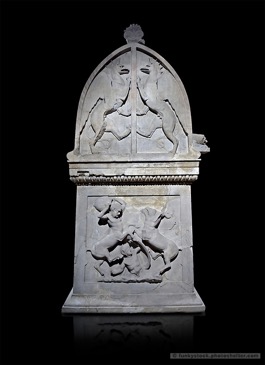
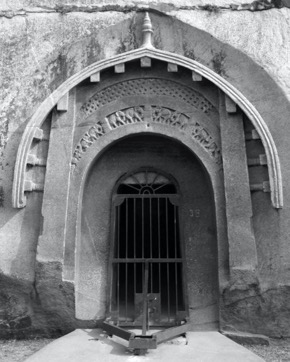

Even more intriguing is that the author goes on to suggest that the wooden roof ribbing of early Indian temples (and rock-cut temples) was based upon what are called the 'fashion pieces' (or ribs) on early Greek wooden hulls. I'm certainly no expert, but I'm not convinced because the ribs of the early Greek Trireme were simpler curved shapes attached to a keel and held in place by stringers (in accordance with the early 'shell-first' building technique). I always feel that the simpler solution is likely to be the most probable, but it's nice to see commonly held interpretations challenged occasionally.
Buddhist monasteries
So far we have mentioned monasteries numerous times, but it's worth stressing that monasticism began from the earliest days of Buddhism. The architectural requirements for a monastery were simple. The location was to be not too near, nor too far, from a town. Next the monastery was to be on high ground, in a park-like setting, and close to water. One commentary explicitly stated that a monastery must be "by night not exposed to noise and clamour, clean of the smell of the people, and hidden from men". The basic design was an inward-looking construction enclosed by a high boundary wall. A continuous gallery often surrounded a central courtyard, and the quadrangular monastery was the most common layout. Where possible permanent material such as brick and stone were used in India, whereas China preferred timber, and Tibet an adobe-style material. Over time the emphasis would shift from meditation to teaching and image worship, and monasteries would start to include chapels, temples, and stūpas.
The life of monk-disciples was one of a wandering mendicant with a strict adherence to the vows of poverty. The itinerant monk had no permanent abode, but for the three-month monsoon season they looked for shelter away from rain, wild beasts, etc. A tree or a natural cave were sufficient, and for example the so-called Vulture Peak was one of Buddha's favourite retreats. This monsoon season retreat is at the origin of Buddhist monasticism. It was during this time that monks came together to discuss Buddha's teachings and develop ceremonial practices, etc. These places became the first permanent monasteries in India and provided a place for the monks to meet with the laity. They would gradually develop into important centres of learning. Donations led to permanent buildings, and by 200 AD certain monasteries owned entire local villages. The wealth of Buddhist monasteries gave them influence over both the local population as well as more worldly politics. But the existent of permanent monasteries also led to sectarianism that would lead to fractures in the Buddhist community.
Ancient texts actually mention the design and construction of many of these monasteries. Buddha spent nineteen rainy seasons in Jetavana, a monastery enclosed within a boundary wall, and including wells and ponds. Within the walls there were dwelling rooms (vihāras) and cells for monks, store rooms, service halls such as a refectory and kitchen, gated chambers, fireplace halls, cloisters, meditation halls, bathrooms including hot baths, sheds, pavilions, well-houses, a storeroom for medicinal plants, ceremonial halls, etc. Only some foundations still exist today, but the evidence supports the construction of these monasteries possibly as early as ca. 530-400 BC. Excavations have brought to light plinths and foundations of stūpas, monasteries and temples, most dating from the 1st C to 2nd C AD. However, there are constructions also dating to the 11th C to 12th C AD.
According to early texts there were five types of structures permitted by Buddha. The vihāra or private residence, the house with turned-up eaves like a birds wings, houses of more than two storeys, houses with a pillared first storey and loft on top, and rock-hewn caves. All the free-standing structures have disappeared, but they can still be seen in stone-carved relief panels. Over time the rock-cut caves would become the most common type of dwelling for monks and nuns. Texts also show that Buddha permitted the use of five types of roofing materials, namely brick, stone, stucco, grass and leaves, and these could be combined with timber for foundations and walls (i.e. wattle-and-daub was allowed). Interiors could be decorated with murals painted on plaster surfaces, but the themes were limited to floral and foliate designs.
One of the oldest monasteries is the vihāra at Jivakarama, near Rajgir and the Barabar Caves. The site has been dated to ca. 530-400 BC, and initially it was formed by two long parallel and oblong halls. In the time before the existence of private cells, these were dormitories where monks would sleep and eat. Also the absence of a stūpa is notable, because the stūpa only gradually became symbolic after the death of Buddha. Only the outlined rubble foundation of this monastery remains today, but it is clear that the monastery evolved over time. Later constructions on the site included a very long elliptical hall nearly 70 metres long, possibly congregational or for teaching. Later still came a large walled courtyard and another smaller elliptical hall. Other monasteries were build around the same time, but they were more usually quadrangular in form and had cells along the walls. However, they were all characterised by the conspicuous absence of stūpas in or nearby.
We have already mentioned the impact that the patronage of Ashoka had the building of Buddhist stūpas throughout the Indian sub-continent. There is no doubt that following on from the communal monastery of Jivakarama, other later monasteries were centred on a major stūpa such as at the Sanchi site in the rock-cut cave monasteries.
It is probable that later designs, including quadrangular and celled type monasteries, date from the 1st C AD. Elliptical apsidal and vaulted structures with side entrances and without interior columns can be found in caves dating from the late 3rd C BC, and similar outline foundations can also be found on the Jivakarama site.
If Ashoka was the greatest Buddhist king, then certainly the Kushan Kanishka (ca. 127-150 AD) was the second. He founded numerous new monasteries and stūpas, and he sent missionaries to Central Asia and China. Mention is made of more than 600 new monasteries and the Kanishka stūpa is reputed to have been more than 150 metres high. It was during the Kushan Dynasty (30-375 AD) that quadrangular monastery design was developed. Between the two basic monastery designs, the communal monastery of Jivakarama and the quadrangular monastery, we have already the importance of the rock-hewn cave monasteries (1st C BC through to the 1st C AD). However, after a period of anti-Buddhist rule (454-552 AD), many monasteries and stūpas were destroyed, and many regions started on their long conversion to Hinduism and Islam.
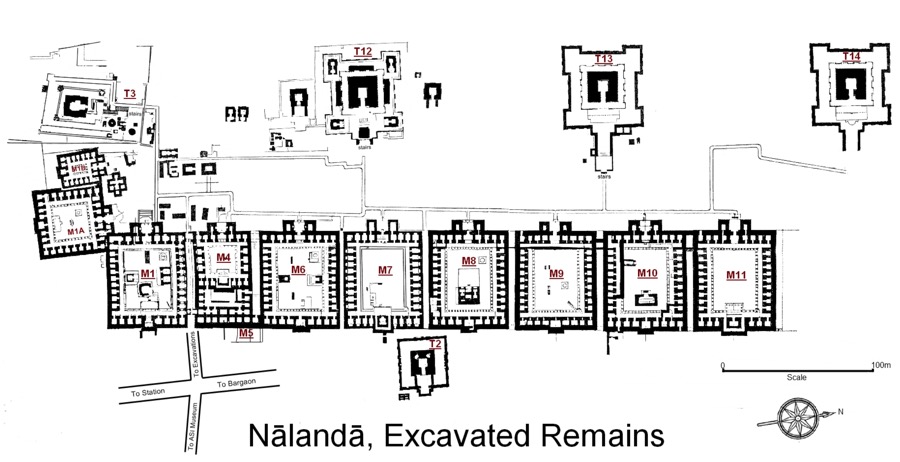
Nālandā can be used as an example of a huge monastery site dating from the 5th C AD through to the 1200 AD (most of the buildings were constructed in the 6th C AD, but many would have been later re-built). The site consisted of eleven vihāras (monks dwellings) facing a row of four chāityas or temples, and including numerous stūpas. In some sense this can be considered to have been a Buddhist monastic university. The largest vihāra was around 80 metres long and 55 metres wide, and they would have certainly been built and re-built (one shows nine strata of occupation). You can see the entrance, and in most cases there was a small image chapel at the back. In the courtyard there were wells and hearths, and there was a water discharge system taking water out to the back. The cells had built-in beds and niches. Each vihāra had a kitchen and refectory, and each was probably several storeys high. It looks as if the columns were first made of timber, but to support the weight they later were made of stone.
Temples (chāityas) followed the classical model with a central chapel surmounted by a tower, and four small towers in the four corners. One had the dimensions of about 50 metres by 60 metres. The different temples were built sometime between the 5th C AD and the 11th C AD. T3 and T12 are the oldest, and the stūpas are congregated around these two temples. Most of the stūpas are of the votive type. There are a number of accounts of visits by Chinese monks that can be used to try to date some of the buildings, but given that many were built and re-built several times it's difficult to put a precise age on the different remains.
According to one report dated to ca. 637-642 AD Nālandā had about 10,000 students and more than 1,500 teachers. A later report noted that the monastery was maintained by the revenue from 200 villages. The site as we see it above was about 600 metres by 230 metres, and surrounded by numerous ponds.
Shrines were first erected to preserve the relics of Buddha. The first type of shrine was the stūpa or solid tower-like structure placed over a small relic chamber set upon a broad platform. The retreating stages (stepped pyramid) were merely divisions in the external design. The second was the topes or circular dome-shaped structures. The topes were often large circular stone tumuli with domical tops, and surmounted by a model of a shrine or reliquary. Often topes occurred in groups in northern Indian and Sri Lanka.
The origins of the 'stūpa'
In reading about the stūpa I was intrigued by the appearance of the umbrella or parasol on top of the mound. As a symbol of power and authority (and sacredness) the umbrella was often seen in ancient Egypt (3150-332 BC), as well as among the Assyrians (2500-609 BC). When Buddha was represented by a wheel, a throne, or a pair of footprints, they were often placed under a parasol.
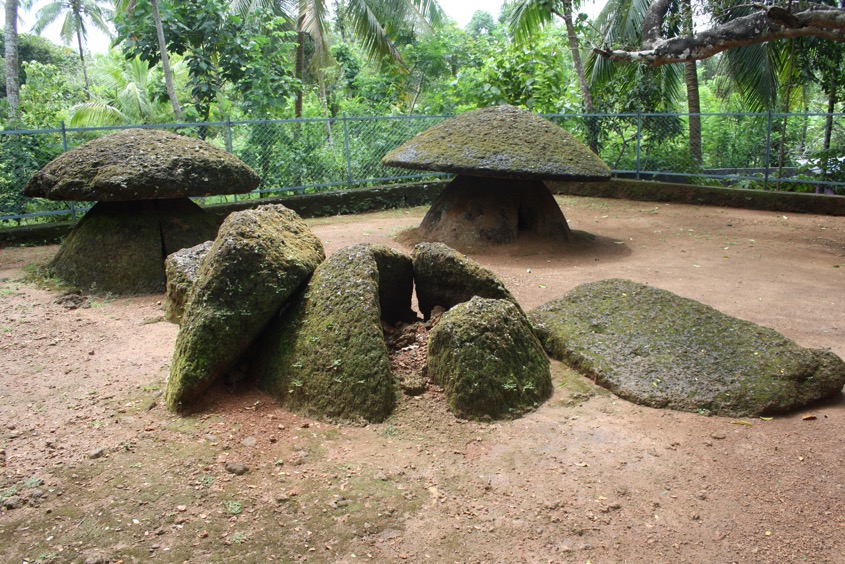
The 'umbrella-stone' had its origins in the megalithic culture of southern India (see Ariyannur Umbrellas). Perhaps as early as 2000 BC there appeared a simple stone construction consisting of four stones cut like half segments, supporting a fifth stone with a flat bottom and convex top. This resembled a parasol or large mushroom (about 1½ to 2 metres high and wide). Another example was the 'hood-stone' consisting of a large dome shaped stone (ca. 2 metres in diameter and 50-80 cm thick) place close to or on a grave or tomb (see Kudakkallu Parambu). Someone said they looking like a "group of giant mushrooms". It's possible that the 'hood-stone' represented the umbrella as a sign of honour and a means of protection. There were also 'hood-stones' sitting on a pillar 1 to 1½ metres high, probably erected to mark the spot where a body was cremated. There is also the suggestion that a simple construction with a top stone could have been the abode of hermits.

Above we have a god protecting Buddha with a parasol, and below we have the three umbrellas sitting on the top of the Great Stūpa at Sanchi. I'm not sure there was a rule to differentiate an umbrella from a parasol, and if there was a symbolic different. Some experts suggested that the placing of a reed umbrella on a tomb or stūpa might simply have indicated that the building was finished. Others have suggested a strong relationship between Early Buddhist beliefs and ancient tree-worship practices, i.e. Buddha attained the enlightenment whilst protected under the Bodhi Tree, and that 'awakening' is often called Bodhi.
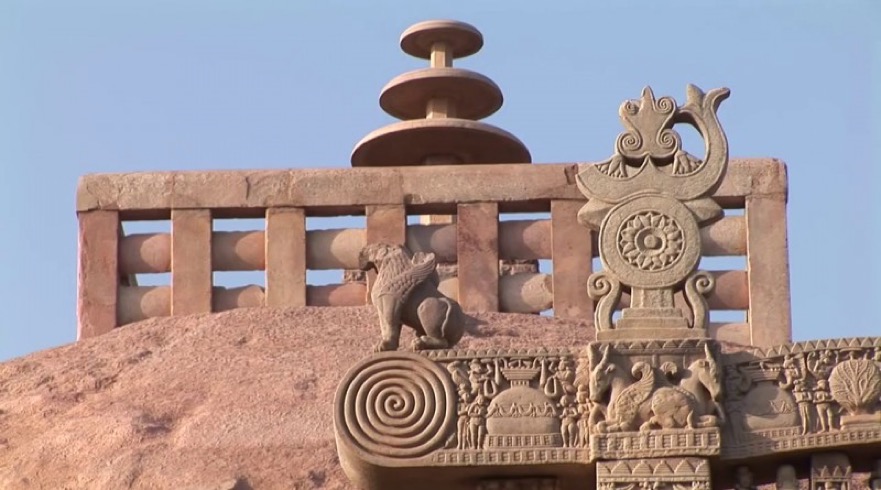
The umbrella or parasol provides protection from rain or the scorching sun. It symbolised the dome of the sky, and cast its shadow on the earth. The shadow represented protection for harm, illness, and difficulties. What is clear is that in many cultures the umbrella or parasol was also a symbol of wealth, or even royalty, i.e. the person was the centre of the universe. In East Asian culture the umbrella or parasol symbol represented safety and a refuge, and seen in the Buddhist context meant that Buddha and his teachings offered that refuge. The umbrella was also a symbol of dignity, wisdom, and compassion, and the parasol a symbol of peace. In the Buddhist context the shape of the umbrella had different meanings, with the square represented the four cardinal points (representing the Four Heavenly Kings), whereas an octagonal dome represented the Noble Eightfold Path. In some cultures the material used also indicated the rank and importance of the person, e.g. silk for religious dignitaries and peacock feathers for secular rulers.
When the Aryans invaded Iran and India, they gave to this new discovery (umbrella) an Aryan name, chatra (or chattra), which later was also used for the name of a mushrooms fleshy cap. And the parasol above a stūpa was known as a chattravali. I've also read that given that the original idea of a stūpa was a mound raised on the site of a funeral pyre or chita or cita, hence the name chāitya was used for a shrine, sanctuary, temple or prayer hall.
In a text dated ca. 487 BC it mentions that when Buddha died, canopies and umbrellas were placed over the bier. There are some sculptured panels showing a funeral car surmounted by a large umbrella with two monks in attendance. There was also a lofty pole supporting a number of superimposed canopies (I've read that you could get up to nine parasols on one pole).
In many cultures the umbrella became a symbol of authority and the state. In China the umbrella was also an acceptable offering to the dead. Often cities of the dead would exist, with coffins of the wealthy dead remaining in hired houses awaiting the auspicious day for burial. Open umbrellas would be placed next to the coffin. In other cultures a wooden tower would be built consisting of ten canopies fixed upon a lofty pole.
It is said that the origin of the storeyed pagoda in Eastern cultures derives from this tradition of canopies, and it then evolved into a building to house relics and sacred writing, before finally becoming a simple architectural style. In some cultures a temporary many-canopied wooden funeral structure (pagoda) would be built over the corpse and funeral pyre and consumed along with the body.
The earliest stūpa was a simple tumulus or circular mound of earth, possible surrounded by a ring of boulders. There are examples where there was an outer circle of stones enclosing a processionals path and sacred precinct. Some tumuli (stūpas) might have contained a small rectangular chamber, others not. Some chambers were small, just enough for one person, others were bigger and had a hole in the side where additional urns could be pushed in. With those stūpas without chambers, the remains would be placed on a slab, covered in earth, and topped with a few big heavy stones. So initially a stūpa had earth at its core, however over time it became an earthen mound encased in brick. Sometimes this was then covered in dressed stone, and the brick or stone could be plastered and decorated. Stūpas would have one or more terraces and would be topped with a railing and a crowning umbrella. They would have one or more circumambulatory pathways usually also enclosed by a railing. The earliest stūpas were hemispherical in shape, but later they took on a more cylindrical shape with a well developed drum. This change in shape may simple be due to the fact that the tradition appears to have been to enlarge a stūpa by building over it. So you can find a mud stūpa of small size, then enlarged by brickwork at a later time. For example, one particular stūpa was enlarged four times.
It's possible that the word stūpa has its origins in the samadhi, a Vedic/Hindi word meaning a structure commemorating the dead (samadhi also has a meaning as the ultimate stage of meditation, or specifically in Buddhism it's the eighth element of the Noble Eightfold Path). In reality a stūpa could take on many physical forms, e.g. tumuli, altars, monumental stones, columns, pillars, etc. In the Shatapatha Brahmana, Verdic sacrificial rituals used the square as a symbol for the gods, and the four corners were marked with pegs. Some larger stūpas have small stūpa-like constructs at the four corners. The idea of columns or pillars might have come from the use of those pegs. It's also been noted that the wooden post was also used for tying sacrificial animals. Certainly standing wooden poles or stone pillars have been associated with magico-religious ceremonies in numerous cultures.
Some tumuli in India pre-date Buddhism, however it was the Buddhists who developed the stūpa until it became the main feature of their architecture. Some of the earliest examples contained bones and a mother-goddess figure and were certainly Vedic burial tumuli. Initially the stūpa served to enclose the relics of Buddha or a Buddhist saint (body-relic or personal effects). Some contained no relics, but commemorated an important place or event in the life of Buddha. The Anglo-Indian word tope was often used for tumuli and stūpa, and a stūpa containing a relic was often called a dāgaba.
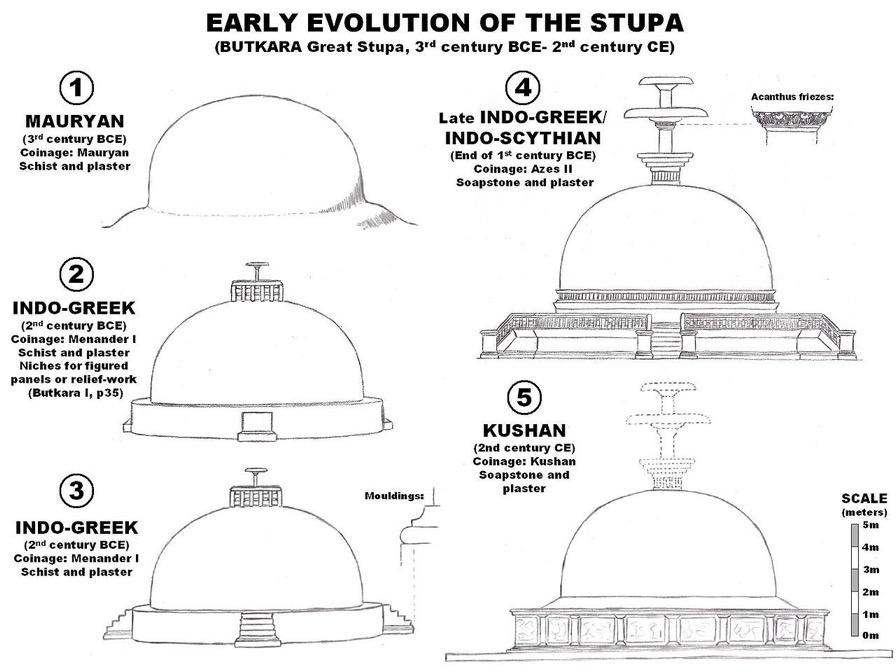
Above we can see the early evolution of the stūpa. Initially it was a bare hemisphere resting on a low circular platform. Possibly as a later evolution, the platform became a processional path, with a set of access steps. These stūpas could be quite small and humble and would just cover an earthenware pot and lid (no processional path on these ones). Then came the brick stūpa covered in plaster and standing on a low circular drum, and surrounded by a wooden railing. You might find pegs inserted halfway up the wall, to support a garland hanging round the dome. It is thought that initially they were flower garlands, and then later they were executed in plaster and painted. Placed on the top of the stūpa there was a wooden structure, called a 'tee'. You can't find these wooden coffers, presumably they were destroyed by treasure-seekers because they contained the offerings for the deceased. The 'tee' would later disappear from stūpas in India, but remained in other cultures. In India the 'tee' would become an upper platform decorated with a rail ornament, and topped with a slab of wood or stone. It is this box that would be topped with an umbrella or group of umbrellas. Offerings would be cemented into this upper platform, and thieves would try at the first opportunity to remove the valuable offerings and the gilt-copper umbrella. There was a nice touch, in that one report mentioned that the base of a stūpa was "rough stone trodden down by elephants".
It is though that it was during the reign of Ashoka that the royal umbrella became associated with the stūpa, as if he was saying that they were under royal protection. All important stūpas were provided with wooden railings and gateways placed at the four cardinal point, all enclosing the processional path around the shrine. We will see in the section dedicated to the Great Stūpa in Sanchi, that stūpas were often modified and enlarged to the point of almost being rebuilt.
To summarise, the earliest stūpas dated to the 3rd C or 2nd C BC (example the Great Stūpa in Sanchi). Initially they were large earth tumuli, but then they were raised on platforms (drums), surrounded by circumambulatory paths with elaborately decorated railings. New symbolic elements, for example the 'chatra' or ceremonial parasol, were erected at the apex of the hemispherical mound or 'anda' (also meant egg or egg shaped universe). Later stūpas were constructed of stone, brick, and stucco. The stūpa was a visible symbol for the common people, the more impressive it was the more prominent the power of the unseen icon or relic. Stūpas stood for Buddha himself, and they were even accorded legal standing and were treated as people with property rights. In addition the stūpa was a metaphysical symbol for learned people. Buddhists used the wheel and the stūpa as symbols for the Cosmos (i.e. the infinite space of the sky). The wheel became the symbol of dharma which is the foundation for the Cosmos. Having acquired an exterior that could be decorated, this laid the foundations for the metamorphosis of stūpa forms that occurred in subsequent centuries.
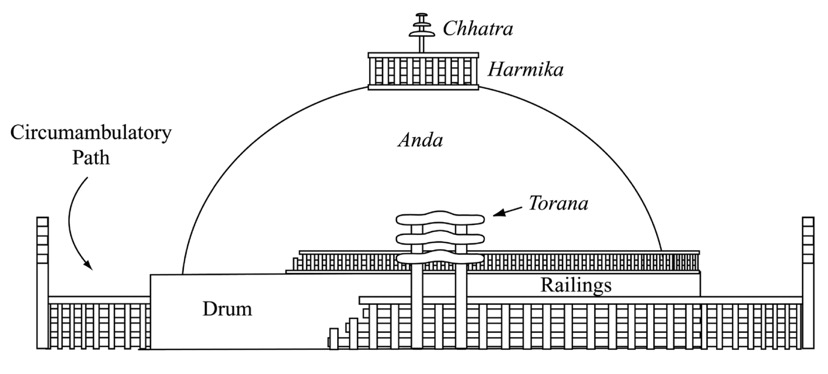
The terrace (drum) raises the dome, making it easier to find and to see when there were crowds. Secondly it increased the mass of the stūpa and together with the increased height raised the perceived status of the monument. The circumambulatory paths, the railings and the gates provided a route for the worshipper, and a place to locate inscriptions from those making donations. The stūpa became the symbol of Buddhism and the centre of ritual activities (remembering that initially Buddha was never depicted by artists).
This form of free-standing 'pilgrimage' stūpa was not the only type of stūpa constructed. Monks also constructed stūpas within the worship halls (chāitya) in monasteries. The circumambulatory path became a perimeter path within the chāitya. This type of stūpa changed dramatically over the centuries largely driven by the fact that the stūpa became the preferred tomb for almost everyone. So people had to decide what they wanted their stūpa to look like, would they stick to tradition or innovate? And this was also true for the monks in the monasteries. The two major changes involved the way the stūpa was made to look taller by making them thinner, and the way it was made to look heavier by simply lifting the midpoint of the anda above the plain of the drum.
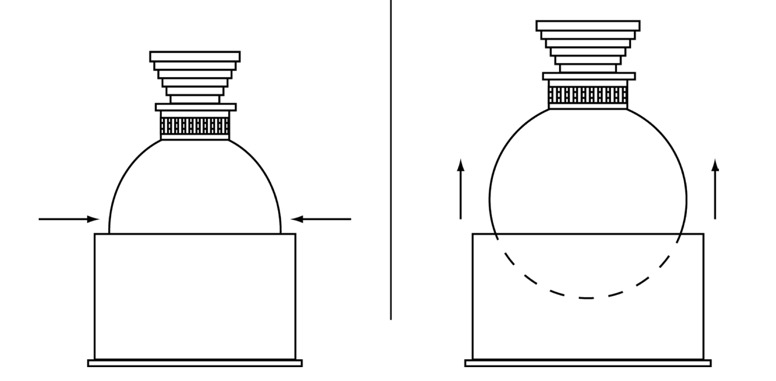
Below we have two examples, initially the focus was on a narrowing of the anda (on the left from Karla Cave 8), but later the focus shifted to lifting the anda (as seen on the right from Ajanta Cave 9).
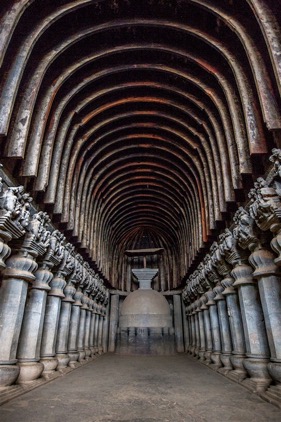

At the same time we can see how, inside a prayer hall, the stūpa was placed in the rounded apse opposite the entrance. And we can see that the trend was to replace the wooden chatras with ones carved in one piece with the anda (starting around 40 BC). You have to remember that the stūpa was not an addition, but like the columns it was carved in one piece of the solid rock.
Now that these stūpas were carved out of the solid rock there was no place for a relic, and by the 1st C AD the stūpa had taken on a symbolic role independent of the relic. It's been argued that as the stūpa lost its significance as the home of a relic, so the importance of the Buddha's image increased. For example, the stūpa in Ajanta Cave 26 was carved in the 5th C AD, and we see (below) that Buddha now takes central stage. By this time monks had abandoned the worship of a stūpa within chāitya halls in favour of worshiping Buddha images within their own monastic living quarters (vihāras).

This shift from the stūpa to the image of Buddha has been seen as the shift from Early Buddhism to Mahayana Buddhism, one of the two main existing branches of Buddhism practiced today (the other is Theravada Buddhism). The earliest images of Buddha were sculpted in the 1st C and 2nd C AD, but the shift to Mahayana Buddhism was slow and it was only finally adopted in mainstream monasteries in the 6th C AD. In fact the earliest images of Buddha depicted biographical events and not of the 'classical' sitting Buddha. However the gradual mainstreaming of Mahayana Buddhism has been characterised by the move away from monks meeting with the laity in the prayer halls (the chāitya with the stūpa) to monastic isolation with monks worshipping Buddha in a kind of small chapel in their living quarters. One suggestion is that by the 5th C AD Buddhist monasteries had become wealthy enough to not need the material support of the laity. There are reports that monasteries invested in dams and irrigation projects on their lands to increase yields and profitability. Also Buddhist monasteries had become moneylenders, so the idea is that monks did not need to assert their authority over the laity in order to speed up the flow of donations. They were free to refashion their rituals in a way more fitting to their new, secluded lifestyle. The monastic stūpas lacked the emotional immediacy of the pilgrimage stūpas and relics, and the Buddha image was a more satisfying, more emotional option.
Below we have two more examples of the way the cave stūpa changed through to the 6th C AD. The first is the stūpa at Dhamnār with the 'new', but quite discreet, multi-canopied umbrella decorated with a lotus ornament.
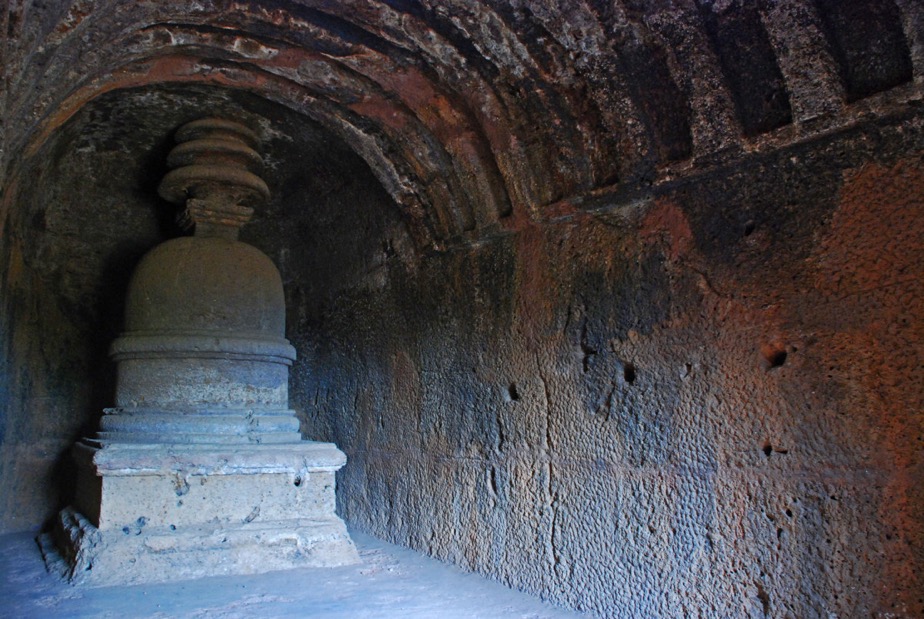
Our second example is Cave 19 from Ajanta. The original stūpa has been lifted up on an elaborate carved base with a recess for a substantial image of Buddha, and its topped with an even more elaborate triple-umbrella. And just as a finishing touch there is even a kind of mini-stūpa on top. In this example from the 7th C AD we can see that Buddha has become the object of worship, not the stūpa.

When Buddhist pilgrims visited any of the famous sites it became a custom to make an offering and set up some kind of memorial. The offerings could be money, jewels, or costly textiles for the rich, and fruit and flowers for the poorer visitor. The wealthy would build memorials in the form of a stūpa, and the poorer people would buy small stone models of stūpas and temples, or just leave an inscribed clay tablet. Over time the votive stūpas took on a great variety of shapes and styles, everything from low hemispheres to tall ornamental spires, and each would have a niche for a figure of Buddha.
Unfortunately today it is very difficult to find in India later structural examples of stūpas. Most have disappeared and the remaining ones are ruins, however we can look for examples in Ceylon and Burma. We must remember that whilst the teaching of Buddha arrived quite quickly in China and Burma, Buddhist architecture did not arrive there until the 7th C AD.
There are also descriptions written by Chinese pilgrims to India, for example Song Yun visited India in the period 518-522 AD. He left an excellent description of a temple pagoda surmounted with a rod. It was thirteen storeys high, had stairs leading to the top, and was built of carved wood. On the top was a 10 metres iron rod with thirteen superimposed gilded chatras (umbrellas). He took back drawings, and it's just possible that they may have inspired similar temples and stūpas in China. As some experts have pointed out, if you put a big iron rod on top of a tall wooden building you should not be surprise if it does not survive the ravages of time.
The general opinion is that over time the dome of the stūpa became increasingly insignificant compared to the 'tee' and umbrellas, which assumed the form of a conical tower taller than the stūpa itself. Below we have a Pagan Period (849-1297 AD) stūpa, which clearly shows how the 'tee' and umbrellas came to dominate the dome of a stūpa in one of the temples of the period.

Below we have the Swayambhunath stūpa which was probably started around 640 AD, but has undergone several major restorations. Nevertheless we can clearly see how the 'tee' and umbrellas have come to dominate stūpa architecture.

Buddhism declined in India in the 7th C AD, and Brāhmanism in the form of Hinduism re-asserted itself as the popular religion of the country. However, by then Buddhism had taken root in many other areas to the North and East, from China to Indonesia, and Buddhist architecture continued to evolve and mutate. The role of this webpage is to delve further into the understanding of Buddhist architecture in India, firstly with the Great Stūpa at Sanchi, and then with the rock-cut architecture in the Karla Caves. But it's worth mentioning that stūpa architecture will have always depended upon local materials, climate, tradition, etc. The classical dome-shaped stūpa prevailed in India, while in Indonesia it metamorphosed into a multi-terraced monument. Further into East Asia it would become a multi-tiered pagoda, while in Myanmar (Sir Lanka) it would be transformed into shimmering golden pinnacles. The stūpa in Pakistan, Afghanistan, Central Asia and Turkistan evolved differently. The key was how they grew vertically, some rising to more than 150 metres. This form of stūpa would start with a plinth, and several tiers of circular drums stacked one on top of the other, and capped by a dome, sometimes quite insignificant in size. On top there would be an imposing pole with up to 10 umbrellas (chatras). This topping could equal the height of the base and body combined. Naturally this last form of stūpa evolved in steps, the plinth lifted the stūpa off the ground, and could also be home to four free-standing pillars. Most examples were topped with an imposing family of chatras (umbrellas). Gradually additional plinths and tiers would lift the dome even higher. Then the stūpa might be coated in plaster and painted or gilded. Below on the left we have an example from ca. 250 AD, and the middle one is from ca. 450 AD. You can perhaps see how the early Chinese stūpa might have evolved into the pagoda ca. 200-300 AD (see far right).
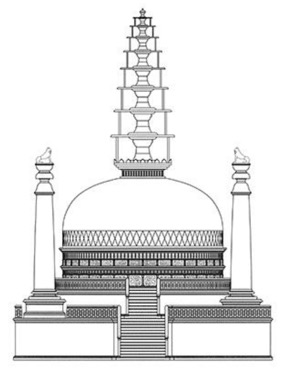
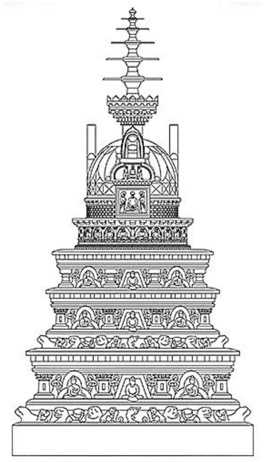

As a video resource, check out The Stūpa.
The Great Stūpa at Sanchi

One of the oldest example of a stone structure in India is the Great Stūpa at Sanchi (actually more like a tope). The Wikipedia article is an extensive review of the site as seen today, and it does also mention how it was re-discovered and documented in 1818.

Sanchi is just one group of Buddhist monuments situated near the present-day city of Vidisha. Nearby there was once an important trade centre in the 5th C BC, and later a flourishing community of Buddhists built their memorials and monasteries on commanding spots on the surrounding hills.
The distribution of goods such as coins, shell objects, and ornaments shows that trade in the Indian sub-continent involved the transfer of 'information' and common values as well as the exchange of actual objects. The uniformity of material culture reflects other trends towards cultural unity in the sub-continent in the period 3rd C BC to 4th C AD (the Indian Early Classical Period), such as the development of Buddhism and Jainism. The spread of Buddhism is manifested in the widespread appearance of similar iconography and a distinctive architectural form in the period. Starting in the 2nd C BC the simultaneous appearance of Buddha's image at sites all over India signals the presence of travelling skilled artisans. The similarities of form and design in Buddhist religious buildings such as in Sanchi further indicates that artisans travelled the same routes as traders. Records of donations indicate that patrons of Buddhist temples, from kings to commoners, also travelled from their residences to distant shrines. Inscriptions from cave temples and from the stūpas at Sanchi show that ordinary people made pilgrimages over substantial distances.
Below we can see some of the major Buddhist sites all over the Indian sub-continent, and its easy to see how Sanchi would have been strategically important in the trading routes between the Indo-Gangetic Plain and the Arabian Sea ports.

However, it is thought that trade took place on a highly flexible basis. Traders and travellers exchanged information about appropriate trade routes, travelled in groups for safety, and altered their schedules to avoid problems with seasonal weather extremes. Guilds were well established, often had dedicated areas in larger towns and cities, and even acted as banks where promissory notes of one merchant would be honoured in another town or city.
Starting in the 2nd C BC the popularity of Buddhism was manifested through the construction of many monasteries all over India. They were built to be inhabited in the rainy season, so monks and nuns would have a home when travelling was impractical. However we know they were also used by travellers and traders, and it has been noted that because monks and nuns could be trusted, their caves were often safe places for storing goods, etc. And we know that merchants donated generously to the Buddhist vihāras (monasteries).
The physical and political landscape determined which travel routes people used, but they were not deterred from travelling. There is ample evidence that even smallish communities participated in trading networks by producing tradable surpluses (raw materials through to finished products). And these communities were also stopping-points along routes used by pilgrims, traders and officials. Examples often quoted as products traded over longish distances are mica used in making pottery and sandstone grinding tools, both quiet 'utilitarian' items. So trade was not limited to the specialised traders or the elite.
We will see later that alongside the building of the Great Stūpa in Sanchi, Buddhists had also started to cut cave dwellings out of rock faces, particularly in western India. Of the nearly 1,200 rock cut excavations in India, around 800 are in western India. The vast majority of the Buddhist rock caves were on or near trade routes.
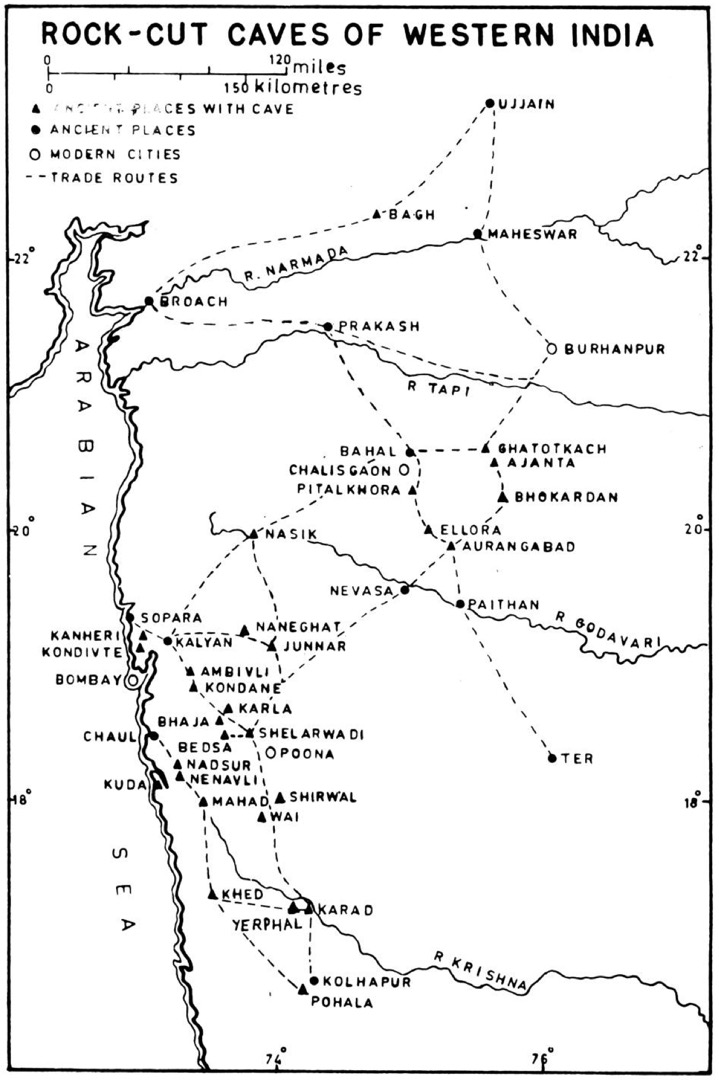
People often forget that the annual exports of grains, etc. from the Indian sub-continent to Ancient Rome was valued annually at 50 million sesterces, which was seen as a major drain on Roman coffers. There is an account dating from ca. 70 AD that lists the exports from the Indian sub-continent to Ancient Rome as spices such as black pepper, dry ginger, nard oil, cardamom, costus, bdellium, in addition to ivory, agate, carnelian, cotton cloth, silk cloth, yarn, all kinds of wood including sandalwood, black wood and ebony, birds and animals, pearls, herbs used in medicine, brass vessels, …
The Emperor Ashoka had been governor of Vidisha, and his first wife was brought up in Vidisha. We know little of Ashoka's early life, but texts from Sri Lanka say that Ashoka was viceroy at Ujjain when his father died. He had married Devi, a local lady of Vidisha and they had had two children, a son Mahinda and a daughter Sanghamittā. The lady being only of a merchant's (or banker's) family, she was left behind when Ashoka went to secure his succession.
Sanchi itself had no connection with the life of Buddha, yet it is home to one of the most impressive examples of Buddhist architecture in India. What was important was that Buddhist builders found a sandstone quarry nearby that could be easily worked. The history of Sanchi starts with Ashoka and covers about 1,300 years, thus mirroring the rise and fall of Buddhism in India. There is mention of Ashoka's first wife actually building a sumptuous vihāra or monastery at Sanchi. It was also at Sanchi that Ashoka set up one of his edict pillars. So it has been concluded that Buddhist monks were established in Sanchi before Ashoka decided to take a special interest in the place.
It was some time later, after the death of Ashoka, that the second and third stūpas were built at Sanchi, and the Great Stūpa acquired a stone casing. There are in fact ten topes on the plateau on top of the hill (no. 4-5-6-7 were solid mounds of masonry, and no. 8-9-10 were just circular foundations). The second tope was found to contain part of the ashes of two of Buddha's principal disciples (or missionaries). We do not know who was in the largest tope, because no relic box was found. However there is a suggestion that it might have contained a portion of Ashoka's re-distribution of Buddha's relics.

Above we have the site plan for Sanchi. It's taken from the book of John Marshall 'A Guide to Sanchi' dating from 1918. The various monuments were numbered 1 to 50, starting with the Great Stūpa (no. 1) then stūpas 2 and 3, and so on. Apparently this site plan has not been improved on, and it figures on almost every webpage on the Sanchi site (see example below).

So the most splendid structures at Sanchi were erected during the period of the Satavahana Dynasty (late 2nd C BC to early 3rd C AD) and the Great Stūpa was given four gateways and a balustrade some time after 70 BC (the Wikipedia article on the Satavahana Dynasty also has some interesting photographs of the art of Sanchi). It is these gateways that are often considered the most striking examples of an art that had liberated itself from a past artificiality. A sense of perspective had been found, and the postures of the figures and groups had become more dramatic and convincing.
Sanchi continued to benefit from some consideration though the rule of the Guptas (mid-late 3rd C AD to 543 AD). For example, there is an instruction dated 412-413 AD where a gift is made to the vihāra for the purpose of feeding mendicants and maintaining lamps. Through the 5th C and 6th C AD Sanchi benefited from gifts, mainly detached sculptured panels, and it is also probable that the panels and walls in Sanchi's monasteries and chapels would have been painted (the paints have disappeared). By about 1000-1100 AD the Buddhist religion in India had been merged with Hinduism, and from the 13th C onwards Sanchi was deserted (and the city of Vidisha was in ruins). It would appear that Sanchi was also left unscathed by the Muslim conquerors, so it was ripe to be re-discovered in 1818. Three of the gateways to the Great Stūpa were still standing and the great dome was intact. Below we have a photograph of the Great Stūpa before restoration.
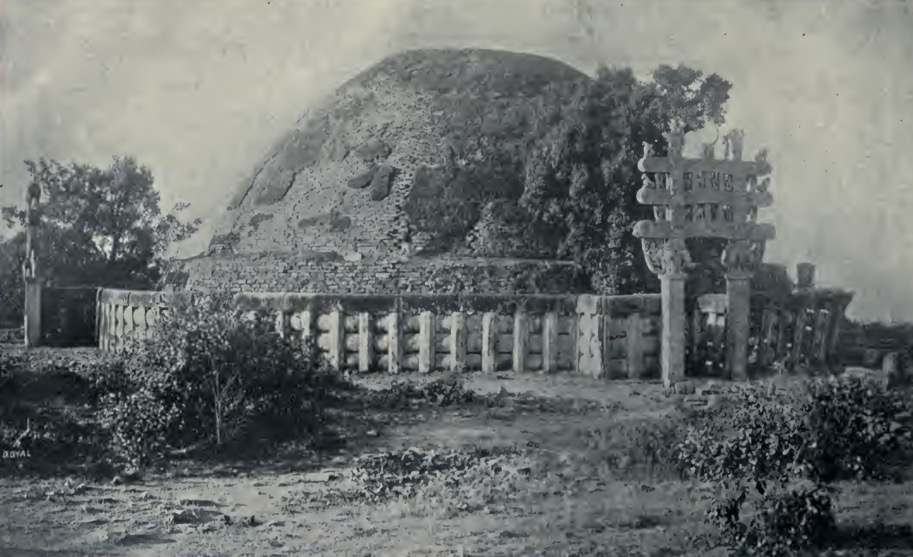
Unfortunately once re-discovered the site was invaded by treasure-seekers, who demolished what 100's of years of neglect had failed to do. The Great Stūpa was opened, as were the others, resulting in the partial destruction of the site. Plaster casts of the eastern Gate were made and presented to the principle national museums in Europe, but it was only in 1881 that the Indian government made an effort to safeguard the site. And it was only after 1912 that the overgrown vegetation and debris was cleared from the site. Below we have a photograph from 1937 when the site started to become a tourist attraction.

The Great Stūpa is a funeral mound or tumulus, but it is not clear if initially stūpas had any sacred significance for Buddhist. Then Ashoka divided up the body-relics of the Buddha and erected stūpas to enshrine them in all the principle cities of his realm. More or less immediately the relic-stūpa became an object of cult-worship. Other stūpas would be built to enshrine other holy relics or simply to mark a sacred spot. The next step was that building a stūpa, with or without a relic, was in itself a work of merit that would bring its author nearer to salvation.
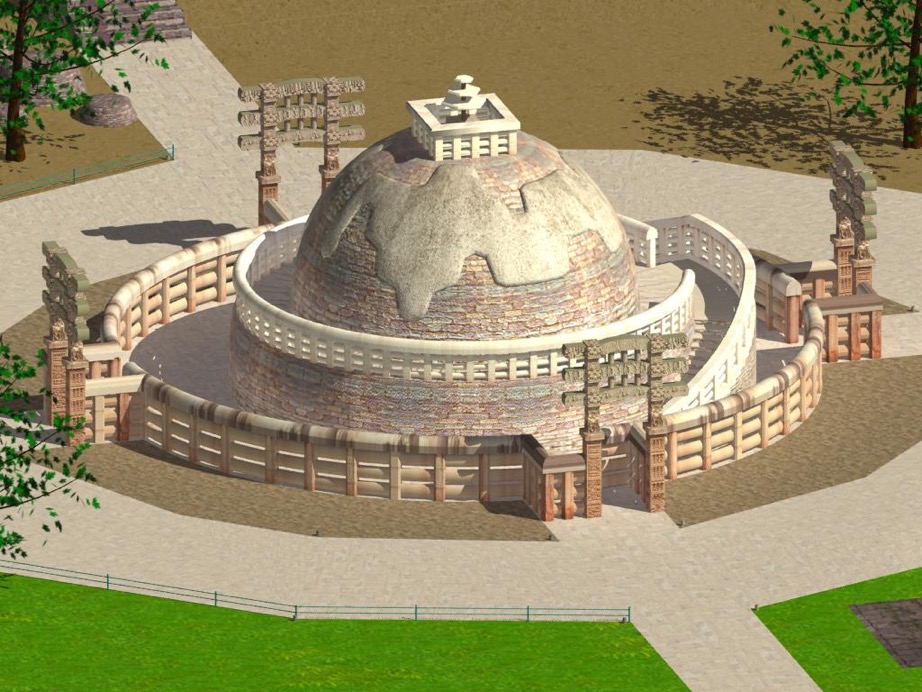
The Great Stūpa consists of a near-hemispherical dome, truncated near the top, and surrounded at it's base by a lofty terrace. The terrace would have been used as a processional path, and access was provided by a double flight of steps. Encircling the monument on the ground is another processional path, enclosed by a massive balustrade of stone. Access was through four stone gateways decorated with elaborate reliefs.

The original stūpa was a structure of brick about half the diameter of the present stūpa. We know that the brick used for the original stūpa corresponds to those used during the epoch of Ashoka. The term 'brick' might be a bit misleading in that these bricks were 40 cm by 25 cm by 8 cm.
Possibly about 100 years later the original stūpa was encased in stone and brought to its present dimensions. The final dome was 36 metres in diameter, and 16.5 metres high. The second envelop was built layer-by-layer, and the gap filled with heavy rubble stones. Once completed a raised terrace was added, and everything was then covered in a thick layer of concrete. It may have then been plastered and decorated. On top there was a stone box that would have contained the relic, and it was then probably crowned with a stone umbrella (debris of this was found on the site). The balustrade was built, but the four gateways were probably added ca. 100 AD. The ground level balustrade and gates were all built by gifts from donors, whose names were incised in the stone. The latest inscription dates from 450-451 AD, and is for money to feed one mendicant day-by-day and maintain the lamps where the images of the four Buddhas were seated.
It is probably that the stūpa would have been plastered and painted white with a flower decoration, and the balustrades and gateways painted red. It's the inscriptions that helps date the Great Stūpa to about 200-150 BC. It is the four gateways that are the crowning glory of this Buddhist construction. Giving the construction techniques used in the gateways, experts have concluded that the work was probably done by carpenters rather than stone masons. On the top of the gate you find, as you would expect, the Buddhist 'Wheel of the Law' (dharma-chakra) supported on elephants and lions and flanked by guardians.
Also we must remember that when the Great Stūpa was started Buddha was nowhere to be seen, but his presence was suggested through some symbol (a footprint, throne, hut, sacred tree…). The umbrella is another symbol for the Buddha, and there is even one example of a horse with an umbrella on it. The hut appears here and there, but it also started to transform itself in to a house, then a multi-storeyed house, and finally a palace. This helps place different sculptured panels in chronological order. Naturally the key moments in the life of Buddha are well represented, i.e. his birth, enlightenment, his first sermon, and his death.
Experts have noted that there were no images of Buddha until sometime between 100 BC and 100 AD. However it's been suggested that depictions used symbols, such as the hut of a holy man. So worshipers did not see Buddha, but his presence was felt through the images of huts in which he would have stayed.
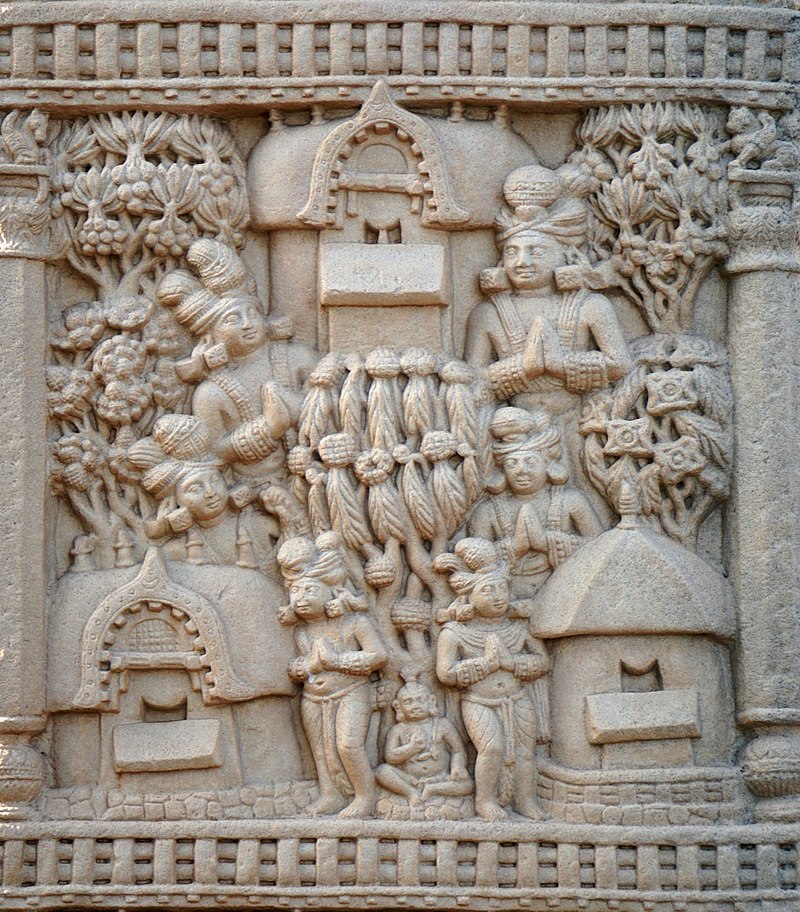
For example, above we can see three of the preferred residences of Buddha in Jetavana, one of the most famous Buddhist vihāras. Other ways of representing Buddha were an empty Lotus Throne, or a footstool under a throne, or the Bodhi Tree under which Buddha found enlightenment.
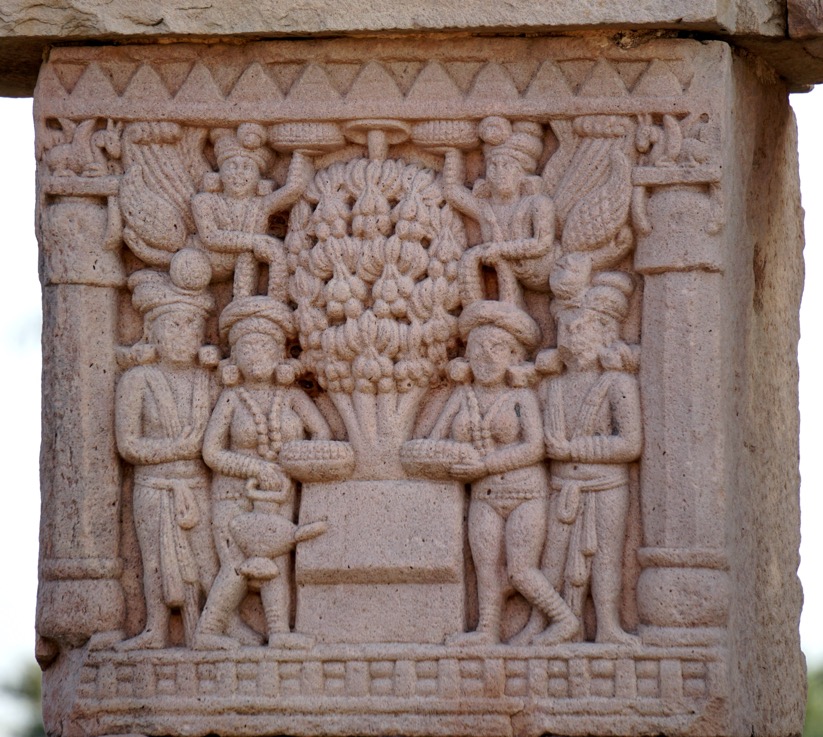
Above we have an example of a panel showing people and gods worshipping a Bodhi Tree decorated with flowers and flags. The tree provides shelter, shade, and fruit (it's a type of fig tree), and is a symbolic representation of Buddha (we can see that the Bodhi Tree has the umbrella above it).
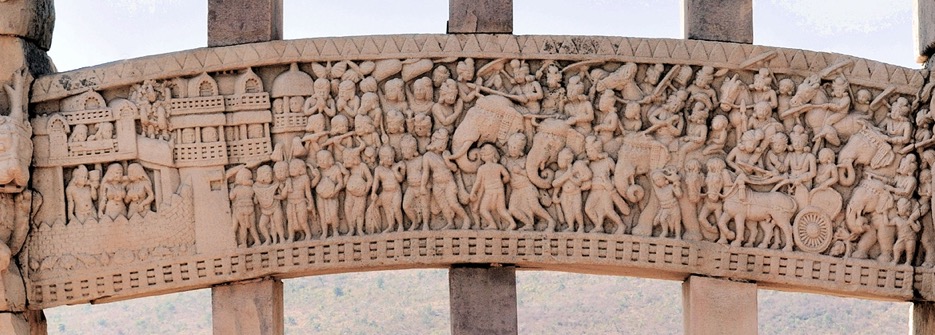
Above we have one of the interior panels of the western arch showing the seven clans or kings marching to Kushinagara, part of the so-called War of the Relics. The kings were demanding a share of Buddha's relics, and fortunately good sense prevailed and the battle never took place. The relics were divided equally between the eight kings. Below we have the siege at Kushinagara, and to the left and right we have the victorious kings departing with the relics born on the heads of the elephants.

Kushinagara was a small city, but it once had been the royal city of Kusāvati. Buddha died there and was cremated, making the city one of the four holy places fit for the pilgrimage of the pious.

Above we can see the eastern gate of the Great Stūpa as it was originally found, and below we can see it today.

The eastern gate was the first one built, and it has panels depicting the the life of Buddha. In addition there are animals, Yakshi figures and other symbols of the Buddhist faith.
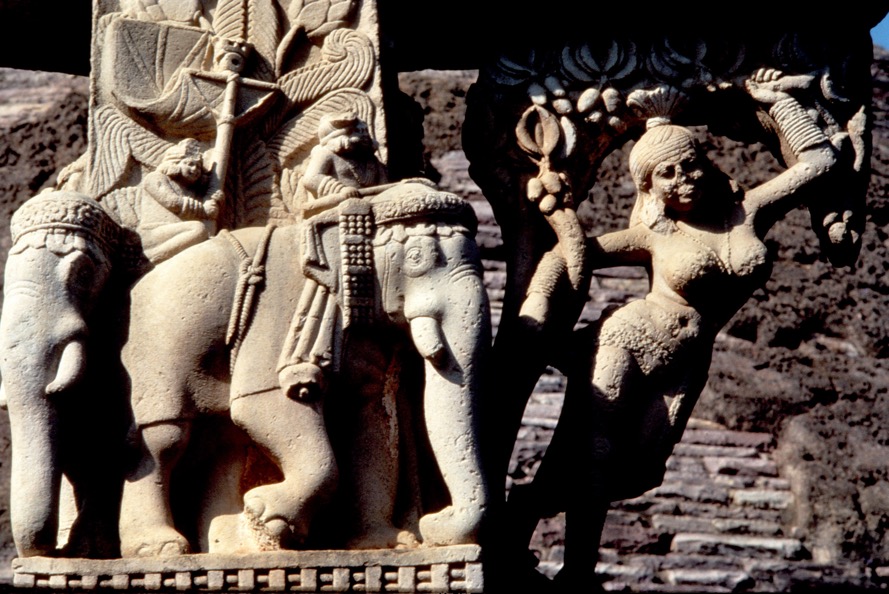
Above we can see a detail from the eastern gate. We can see a female Yakshi figure presented as a young girl with her foot on a tree truck and holding a branch in her hands. In this context she represents fertility, and yet she is also a protector or gatekeeper of the temple.
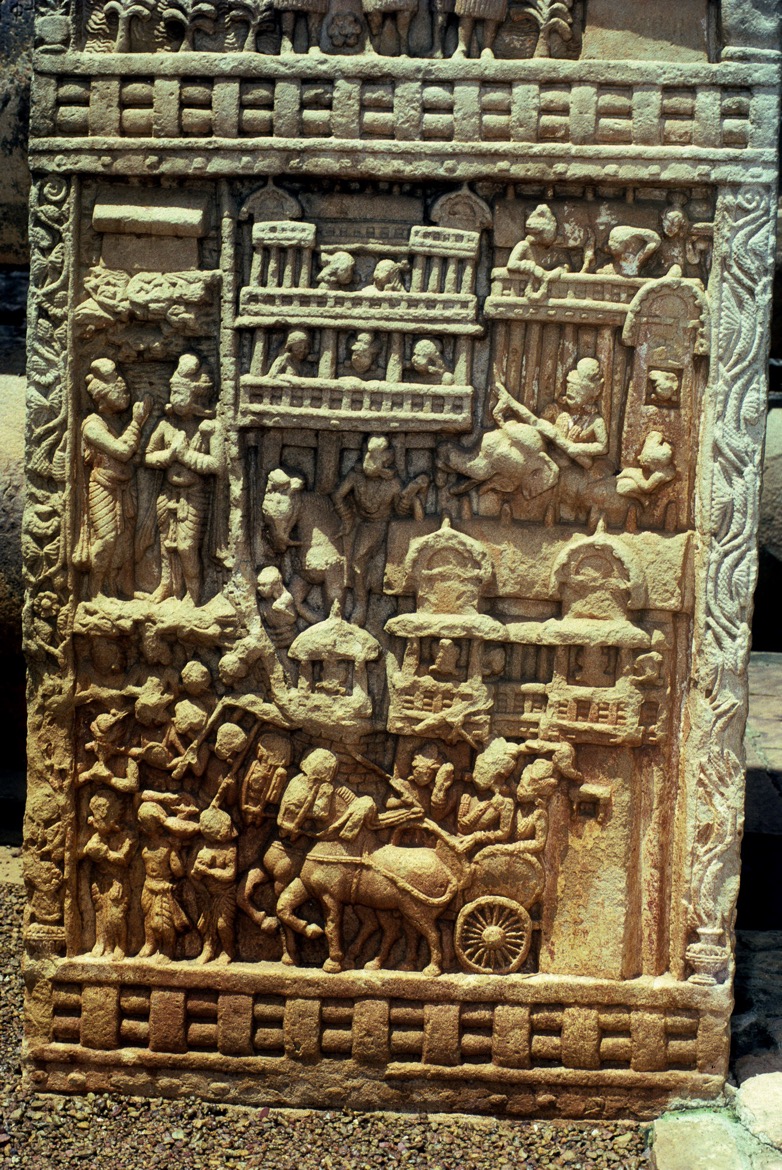
In addition to scenes of religious significance there are also scenes of everyday life. The one about is a city scene which provides information about the life of people of that period, their costumes, hairstyles, houses, forms of transport (e.g. the elite rode on elephants), occupations, trees and plants, etc.
The site is also home to other smaller stūpas, usually with just one gateway. There are also the remains of a number of temples and columns of various ages.
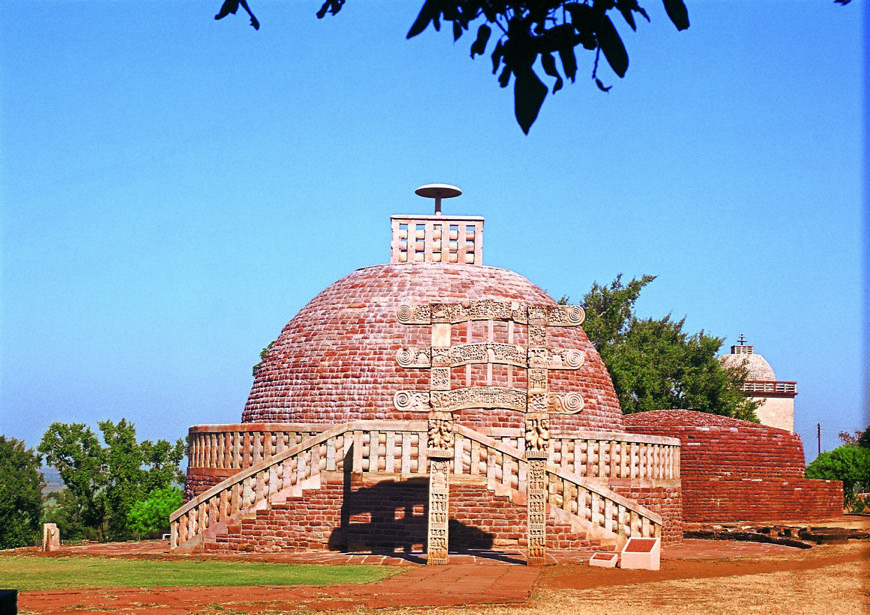
For example, above we see stūpa no.3 which is a solid hemispherical building which would have had three railings, like the Great Stūpa. Each railing had it significance, the ground railing symbolised the Earth, the second Space, and the top railing Heaven.
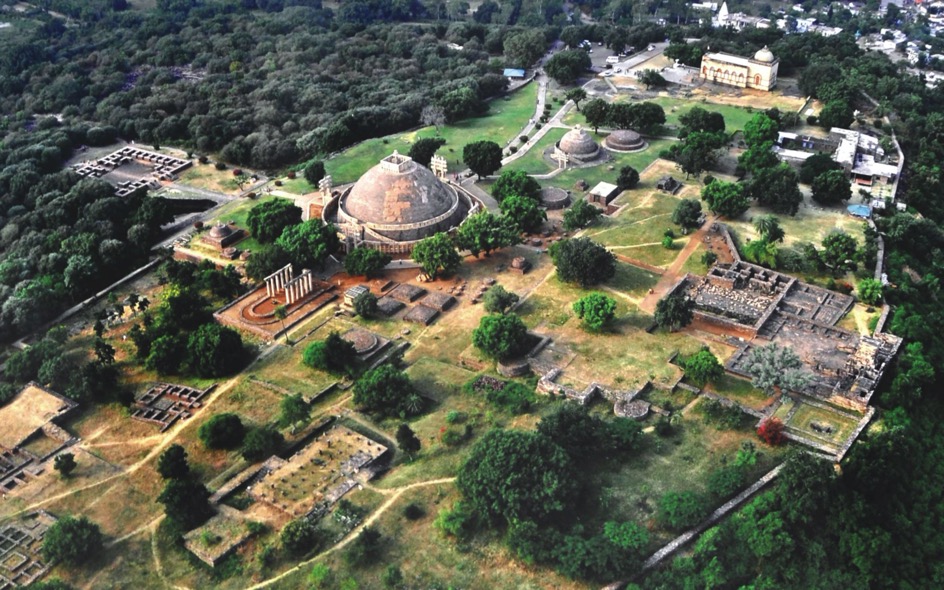
We close our visit to Sanchi with a view of the modern site, and for those who are interested I can't recommend enough the booklet 'Resurgence from Ruins, the Sanchee Saga', from the Archaeological Survey of India.
However before we move on, it's interesting to dig a little further concerning one minor point I mentioned above, and that is the plaster castings of the eastern gate. The Nawab of Bhopal once noted, with a touch of surprise, the interest that Europeans had concerning the sculptures and statues at Sanchi. In fact both the French and English (surprise, surprise) asked to take away the eastern gateway and display it in their respective museums. Fortunately they were both satisfied with carefully prepared plaster-casts, and the original remained on site. Often the fates of the Amaravati Stūpa and the Sanchi Great Stūpa are confronted and compared. Both were built ca. 250 BC, but the Amaravati Stūpa was re-discovered first. It was initially found by a local nobleman who was looking for some building material. It was in 1797 that a Colin Mackenzie visited the Amaravati site, but when he returned in 1816 indiscriminate excavations had almost completely destroyed the site. He made some drawing, etc. that were never published. In 1845 the Amaravati site was explored by Walter Elliot, who took 120 sculptured panels back to Madras, before exporting them to London in 1859 (they are know known as the Elliot Marbles in the British Museum). It is said that Elliot clearly realised that Amaravati was one of the largest and most impressive Buddhist stūpas ever built. But this did not stop sculptured slabs being removed and taken back to Europe, even if some archaeologists argued for making plaster-casts and leaving the originals in place. Below we can see one of the sculptured slabs shown the Amaravati stūpa which no longer exists.

On the other hand when Sanchi was re-discovered in 1812-1818 three of the four gateways were still standing, and the fourth (the western gate) was just lying where it had fallen.
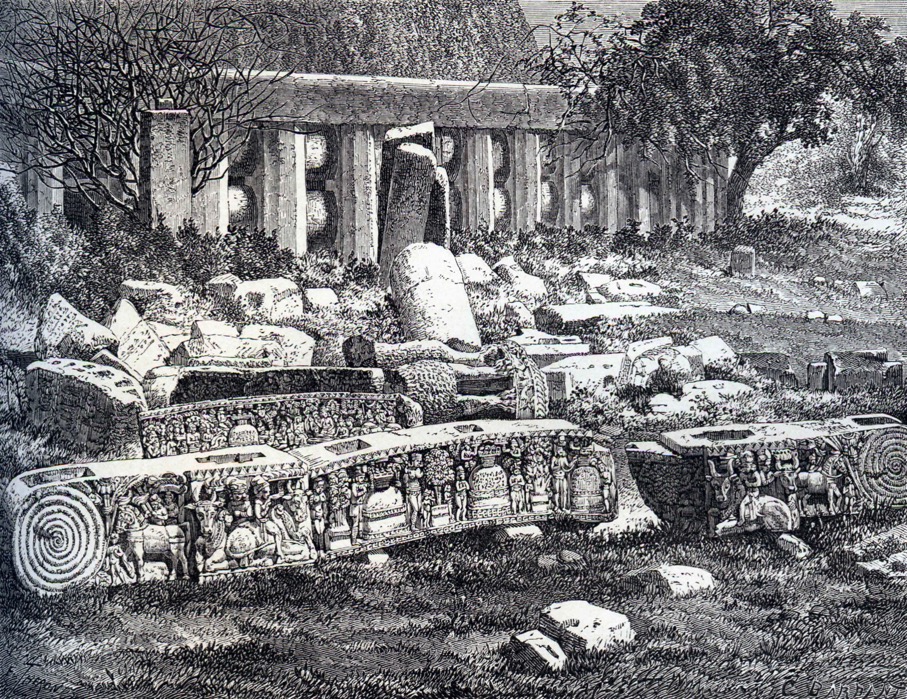
Fortunately the local rulers of the region provided money to preserve the site. They funded one of India's earliest site museums, a guesthouse, and even the publication of 'A Guide to Sanchi' by John Marshall. All the movable sculptures, inscriptions and architectural fragments were collected, arranged, and catalogued. Below is a photograph of the Great Stūpa from John Marshall's album taken in 1913-1914.
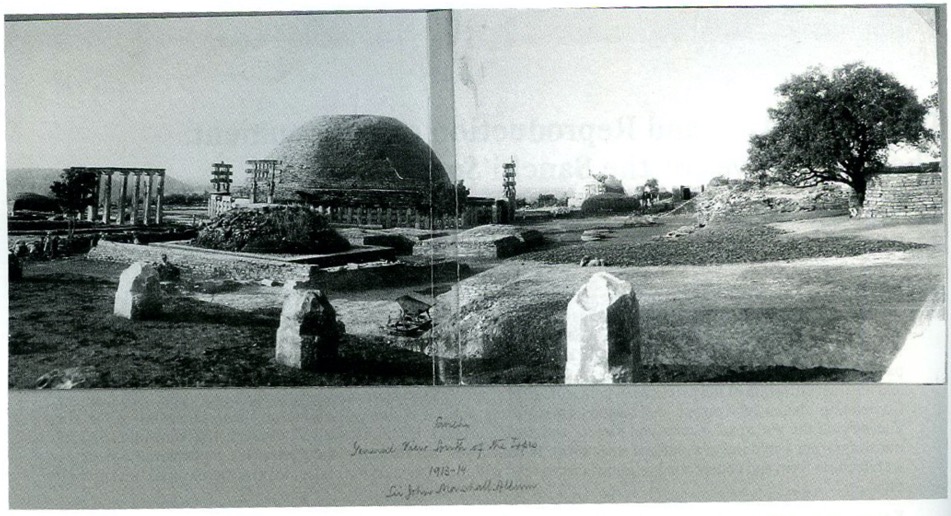
Firstly, Sanchi was lucky that it did not suffer a large-scale removal of its sculptured stones and railing pillars, etc. Bharhut and Amaravati were not so lucky. Because the Great Stūpa and one of the smaller stūpas were found 'perfectly preserved' archaeologists of the period were driven to 'opening them up'. It was already in 1822 that a first attempt at breaching the dome of stūpa no.2 failed to find anything of value. In 1851 they tried again and finally found a small box of white sandstone, about 28 cm by 24 cm by 24 cm. It contained four small caskets of stéatite (soapstone), each contain bone fragments. On the side of the box were inscribed the names of two Buddhist teachers. Each of the small caskets also had ten names inscribed on them, all Buddhist saints or teachers. In stūpa no.3 they also found the funerary relics of two of Buddha's former disciples, Sariputra and Maudgalyayana. As you might have guessed they also breached Great Stūpa, but they did not find anything.
The structural breaches were not repaired, and this is an example of how archaeologists increasingly focussed at that time on excavating to find material remains rather than preserving what was there and creating textual records of India's lost history. So throughout the 19th C there was an urge to dig, break open, and collect, set against a will to visually document and preserve what was seen and unearthed. Sanchi was drawn and copied extensively, and yet it also suffered the classical problem of archaeology, 'destruction through excavation'. As the world moved through the 19th C printing technologies such as engraving and lithography opened up a range of new reproduction possibilities, which then fed into the production of the first photographic images of ancient structures. One of the gateways at Sanchi was photographed in 1848, and this launched a new global career for Sanchi. Photographs and the plaster casts of Indian architecture and sculpture were shown at the Paris International Exhibition of 1867. It was only in 1858 that the Amaravati Marbles were re-discovered in a London warehouse, and a photographic campaign launched in 1866-67. A few of the marbles also found their way to the Paris exhibition. Over the years there had been an on-going battle between those who wanted to remove the Sanchi gates to the British Museum for their safekeeping, and those who felt that doing so would be an act of vandalism. The idea was naturally framed as an 'invitation' for the ruler of Bhopal to 'gift' one of the gates to Queen Victoria. What stalled the idea was the simple fact that at that time no one knew how to dismantle and ship so many tonnes of stone without destroying the structure and it's carvings. Later the French Consul in India requested a 'gift' of a gateway for Emperor Napoleon III, who wanted to have them installed for the 1867 Paris exhibition. The answer of the Begum of Bhopal was that the British had first claim to a gateway. But by then the wind had changed, and the British colonial authorities most forcefully turned down the offer.
At the Paris exhibition a pan-European imperial monarchical convention was signed with fifteen reigning princes. The object was to promote the reproduction (casting, electrotypes, and photographs) of art and architectural works from all over the world for museums in Europe. Reproduction technologies were seen as now being able to do their job without the slightest damage to the originals.
The British had decided to making a casting of the eastern gateway for installation in an Architectural Court in the South Kensington Museum. The museum had started to develop the idea of a series of monumental Architectural Courts housing copies of famous objects such as Trajan's Column from Rome and Michelangelo's David from Florence. So a cargo of 28 tonnes of plaster and gelatine was sent to India along with 88 special boxes lined in tin. Originally the idea was to make three casts, one each for London, Paris and Berlin, but finally it took them four months to make just one complete 'parent' cast. Back in the South Kensington Museum copes were made for Paris and Berlin. Below we can see the casting operation of some carved pillars at the Qutb mosque in Delhi. The idea was that castings, drawings and photographs together would make up an ensemble of ordered knowledge of Indian art and architecture.

South Kensington looked to differentiate itself from the stuffy British Museum by presenting a uniquely modern world-view, that of a Victorian 'imperial archive'. The original Indian Court was organised by the East India Company, still effective rulers of India, and it included gold and silver trappings given to Queen Victoria and displayed on a stuffed elephant. Later the collections would be re-arranged into the Oriental Courts demonstrating how Indian, Japanese and Islamic decoration could inspire British design. The next major development was the Architectural Courts, and in particular a display of a plaster cast of Trajan's Column. About the same time Queen Victoria was 'crowned' Empress of India, and a large part of the Eastern Court was dedicated to Indian architecture and sculpture, including the cast of the eastern gateway of the Great Stūpa. With copies also being exhibited in Berlin and Paris, the gateway became a recognisable symbol of Indian art.
We should not forget that photographing the monuments at Sanchi was part of a larger effort to photograph all historic sites and structures in India, and was just one element in an all-out commitment to in situ conservation and a resistance to the removal of any objects and structures from a site. What's more, photographing historic sites was just one task, and the British also photographed local royalty, state ceremonies, official events, landscapes and architectural views, etc. In particular at Sanchi the photographers recorded also all the stages in the repairs and restorations, including the clearing of the jungle, the assemblage of the smaller pillars, the rebuilding of the gateways, and the repairs to the stūpa dome. Below we have the reconstructed southern gateway at Sanchi.
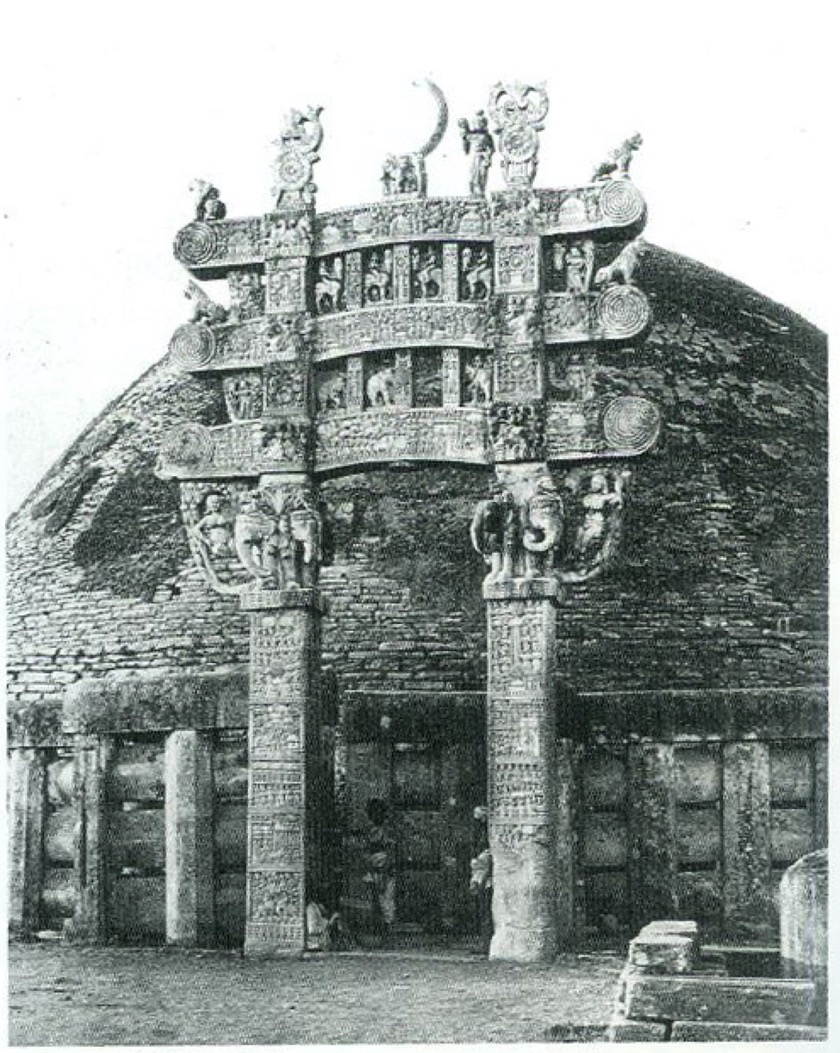
It was in the period 1899-1905 that the Sanchi site was cleared, excavated and restored, rescuing it from decay and vandalism. But this was not the end of the story.
In 1919-20 the Bhopal Durbar asked for the reliquary caskets found at Sanchi, and on show in London, to be returned. Sanchi had also been re-sanctified by the newly forged international Buddhist community. Initially this was refused, but later it was conceded that the bone fragments could be retuned to the Maha Bodhi Society. After WW II and with India's independence some relics were returned, but not those of the Great Stūpa.
Over time Sanchi not only became a major tourist site, but it also acted as an architectural prototype. The Rashtrapati Bhavan in New Delhi (official residence of the President of India) was built with a Sanchi-style dome and balustrade, and the lion capital became the state emblem of the Republic of India. Using Sanchi inspired architecture allowed India to steer clear of the need to decide between Hindu and Islamic religious symbols and architecture. And today there is even a full-sized copy of the Great Stūpa in Luoyang in China.

One of the things I noticed throughout the above presentation on the Great Stūpa is the difficultly to perceive the true size of the monument. I've added above one of the few photographs of the eastern gateway that illustrates the true size of the gateway and the Great Stūpa (just look at the figures on the scaffolding).
You can check out these video resources, Great Stupa and Great Stupa.
Sanchi - Temple 45
Above I have looked at the Great Stūpa at Sanchi, but it must be said that the site is home to an impressive variety of buildings constructed over more than one thousand years. Below we have what looks to be another example of the original site map of John Marshall, but the colours help identify the different periods in which the different constructions took place.

I was interested in trying to figure out how we went from the architecture of Early Buddhist monasteries in India to present-day Buddhist monasteries in Thailand. In doing so I came across, quite by accident, the dissertation of Fiona Buckee on reconstructing a temple spire on the Sanchi site. As we can see on the above map, Temple 45 was built in the period between the mid-9th C AD and the beginning of the 10th C AD.
Our thesis author tells us that Indian temple types are distinguished by the shape of their spires. And the spire of Temple 45 is called a 'Latina' because it has a smoothly curving 'spire' with quadrangular plains. It would appear that the each face is made up of layers of interlocking stylised gables and dormer windows which apparently creep horizontally and vertically across each face.
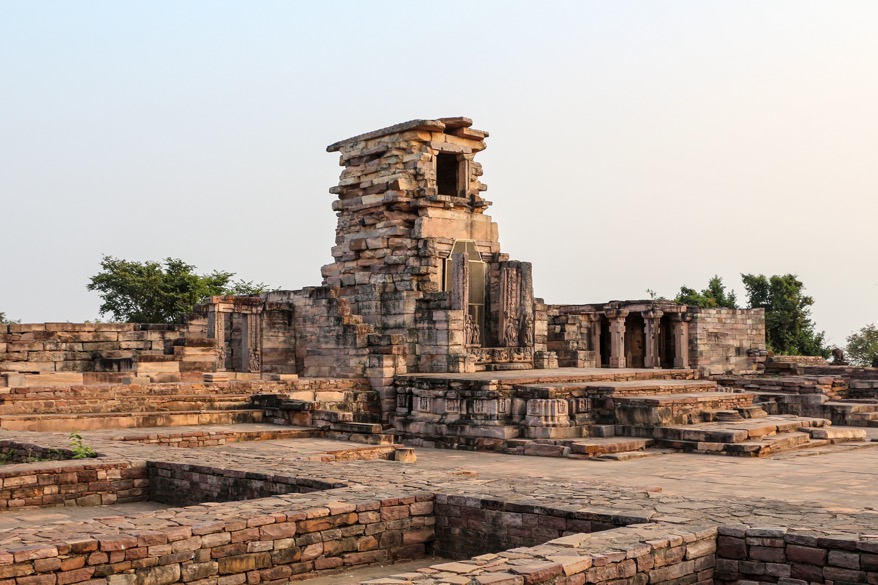
The most important point of the thesis was the fact that Temple 45 no longer has its spire, and above we have a photograph of what's left of Temple 45. The topic of the thesis was to (virtually) reconstruct what the spire might have looked like by using the existing building, adding the rules of architecture at the time, and integrating a neat pile of 500 pieces of stone that had fallen from the original spire.
The Wikipedia article on Sanchi tells us that the site is home to the "probably the best preserved group of Buddhist monuments in India". In looking at the Great Stūpa we have touched upon a few elements of religious architecture of the Maurya Empire (323-184 BC), the Shunga Empire (185-75 BC), and the Satavahana Dynasty (ruled to the early 3rd C AD) who were responsible for the decorated gateways. As far as I can see the Western Satraps (35-405 AD) were in control of Sanchi from the mid-3rd C AD and were replaced by the Guptas ca. 412-413 AD. The Guptas were a Hindu dynasty, but Buddhism and Jainism were also encouraged, and Sanchi remained a Buddhist site.
Alongside the building of stūpas and monasteries (vihāras), Buddhists also built temples (chāityas). There are remnants of brick-and-stone structures that could have been temples, and date from as early as the 3rd C BC. An oval, brick temple plan has been dated to the 2nd C BC. However the oldest surviving complete temple or shrine is a small building on the Sanchi site, Temple 17 (which is quite near the Great Stūpa). This temple dates from the early 5th C AD, and the argument goes that earlier temples were either made of perishable materials or were rock-cut cave temples. The tradition of temple building in India can be traced to the Gupta period (3rd C to 6th C AD). It is also suggested that many of the elements in this simple temple would go on to be incorporated into Hindu temple architecture. The structure consists of a square, flat-roofed sanctum with a porch that has four pillars. The interior and exterior were undecorated, but the pillars were carved with inverted lotuses, and the capitals were carved lions.
Early Buddhist buildings and sculptures were strongly focussed on the domed stūpa shrine, even if its' possible that in earlier Vedic times there were almost certainly some other types of temple building presented as a 'kings house'. However Early Buddhism was a protest against the rites celebrated by the Indo-Aryan kings. It was not until Mahāyāna Buddhism introduced the idea of Buddha as a king of the heavenly spheres that another form of shrine appeared in India. This was a building crowned by a curvilinear steeple (sikhara) that has been equated to both a 'mountain peak' and a high peaked crown (mūkuta). The sikhara became the distinctive mark of Mahāyānism, and so the distinction of Buddha as a king or as a teacher (guru) became fixed in Indian architecture. The idea of the perpendicular form of the sikhara has been related back to bamboo and thatched roof construction, and the top was seen to represent the straw cap covered by an inverted water-pot to make it all watertight. The thought is that in Gupta times the revival of Vedic traditions led master-builders to give a permanent form to the Mahāyānist spire. Later we would see that the form of the sikhara lent itself well for enshrining the image of Vishnu, for as Upholder of the Heavens he was always standing rigidly upright.
In the thesis the author outlines the idea that early temples (dwelling places for the gods) would have looked no different from those used by any villager or hermit. But what did these dwelling look like? Given that timber buildings, etc. have perished long ago, we can turn to narrative relief carvings from gateways and railings around stūpas. What they show is that the urban landscape was busy, and included "complex, multi-storeyed networks of palaces, apartments and gateways with plain, mud-brick lower storeys and timber upper storeys, fronted by wooden parapets and walkways… topped by barrel-vaulted roofs made of timber rafters and thatch". Below we have some examples, with a from Amaravati and c from Bharhut.

The idea is that the different architectural elements would have been extracted from the urban context to create simple timber and masonry shrines. The elements mentioned included horseshoe-arch gables, dormer windows, layered eaves for multi-storeyed buildings, and simple domed roofs from the more modest dwellings. Small stone shrines still exist, and below we have some basic examples on the left, and some Nāgara shrine forms on the right.
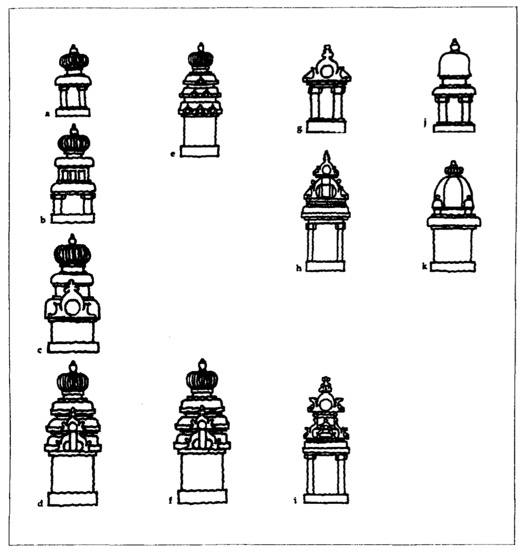
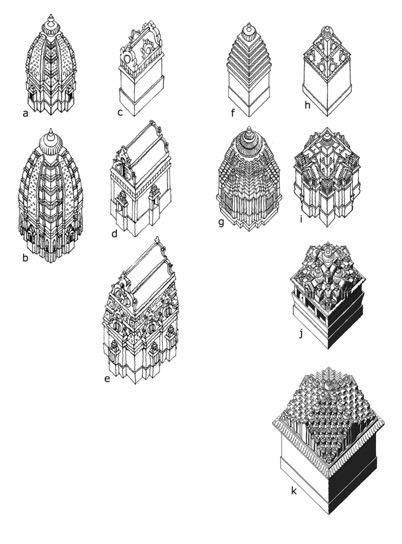
So the idea is that these modest little shrines provided the principle modules that were multiplied, recombined and transformed in to different monumental temples, starting in the 7th C AD. Just take a basic design component and proliferate it in all directions and then pile-up shrines one of top of the other to make a monumental temple. The examples below are for a Drāvida temple (left), Nāgara temple of the Sekharī mode (centre) and the Nāgara temple leading to the proto-Latina form (right). Very simply Drāvida represents South India and Nāgara North India.
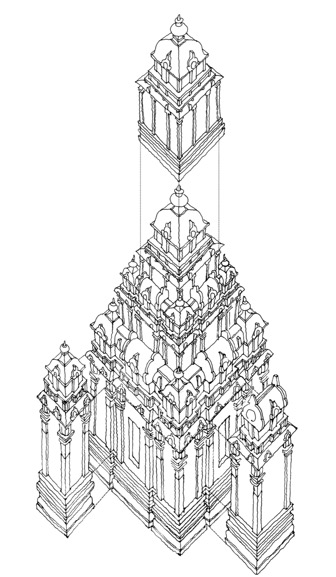
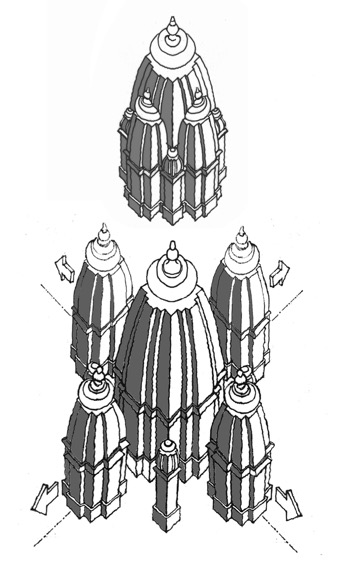

Trying to navigate a way through the gradual evolution of temple buildings in the period starting in the 7th C looks to be a minefield of different regional tendencies, trends, and styles, and is not the topic of this webpage since most appear to fall in the category of Hindu temples and not Buddhist temples. Dramatically over simplifying things the earlier mode was Nāgara temple architecture, but by the 7th C AD the transition process to the Latina design was completed, and for three centuries it would dominate Indian temple architecture. To get a better appreciation of this complex evolution, check out the article of Adam Hardy 'Indian Temple Typologies'.
My best try at isolating key features between the Drāvida temple and Nāgara temple is as follows. The Drāvida temple had a single pyramidical shaped central tower, but it could also have a monumental entrance tower (gopuram). The deities can be seen in the outside decoration. The Nāgara temple consists of a very prominent beehive shaped curvilinear tower (shikhara) sitting on a high pedestal. The decoration is made up of layers of architectural elements, but the deities can only be seen inside the temple. A temple site can be home to multiple towers.
Returning to the thesis, I found the development of the likely spire design on Sanchi Temple 45 quite impressive, but we can cut to the result (below).

At the end of this webpage we will look at free-standing temples in Indian, and at the gradual emergence of the tower-style temples.
Sanchi - the bigger picture
This section is perfectly optional, in that it does not address the simple question about the evolution of Buddhist architecture in India. What we are going to do here is delve a little deeper into how Buddhism impacted on the environment around Sanchi. Sanchi's earliest history was closely connected with the Mauryan Empire (323-184 BC), whose westward spread from its epicentre in the Gangetic valley was responsible in part for Buddhism's transformation from a regional cult into a pan-Indian and subsequently pan-Asian phenomenon. It was following Ashoka's (ca. 273-236 BC) conversion that Buddhism first appeared with it's stūpas and shrines, including as far afield as Sanchi. However, the reality is that it was only in the post-Mauryan period (ca. 2nd C BC and 1st C BC) that Buddhism really took root in the social landscape. This is evidenced by the epigraphical evidence at places such as Sanchi. We tend to focus on Sanchi, but during that period there were 35 other monastic sites built in the region around Sanchi. Inscriptions show that the building campaigns were no longer funded by state patronage, but by collective patronage from powerful families and guilds. The traditional viewpoint is that it was only in the 5th C AD that donations of land and villages would have allowed Buddhist monks to become major actors in local agricultural communities. The idea was that early inscriptions were of lay people acquiring religious merit rather than material gain. However it is impossible to image that more than 35 monastic sites in a small region around Sanchi just subsisted on gifts. Monks must have already been working with the local agricultural communities. Some experts see the Sanchi dams as being in part a response to the increased demands placed by the monasteries. Already in the 2nd C BC dams in Sri Lanka bear inscriptions linking them to monasteries. There was a form of 'monastic landlordism' where a local landowner would donate an irrigation work to the Buddhist community, which would subsequently be responsible for its management and profit control. Local farmers would be granted access in exchange for gifts of part of the resulting crops, which would then be shared between the Buddhist community and the original donor. In many of the rock-cut monasteries there are quite ostentatious displays of water harvesting, an act which was directly linked to the alleviation of suffering. What we also know is that from the Gupta period onward, there was a link between Brahmanical owned land and water resources, and that many later Hindu temples were built next to spillways and sluices.
Sanchi dams were earthen cores with stone facing mainly on the upstream side. Length varied from 80 to 1,400 metres, and from 1 to 6 metres high. The largest was estimated to hold nearly 5 million cubic-metres of water. The idea is that the dams near Sanchi were for up-stream irrigation, whereas to the East of Sanchi the dams included flood-control spillways and sluices for controlling down-stream irrigation. The Sanchi dams date from between 1st C BC to the 5th C AD, but one dam below Sanchi has been dated to the 3rd C or 2nd C BC. It's interesting to note that experts felt that the dams were not needed for growing wheat in the region, but they made sense for growing rice. So now the suggestion is that with the arrival of Buddhism came rice, firstly as a traded commodity and then as a local produced crop. The added nutritional value of rice compared to wheat, meant that the region could support additional settlements, including monastic settlements.
It is an important result to show that water management and patronage was a devolved system based on a network of local actors (including local buddhist monasteries) and not a centralised state controlled system.
Rock-cut monasteries and temples
In northwest India there are some foundations of vihāras, or monasteries, but the wooden superstructures have long disappeared. However it is with the rock-cut vihāras and chāityas (temples or prayer halls) that Buddhist architecture in India most strikingly expressed itself. When these rock-cut constructions were first discovered people thought they might be many 1,000's of years old. Only later, experts determined that they all dated from the period ca. 250 BC through to the 12th C AD.
Rock-hewn caves are particularly prevalent along the trade routes linking India with Central and East Asia, and they are virtually non-existent in South India and Southeast Asia. The basic idea is that in humid areas there was enough wood to build free-standing timber structures, whereas in hot and dry areas timber was rare and caves offered a better alternative, i.e. cool in summer and comfortable in winter. In most cases the rock-cut monasteries and temples were architecturally orthodox, with cave monasteries being quadrangles with cells surrounding a central hall, and pillars in later caves. Temples had a colonnaded apsidal plan with a stūpa at the back and the characteristic chāitya arched façade. The caves were essentially freestanding monasteries and temples, just cut into the rock. You might think that the work required to rock-cut a monastery might be substantial, but we must also think of the advantages. Rock-hewn caves were permanent, less prone to accidental damage or intentional destruction. They were easier to maintain, and provided excellent protection, security and safety (no fire risk). The first caves were built by order of Ashoka, and later on this webpage we will visit the Karla Caves. However, there are at least 1,000 hand-hewn caves in India, and about ¾ of them were cut in the period 200-750 AD along the trade routes across the Deccan Plateau. The first set of caves were built under royal patronage, and later caves were built by donations. Another way to look at Buddhist architecture is to view the period 200 BC to 300 AD as an anionic phase, and 400-570 AD as an iconic phase, i.e. before and after the use of the image of Buddha as a symbol.
The ancient town of Rajagriha (present Rajgir) was already in the 6th C BC the first capital of Magadha, a kingdom that would eventually evolve into the Maurya Empire of Ashoka. The town was surrounded by five hills, and they were dotted with numerous caves, the most famous being Son Bhandar and Saptaparni. I found this extensive description the most convincing.
It is said that Buddha meditated in the Son Bhandar Cave, which might suggest it could have existed as early as ca. 500 BC. Architecturally it is more likely to date from the 3rd C BC, but judged on the inscriptions found on the walls it could date from the 3rd C or 4th C AD.
It is also said that Buddha spent some time before his death in the Saptaparni Cave. And it is in this cave that the first Buddhist Council was held after Buddha died. It is there that it was decided to appoint Ānanda (Buddha's cousin) and Upāli to create an oral tradition of Buddha's teachings. Below we can see the cave entrance and the cave itself.
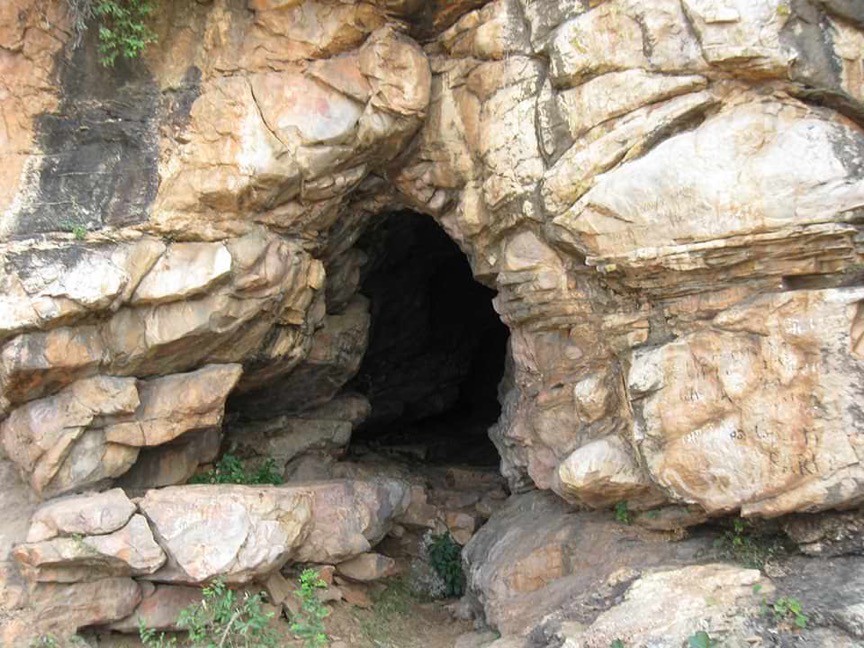
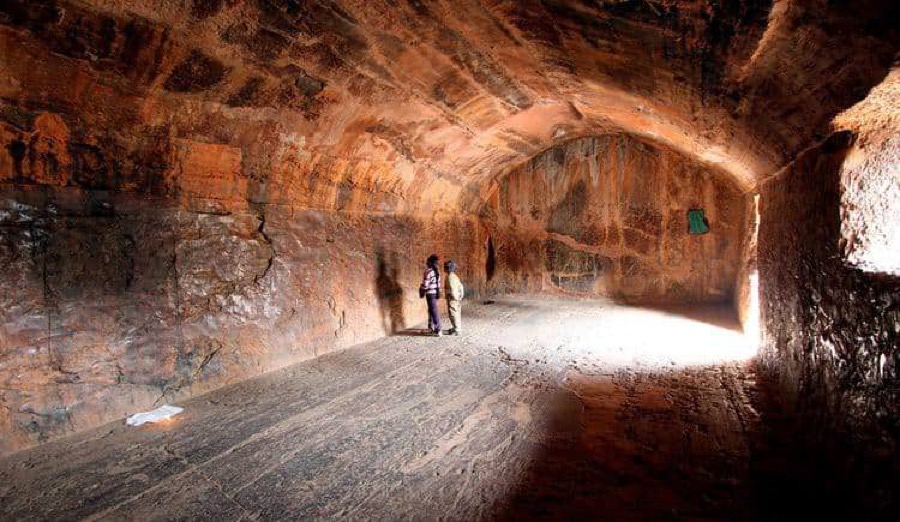
One source of complexity in understanding rock-cut caves in India is that caves were excavated by all three principle religions that prevailed in India at that time. The oldest and most extensive series of caves belong to the Buddhist religion, who for a long period were the only cave excavators. Then came the Brahmanical Caves, and finally the Jains who sought to rival the Brahmans in their rock-cut architecture. The oldest are certainly the simple cells excavated for Buddhist monks during the reign of Ashoka, although this type of excavation certainly continued until ca. 700 AD. The Brahmanical Caves overlap these by a 100 to 150 years, and some may have been excavated in the 10th C AD. Jaina cave excavations started about the same time as the Brahmanical Caves, but were continued through to the middle of the 15th C.
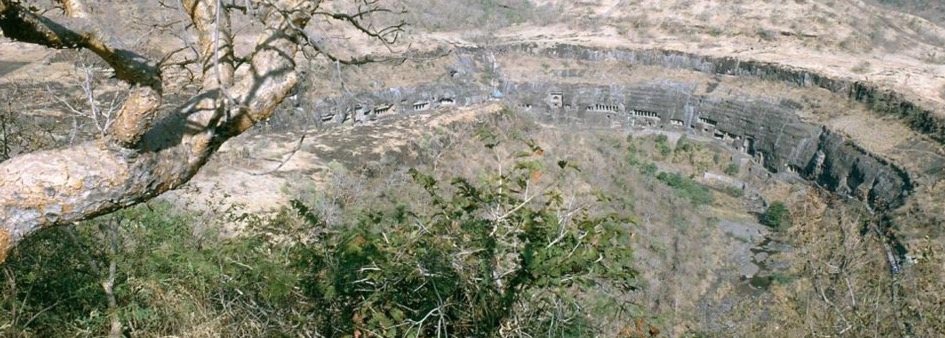
The above example is the Ajanta Cave complex, consisting of 30 caves excavated between the 2nd C BC and ca. 480 AD.
Below I'm going to try to collect together some of the architectural developments in Indian rock-cut monasteries and temples, at least for the Buddhist period. The problem is that the variety and time span is enormous, and I'm only going to pluck out a few examples. But we should keep in mind a few basic facts about the time span covered by Indian rock-cut caves. etc.
The first phase of Buddhist rock-cut architecture spanned a period from ca. 250 BC through to ca. 300 AD.
At least in western India there appeared to have been a rupture in building rock-cut temples between ca. 300 AD and ca. 450 AD.
The Dharmaguptaka sect continued to expand into China and East Asia during the period ca. 250 AD to ca. 470 AD.
Ca. 450 AD some rock-cut work did start again in Ajanta, Nasik, Ellora, Bagh, etc.
Ca. 460 AD to ca. 470 AD mass desertion happened, and some monks went to Bagh to continue their work.
Ca. 470 AD to ca. 480 AD work resumed, but many caves were not completed.
From ca. 480 AD to ca. 530 AD there was another rupture probably linked to the collapse of the Vākātaka Dynasty and the loss of patronage.
From ca. 480 AD the major Buddhist sects or schools re-emerged but with limited patronage, so cost-effectiveness became an important criteria. The focus turned to local rock quality, convenience, and local talent and human resources, so the emergence of regional motifs, styles, materials and themes. Buddha's image replaced the stūpa.
From ca. 530 AD to ca. 600 AD Shaivates started to take an interest in rock-cut caves (a major tradition within Hinduism that reveres Shiva). They built Elephanta 1, and several caves at Ellora. Later Lingam worship would pose new demands on the architecture.
From ca. 540 AD to ca. 600 AD Buddhists relaunched their work in the Aurangabad and Udayagiri caves.
From ca. 600 AD to ca. 700 AD work restarts in earnest at Ellora. Major changes include the conversion of residential caves into temples, the introduction of the quadrangular ambulatory, pyramidal ceilings, niches for Buddha, etc. The focus turned from monastic cells to an 'inner' circumambulation around a sanctum sanctorum, yet conserving also an 'external' circumambulation still within the prayer hall.
From ca. 700 AD Hinduism started to dominate western India, and it's possible that Buddhists were expelled from the Deccan, this time forever. Some Buddhist caves were converted into Hindu temples. Hindu and Jaina temples continued to be built at Ellora and elsewhere.
Buddhist monasticism was the earliest in history, and long antedates that of Christendom. The earliest of the rock-cut cells in India were excavated in ca. 250 BC. Many were just single cells, but the majority of vihāras were real monasteries, with groups of cells around a large central pillared chamber.
Buddha had conceived of the sangha as one monastic community of bhikkhus (monks) and bhikkhusīs (nuns), irrespective of regions, etc. However with the enormous increase in neophytes the sangha started to proliferate into various regional avasas (dwelling places) and aramas (enclosed parks). Wealthy people and royalty started to donate land for building these sangharamas. Buddha wanted to provide for a compulsory annual break so that monks and nuns could devote time for self-cultivation by introspection and confession, often called vassa or vassavasa. The vassavasa was first an improvised and temporary encampment in the countryside, but it came to known as an avasa. Initially vihāra was the name given to these huts in the countryside, but later the term would take on a different meaning. A vihāra could be occupied by a single monk or by a small group, in this case the parivena was the private space allocated to each monk. Furniture was very simple, a bed or a 'board to recline on', a 'spittoon', and a seat with jointed legs. The different spaces for each monk might be separated by wooden partitions. The avasa represented the unaided enterprise of the monks themselves in setting up an entire colony from scratch.
Donors would also provide private premises in urban locations, and they came to be known as aramas. Some monks preferred to stay in the forests, and they came to be known as Āraññakas (forest dwellers). The avasas and aramas were only supposed to be used in the three wet months, but they gradually became semi-permanent settlements. Over time the avasa started to go out of vogue as compared to the easier life in a arama. Of course the visit of a Master would sanctify a place making it all the more likely to become a permanent sangharama. Initially the temporary dwellings were just makeshift huts, but by the 4th C BC they had become permanent structures. Aramas were built to elaborate patterns, including an assembly hall (upatthana-sala), cells or allotted space for each monk (parivenas), store rooms (kotthakas), and monk's quarters (vihāra).
In the course of time vihāra took on a different meaning, i.e. monastery. Over time it appeared to be increasingly used to represent a building for a number of monks.
In parallel we have 'lena' meaning a place of shelter or a rock cave, but it is also used to group together five different kinds of dwellings, the guhā or cave (or brick hut), and four other structures, the vihāra, the addhayoga (a 'gold-coloured Bengal house' so a house with turned-up eaves like wings), the pāsāda (a long-storeyed mansion or possibly a terrace), and the hammiya (a pāsāda with an attic, or 'topped with a single chamber', or possibly a sacred top-chamber). By the 5th C AD, only the guhā and vihāra survived.
Buddhism in its early years was a 'religion of faith' in which a person was part of a single sangha or monastic community, but was required to strive all by themselves to attain nibbāna, i.e. the basis for an 'enlightened' vision of things as they really are. The underlying concept is one of putting out the fire by other means of extinction than by blowing (which tends to incite fire rather than extinguish it). Nibbāna is an ethical state and is not transcendental, and it is achieved through the Noble Eightfold Way. This is a condition of indifference towards everything worldly, e.g. lust, hatred, and illusion (or delusion), and it can only be achieved from within (in one's heart) and through practical habits. So it is not a product of speculative thought. Using the metaphor of fire, it is not putting the fire out, but the fire simply going out from the lack of fuel. Conceptually we must remember that a fire that has simply gone out from the lack of fuel goes nowhere. Lot's of expressions such as freedom of spirit and peace of soul come to mind.
In the end, and in its own good time, nibbāna may lead to freedom from rebirth altogether, and thus to certain and final extinction (parinibbāna). This is a final release from rebirth, after the last life-span of an Arahant. Samsāra is the cycle of rebirth, but literally means 'perpetual wandering' or 'continuous flowing', or 'cycle of existences', and where the type of rebirth is determined by the person's karma. Arahant means 'killer of enemies' where the enemies are worldly impurities, and it is the negation of 'to be born'.
The various schools of Buddhism understand Nirvāna in different ways, but all agree that it is not a place. Buddha said that it cannot be described because it is beyond our existence, and it can only be experienced.
Early Buddhist texts can also be interpreted in a way that might suggest a 'Saviour' in the sense that bhakti suggests that selfless devotion leads to self-realisation. Initially as a 'religion of faith', faith was formulated in visual forms that were both aniconic and highly symbolic. For example the wheel emerged as a dynamic symbol of 'dhamma being set in motion'. Dhamma was seen a doctrine that taught the principles of behaviour that people ought to follow so as to fit in with the right natural order of things. The idea of the wheel would appear to have been adopted from Upanishadic tradition where dhamma is a continuous process of spiritual advancement. Buddha accepted that the laity would honour or even worship (puja) his stūpa, but he prohibited it for monks and nuns. A stūpa was originally a burial mould containing ashes, and then became a structure containing Buddha's remains. However quite early on the stūpa emerged as a venerable symbol, and grew to be worshipped. Later, image-worship became more comprehensive and included monks as well as the laity. The aniconic representation of Buddha was replaced by the anthropomorphic form of not only Buddha but innumerable other deities.
Originally caitya (or cetiya in Pāli) referred to a site or sanctuary for performing a sacrifice, so a 'devotional place' or even a sacred monument. Later it became an altar or even a prayer hall (caitya-grha), and in many texts it is presented as the same as stūpa. In fact caitya can be generalised as any object of veneration, so it can take on many forms, such as a religious tree, tomb-stone or stone column. It can even mean a person worthy of veneration. A caitya-grha can mean a cave with a stūpa shrine, or a hall in a monastery (grha denotes a residence or building). Today the term chāitya is used to also denoted a shrine with a stūpa but it can more generally be used for a devotional place or temple.
Below we have a small cave from Lenyadri (check out this video). It consists of just two cells, together about 10 metres long and 3 metres wide. In front there is a verandah that at one time had five very simple pillars. The doorways into the cells are adorned with the usual horseshoe canopies, and it is quite possible that each cell might have been divided into two cells with a wooden fence.
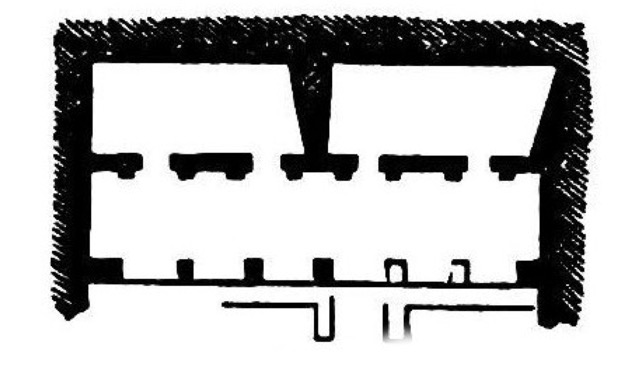
Before we move on to more complex rock-cut caves we should stress that what we are presenting are caves that were cut within what might be called a monastery complex. However there are also small rock-cut caves that have been dated to the Indian megalithic period (ca. 1500-500 BC) often cut into a rock face or floor, and equipped with port-holes and side-benches. It is thought that they might have been occupied by hermits possibly as early are 700 BC but could have been occupied through to ca. 200 AD. Below we have two examples of these very simple rock-cut caves.

The earliest vihāras (monasteries) were small and had no pillars in the hall. You can see the square pattern, and the principle ornaments was the chāitya-arch (like the one shown in the first photograph on this webpage), and possible a small stūpa. There was no shrine nor image of the Buddha in the early monasteries or temples.
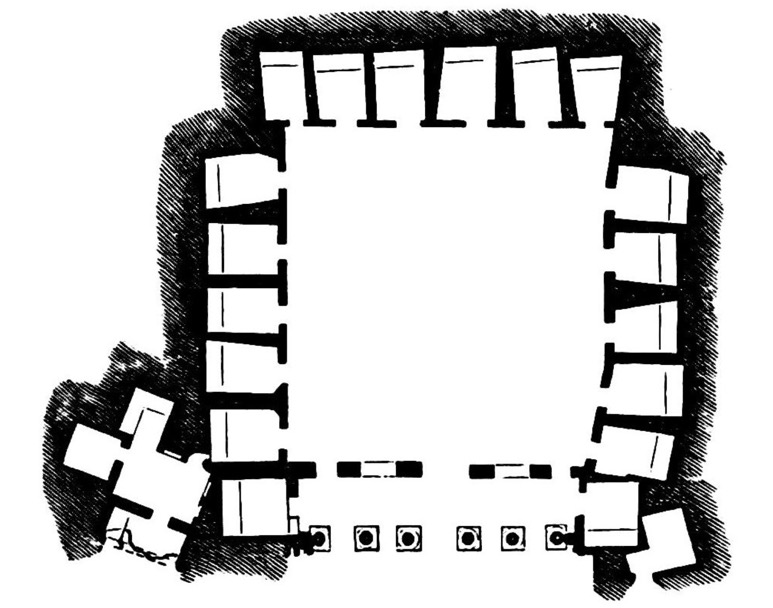
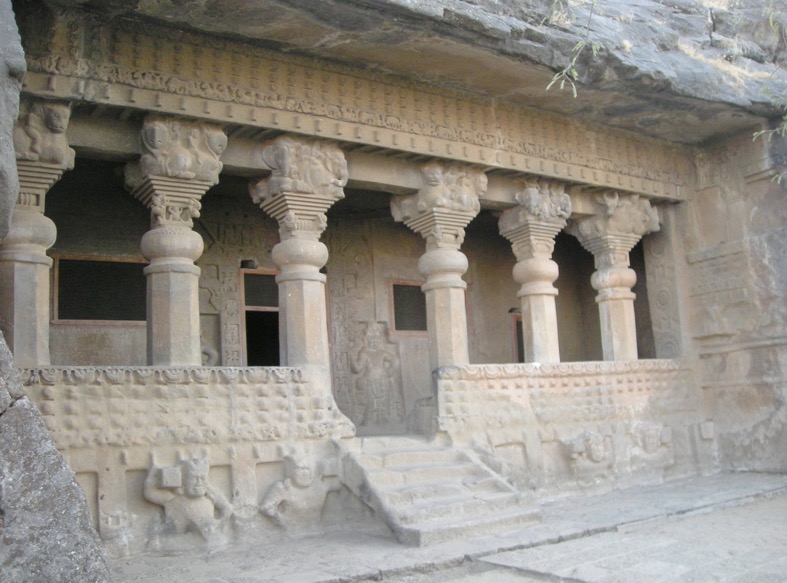
Above we have the Nasik Caves (video), the square hall measures about 13 metres square, and there are no pillars in the centre. You can see 16 small cells each with stone beds. At the front there is a 6 pillar verandah, with a cell at each end.

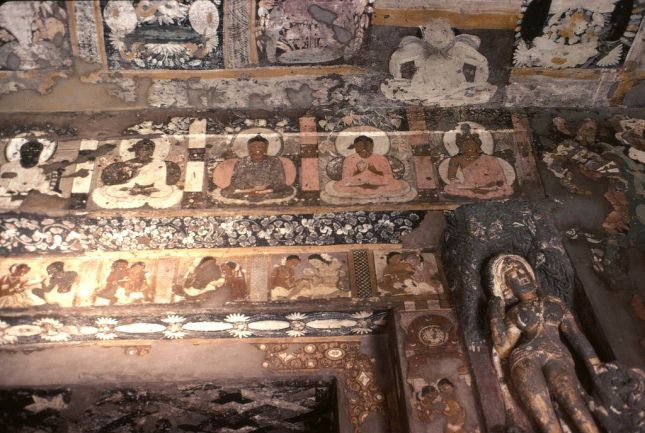
So it started with one cell, then came a long cell with a long verandah in front of it. However the most numerous form consisted of a hall with pillars in the centre, surrounded by cells for the monks. The example above is Cave 11 in Ajanta (video), and it has nine cells and no sanctuary or ritual arrangements, although we now see four pillars in the centre. It is thought that the earliest rock-cut monasteries such as the one above originally had no decoration or idols (but now it is decorated and home to a statue of Buddha).


Starting sometime around 100 AD a small chapel (chāitya) appeared always facing the principle entrance, and in it there would be an image of Buddha. In the caves which had no chāitya there was usually a stone altar (dagoba) in the centre, and at the far end a tomb containing a relic of Buddha or another respected figure (as far as I can tell dagoba is just another name for a stūpa but there could be subtle differences). It was at this time that the caves started to take on a variety of forms. Above we have the Darbar Cave which is more oblong than square. We can see a very small sanctuary centred in the back wall. In some other caves the sanctuary was projected forward and assisted, with pillars, to support the roof. Also the whole was often surrounded by an aisle or processional path separated by a range of pillars.
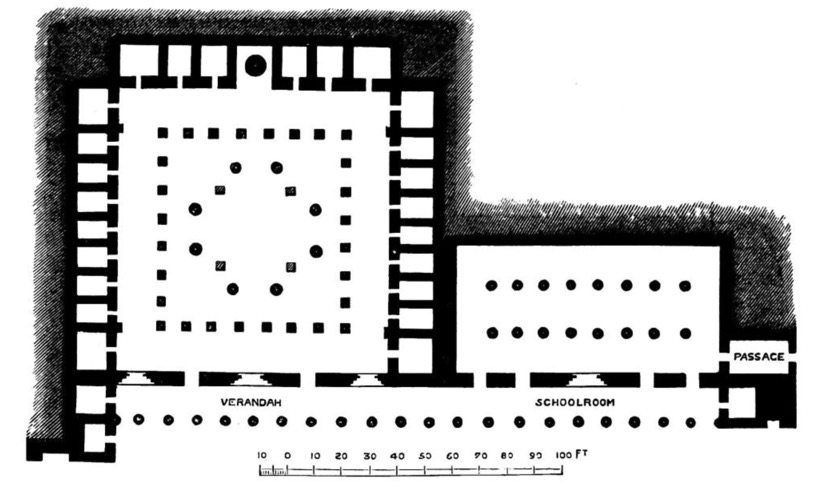

Above we have the Great Vihāra at Bagh (video) with a square great hall ca. 30 metres on each side. According to the experts an additional four square pillars were added later, possible due to structural considerations. There is a suggestion that the stūpa or dagoba once stood in the centre but was damaged when the roof collapsed, but that does not explain why there is a stūpa in the sanctuary. The roof is actually domed and supported by the eight round pillars in the centre. The second hall I think is called a shala, an oblong pavilion, and would have been a gathering place for students. The total length of the façade or verandah is 67 metres and is adorned by 23 free-standing pillars.
Alongside the evolution of the rock-hewn monasteries (vihāras) there was a parallel evolution of the rock-hewn temple (chāitya). The earliest type of chāitya was a rectangular hall with a semicircular apse at the back and no stūpa. The main feature would have been the horseshoe chāitya-arched façade or entrance, and the interior would have had a barrel-vaulted ceiling. Below we have the Lomas Rishi Cave dating from the ca. 257-250 BC.

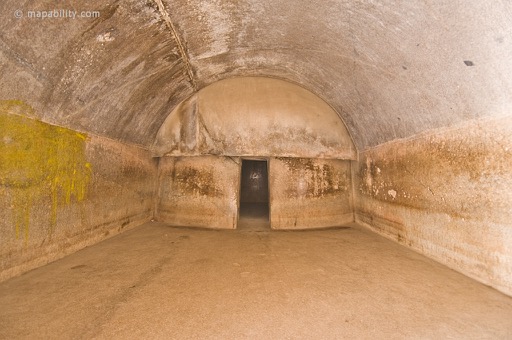
The next evolution would be more or less the same, but with an open front entrance and a stūpa at the back. Again the front would now be for a horseshoe caitya-arched façade set on columns. The Kondivite Cave 9 below (ca. 200 BC) is seen as a traditional design from the early Ashoka funded rock caves to the Deccan caves (see video).


The next evolution can be seen in the Cave 12 at Bhaja (ca. 175 BC) which dated from the end of the 2nd C BC and where the rectangular anti-chamber and circular chamber are fused together (see video). We now have the characteristic U-shaped apsidal plan, even if it still has wooden ribs for the barrel-vaulted ceiling. Also, copying the free-standing timber chāitya the stone columns still slope inwards, necessary to keep a free-standing roof in place. In later caves the ribs would be replaced by stone ones. The cave would have had a complete façade made of timber.
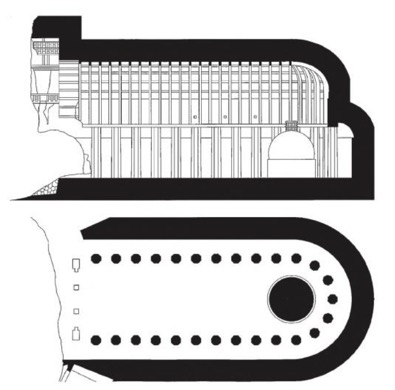
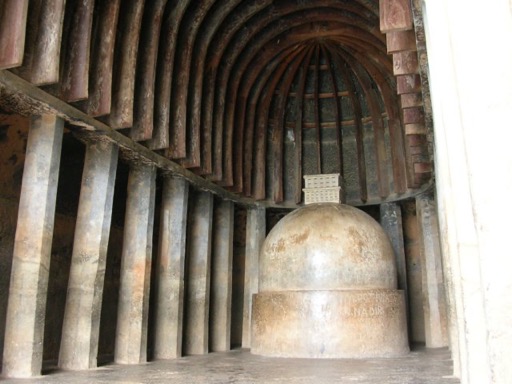
We can see above that the stūpa takes pride of place, due to the rise in popularity of its cult. You can see the stūpa has also an elongated drum body. The introduction of a continuous colonnade of stone columns imitates the original timber architecture, and provides a circumambulatory path around the stūpa. You can see by the simple octagonal columns that it is still an early version of a chāitya, but they are already increasing the scale and height of the cave.
The next evolution can be seen in Cave 19 in Bhaja (ca. 150-100 BC) which is a quadrangular vihāra plan with cells surrounding a central hall, built sometime between the late 3rd C BC and the 1st C AD (see this 4K video of a visit to the Bhaja Caves, and this video showing at visit to Cave 19 at 10:17). In one text it was noted that cells in the aniconic caves often had built-in stone beds and niches for the monks, whereas iconic caves did not. Aniconic caves also did not have interior columns, whereas iconic caves typically had columns. Remember aniconic caves pre-date iconic caves.

We can see that this example had a screen-wall and a verandah to block the monsoon rain, diffuse harsh tropical sunlight, and prevent outside intrusion. This particular cave was embellished with sculptures and murals, and had niches for statues.
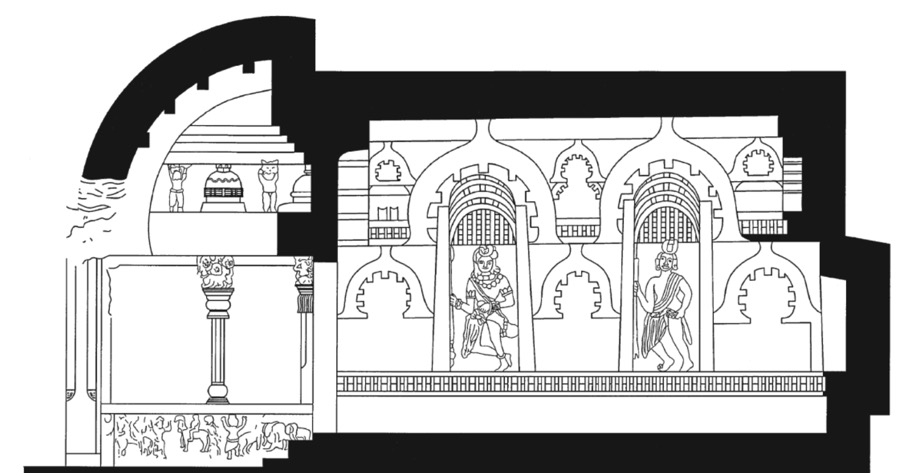
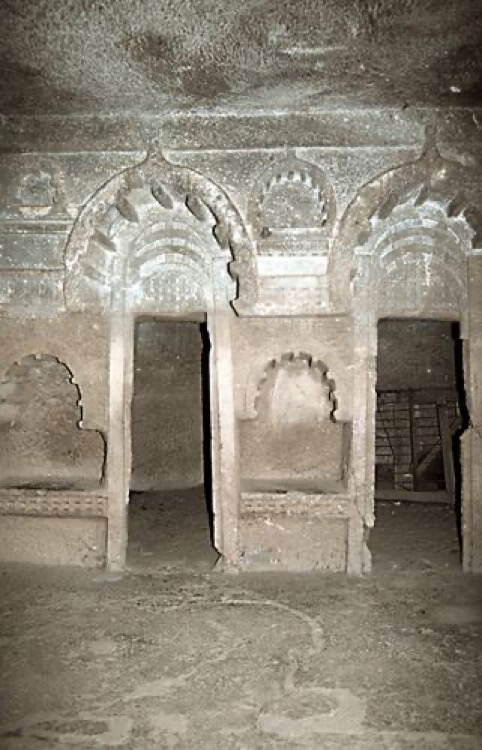
Initially we were looking at the gradual evolution of temples (chāitya), but here we have a dwelling for monks (a monastery or vihāra), so this cave is considered important because it represented the transition away from the plain single-celled dwellings. In addition there were large figural carvings inside, and new column orders. You can see the carvings and niches, with the elaborate caitya-arches. This particular verandah was home to three new column order, a square-and-chamfer, an octagonal double-pot on top and bottom with an animal capital, and finally a square-and-chamfered pilaster with a bell-shaped animal capital (pilasters only have a decorative function).
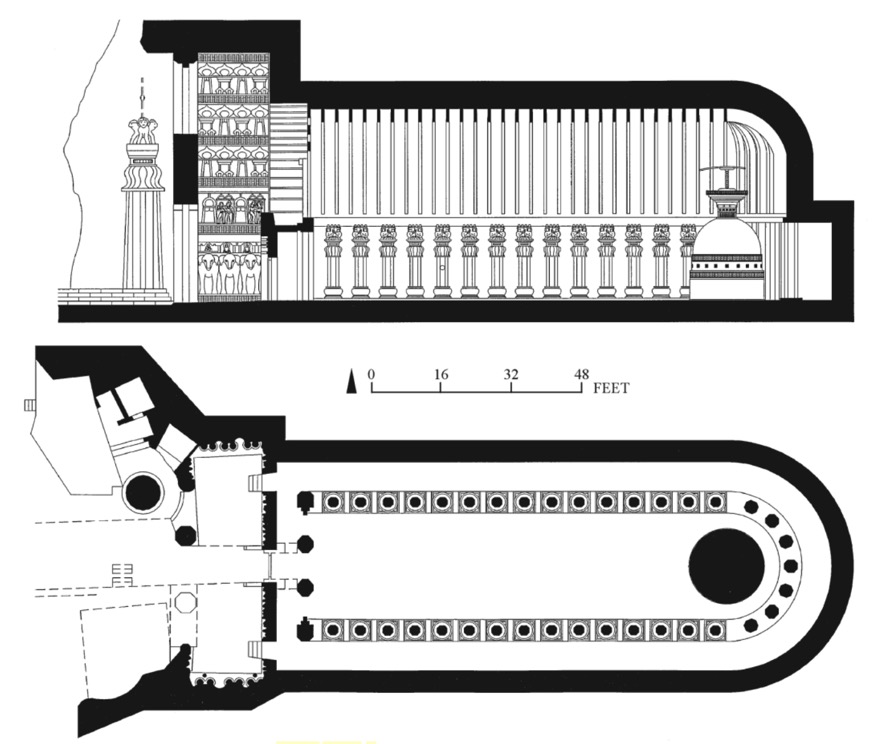
The next example above is Karla Cave 8 (built ca. 60-50 BC), which is one of the biggest rock-hewn caves in India and equally one of the most impressive (we will visit this cave in more detail later on this webpage, but have a look at this video). Karla Cave 8 is still one of those chāitya that has wooden ribs, which would be replaced in stone in later caves. Here we have again the use of the sturdy double-pot column on both sides of the nave, and around the apsidal end there are seven plain octagonal columns.
The last-but-one in this rapid review of early Indian cave-hewn temples and monasteries is Ajanta Cave 19 (ca. 500-525 AD). While Karla Cave 8 is considered the jewel among the Theravada caves, Ajanta is considered an example of the elegance and sophistication of Mahayana cave architecture (see video). The Ajanta site was developed over 800 years, and is home to a variety of different periods and styles, e.g. 24 caves out of 30 belong to the iconic Mahayana period.
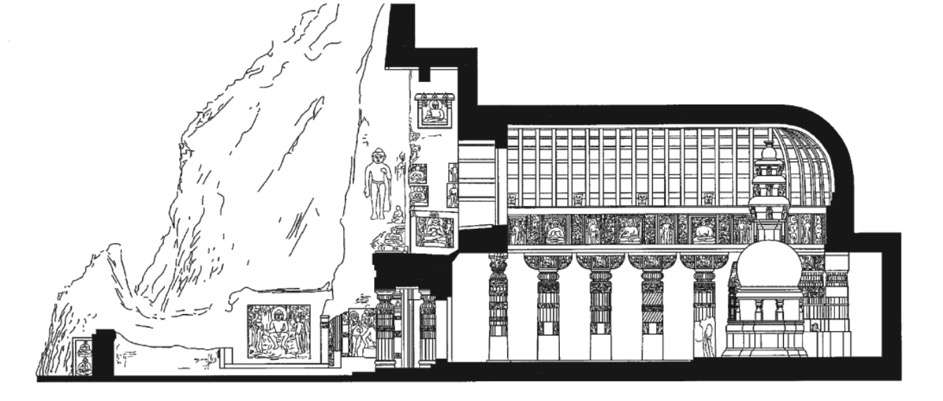
Cave 19 is the finest of the chāityas and is 14 metres deep, 7 metres wide and the columns are 3.5 metres high. At the front there is a standing Buddha, and the aisle walls and ceiling were once painted with murals. There is no verandah, which allows more direct sunlight to enter the cave. Compared to the austere simplicity of the earlier Theravada caves, the Mahayana decoration is quite sumptuous and every surface was covered with sculptures and murals.

The last vihāra we will visit is Cave 1 at Ajanta (ca. 500-525 AD). This is, like Cave 19, a completely stone cave, and it is one of the biggest in India. It is nearly square with about 20 metres on each side, and the ceiling is about 4 metres high. And there is a large squarish chapel at the back, approximately 6 metres on each side. So including the verandah the depth of the cave to the back of the chapel is nearly 35 metres. The stout columns are there to provide support for what is a very large space cut into the rock. Here is an excellent video on the Ajanta Caves.
Rock-cut Buddhist cave can also be found in Afghanistan (mid-3rd C to 7th C AD), in Turkistan (ca. 500-550 AD), in China (from ca. 5th C AD), and in Korea (ca. 700-900 AD). Cave 285 (ca. 525-539 AD) in the Mogao Cave complex is unique for the amalgamation of Indian, Central Asian and Chinese elements (see below and video).

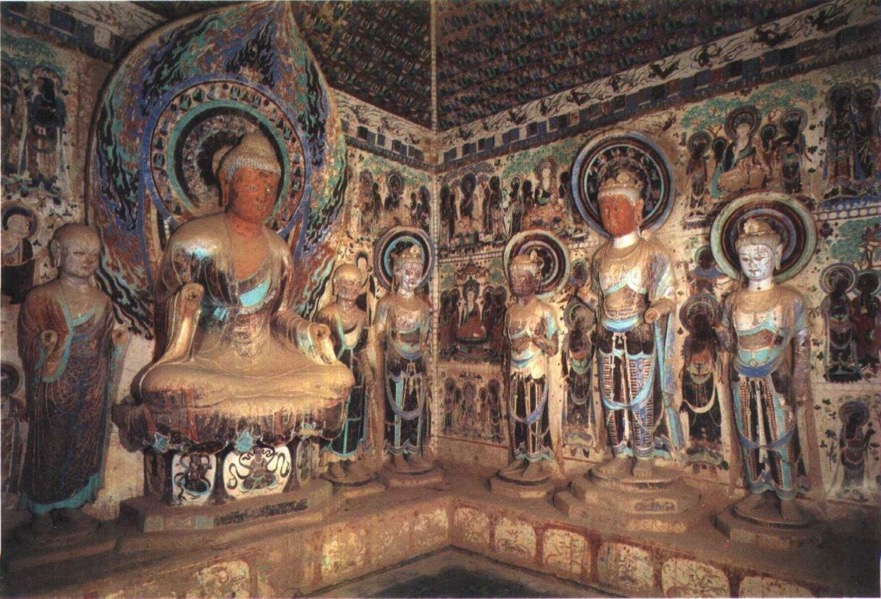
As we have seen above it is very difficult to place each and every rock-cut monastery (vihāra) and temple (chāitya) within a systematic classification. Below I have tried to summarise the approach taken in Rock-Cut Architecture of Western India, however the author has gone into considerably more detail.
Looking first at the lena (shelter or a rock cave) and vihāra (monastery) we can start with the simplest cells with either an open front or a front wall and doorway. Then there is the individual cell with a verandah and the individual cell with a hall and verandah (both with or without a bench). There are also individual cells that come with a hall and a recess, either with an open front or a verandah.
Then come the vihāras with multiple cells some with a verandah, some with a hall but no verandah. There are also those vihāras with cells, a hall and a verandah, and they can have cells only on one or two of the interior walls, or on all three interior walls.
Both the above types of vihāras are usually more or less quadrangular and flat-roofed. There are also rare types of vihāras which consist of cells around an apsidal hall and sometimes with a vaulted roof.
The other main type of rock-cut cave is the chāitya (temple) or caitya-grha with some kind of dome-shaped votive structure with or without a relic. We have seen that the simplest type is an oblong cell with a flat roof and a stūpa, and there is another type which houses the stūpa in a separate circular space with a domed roof. The vast majority of chāityas are apsidal with vaulted roofs, and either open fronts, stone screens, or stone screens and a verandah. Some of these types of chāityas can come attached to a variety of additional rooms including shelters for monks. The simpler and earlier versions just consisted of a stūpa placed in a flat-roofed oblong cave with or with a verandah.
Now there are vihāras integrated with a sanctum sanctorum or chāitya (temple), sometime known as 'lena-cetiyaghara' (a cave shelter with a stūpa hall). These are usually quadrangular and flat-roofed halls, have individual caves around three sides and in the side facing the entrance have a small chāitya (temple) space with a stūpa. These vihāras may or may not have a set of columns in the hall. There are also vihāras which are quadrangular and flat-roofed and have the sanctum sanctorum in the middle of the hall with an ambulatory path around it (with or without columns). Finally we should not forget that there are also water cisterns for drinking or bathing, and community halls (mandapa) with and without verandah's and benches. The mandapa can be a square or rectangular flat-roofed pavilion or even a porch and can serve for educational or recreational purposes or as an assembly and dining area.
The Karla Caves in Karli
James Fergusson wrote in 1891 "Karli… is the finest of all… is certainly the largest as well as the most complete chāitya cave… and was excavated at a time when the style was in its greatest purity… the pillars of the nave are quite perpendicular… the screen is ornamented with sculpture… the style had reached a perfection that was never afterwards surpassed".
The Wikipedia article on the Karla Caves in Karli is quite extensive, and it echos the conclusion that one of the caves, the 'Grand Chāitya' is the "largest and most completely preserved" chāitya hall of the period. It is generally stated that excavations occurred between 2nd C BC and 5th C AD, and carbon-14 dating, inscriptions and architectural style suggest that the oldest cave could date from ca. 120 BC. There is an inscription in Cave 8, the 'Grand Chāitya', that places its excavation in 137 AD (although other inscriptions suggest that many decorating elements date from a later period). More generally, some elements within the Karla Caves complex date from an even later period, 500-1000 AD. The earlier parts were created by Theravada Buddhists, who did not use the image of the Buddha, and the 'Grand Chāitya' stands out as one of the biggest and yet also one of the most refined of all aniconic Theravada caves. Experts suggest that the same style of cave continued to be excavated but none attained the same quality as Cave 8. In the 5th C AD Mahayana Buddhists developed a more opulent iconic style, and added the statues of Buddha.
At the time the Karla Caves were excavated ancient trade routes linked the Arabian Sea with both North and South India. Buddhists were known to be successful manufacturers and traders and many of their temples appeared along these trade routes. The temples were usually situated away from cities but not too far from inhabited places, and often they provided simple lodgings for travelling traders. They were cool and dry in summer, and pleasant in winter. Cave temples were also safe places, and it is said that they even served as early banks.
As in medieval Christendom temples (chāityas) were adjacent to the monasteries. Also they were designed with a high arched nave, lower side aisles, a semicircular apse serving as a sanctuary, and in some cases the side aisles continued on as an ambulatory. In the apse there was a shrine often modelled as a tope (or stūpa). The oldest chāityas were closed with a façade of wood, and the mortise holes can often still be seen in the stone walls.
The Karla Cave complex groups 16 caves, with three of them being Mahayana caves (other report mention 18 or even 22 caves). In the Sahyadri Hills there are said to be 1,000's of caves excavated in the period through to ca. 600 AD. Wikipedia has this nicely detailed drawing of the 'Grand Chāitya'.
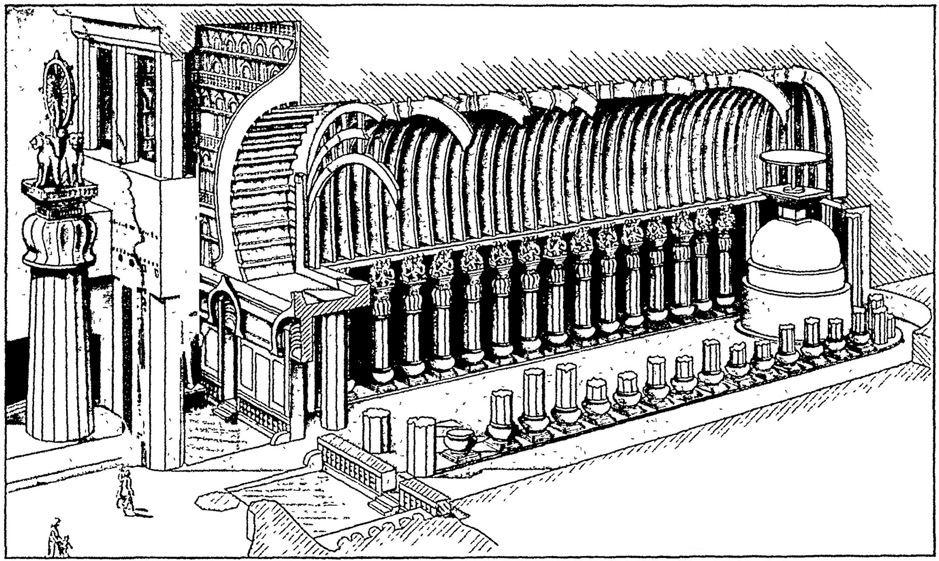
The cave is around 40 metres deep, more than 15 metres wide, and nave is ca. 14 metres high, and the aisles have a flat ceiling and are more than 5 metres high.
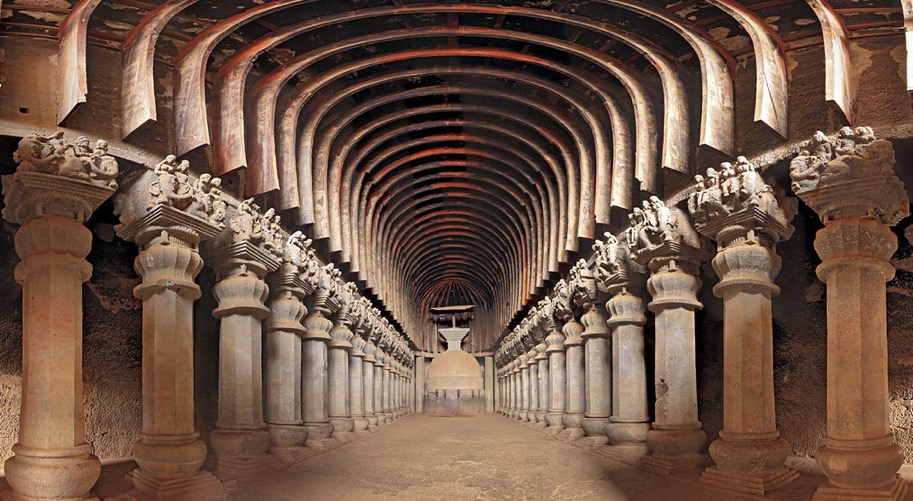
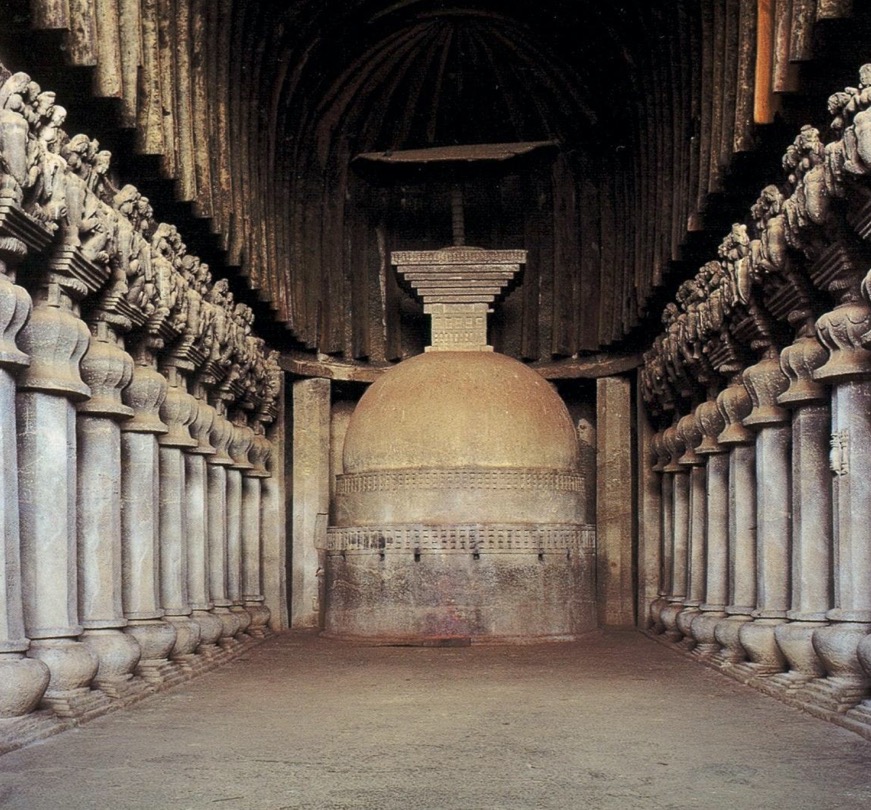
There are fifteen 'double-pot' columns on each side that separate the nave from the aisles, and each pillar has a tall base and an octagonal shaft. On top there is a richly ornamented capital, on which kneel two elephants, each bearing two figures, generally a man and woman, but sometime two females.
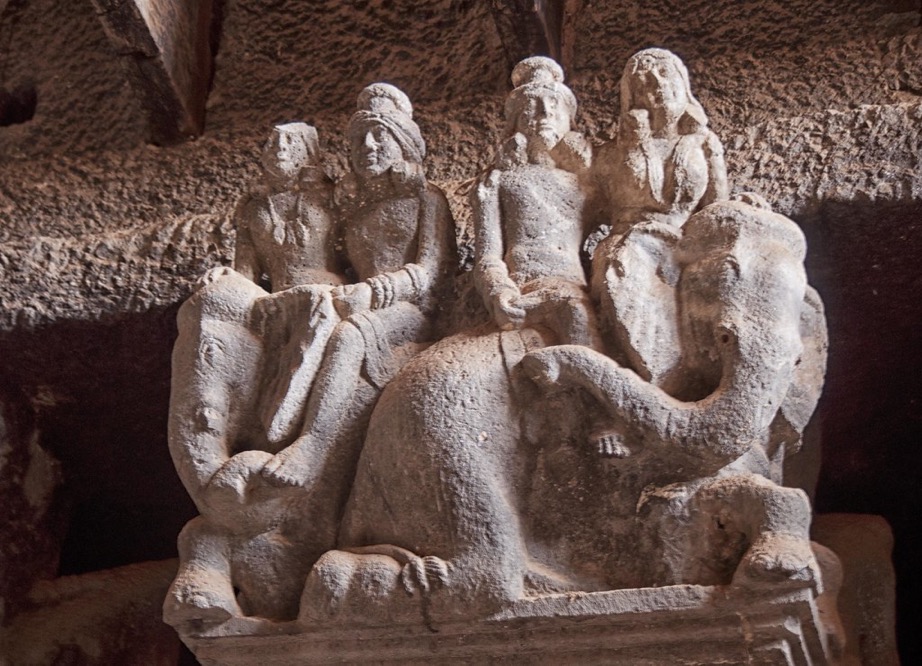
The seven pillars behind the altar are plain octagonal piers, without either base or capital, and there are four support pillars under the entrance gallery. There are both sculptures and plain painted surfaces. The roof is semicircular, but slightly stilted at the sides to make it higher than a true semi-diameter. There is a series of wooden ribs that serve no practice purpose but clearly suggest that it was modelled on an original wooden roof design. The stūpa or dagoba is a plain dome that would once have been decorated. It is surmounted by a 'tee', and on top there are the remains of a very rare wooden umbrella.
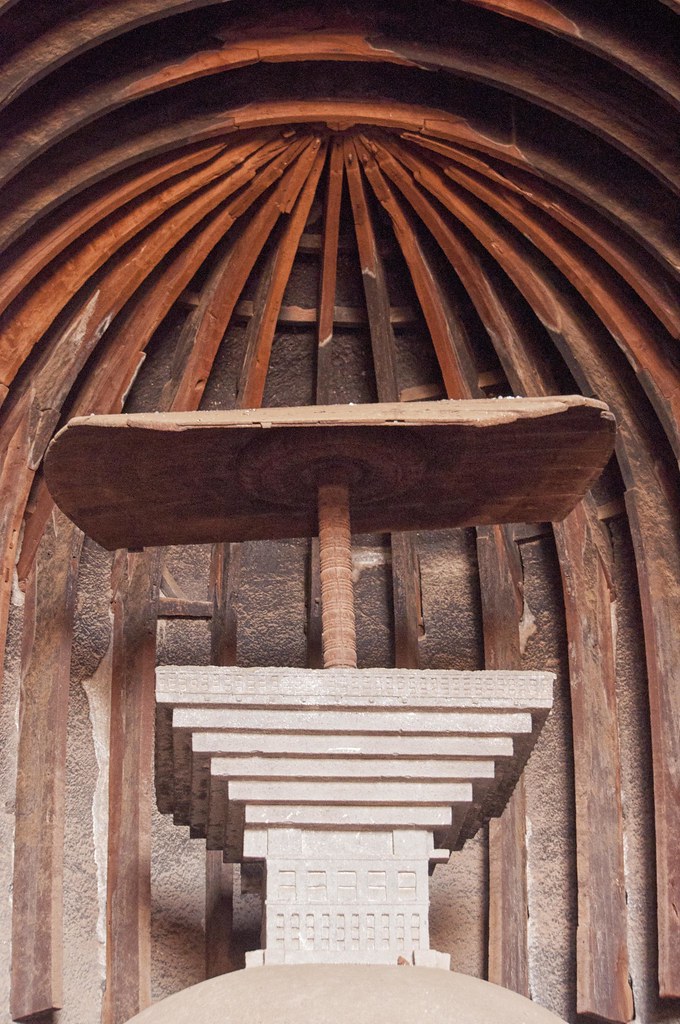
The stūpa was both a funerary monument and a symbol of Buddha himself and his teachings. However it could take on quite a variety of forms. It is said that the term caitya might have meant more or less the same thing as stūpa, but over time it also took on the meaning of temple and even was recognised as a symbol of Buddha. This type of stūpa-caitya were known to co-exist at sites with an open-air stūpa, such as at Sanchi. As we saw with the Great Stūpa the primary rite of worship at a stūpa was circumambulation to the right, replicating the course of the Sun. A caitya might have been covered to permit the rite to take place in inclement weather. The earliest caitya carved in rock were simple circular halls, but they then developed to an apsidal shape. The entrance would have been sculpted, and beyond a colluded façade there would have been a verandah with another internal façade with three doorways. The central doorway would have been marked by a large horseshoe arch leading into the apsidal hall with a stūpa in the apse. The side doors led to the circumambulatory path. Although the arch was made of stone, experts believe that it copied earlier freestanding timber ritual halls. The underside of the arch would have been carved with rafters and below them the caitya window would have been filled in the upper portion by a timber screen braced with vertical struts.
Inside Cave 8 on the left and right of the doorways in the verandah there are imitation timber reliefs. There are a multitude of miniature versions of windows and arched doorways. They appear as storey upon storey of miniature palaces, the whole supported at its base by elephants.
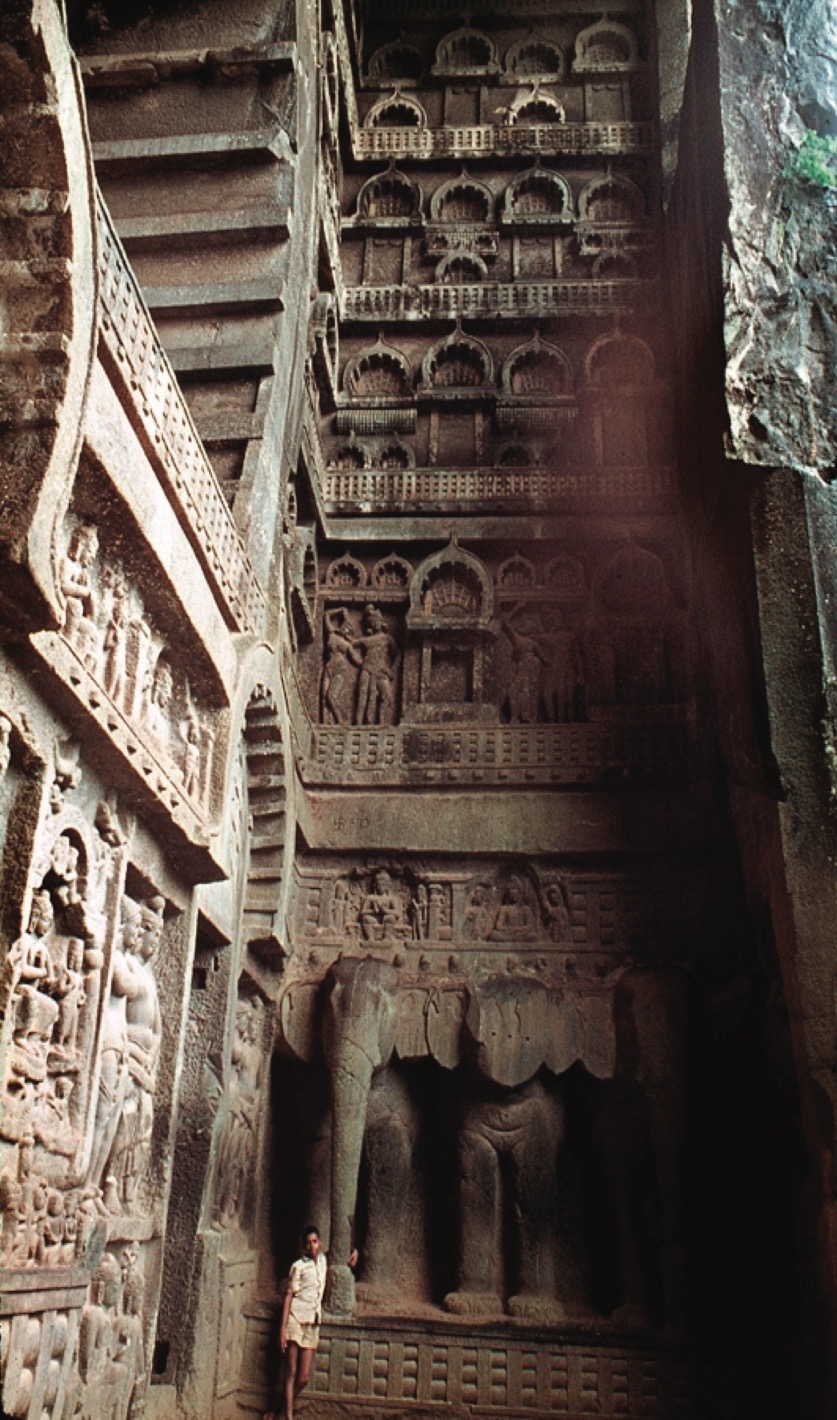

It is said that this form of decoration, layers of windows and doors, is designed to suggest palatial façades. In the caves of the 5th C AD, wall decorations were designed to overwhelm visitors. The verandahs and interiors were carved with Buddhist imagery, both individual icons in niches and narrative panels. Along the circumambulatory path, the faithful were entirely immersed in the internal world of the cave, a visual display of the life of Buddha.

Above we can see an example from a late 5th C Chinese verandah. Regardless of the precise form the setting might take, the message on the cave wall is clear, i.e. the divine Buddha is of princely origins, resides in a palace, and has high spiritual status. What is also impressive is that despite regional variations designed for a local audience, the overall message was consistent in India and 3,000 kilometres away in China.
Had you visited this chāitya some 100 years ago you would have seen this…
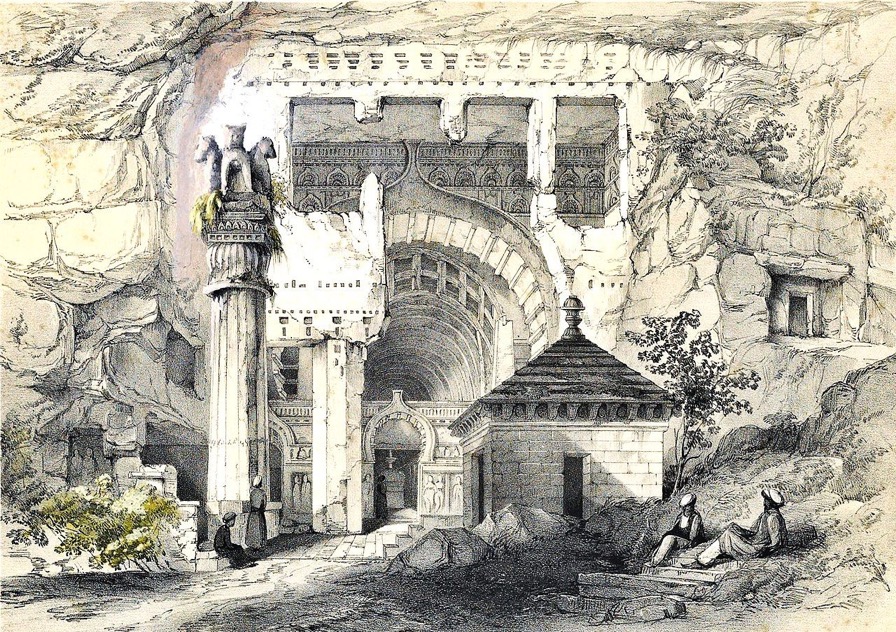
But today you will see the entrance partially obtruded by a contemporary Hindu temple…

We can see the basic structure of the first screen which would have consisted of three lower openings and five upper opening, all roughly hewed in the rock. This would have been covered with wood carvings, the mortices still can be seen.
We can see at the entrance a 15 metre tall pillar adorned with lions. In the past there would have been a pair of pillars, one each side of the main entrance.
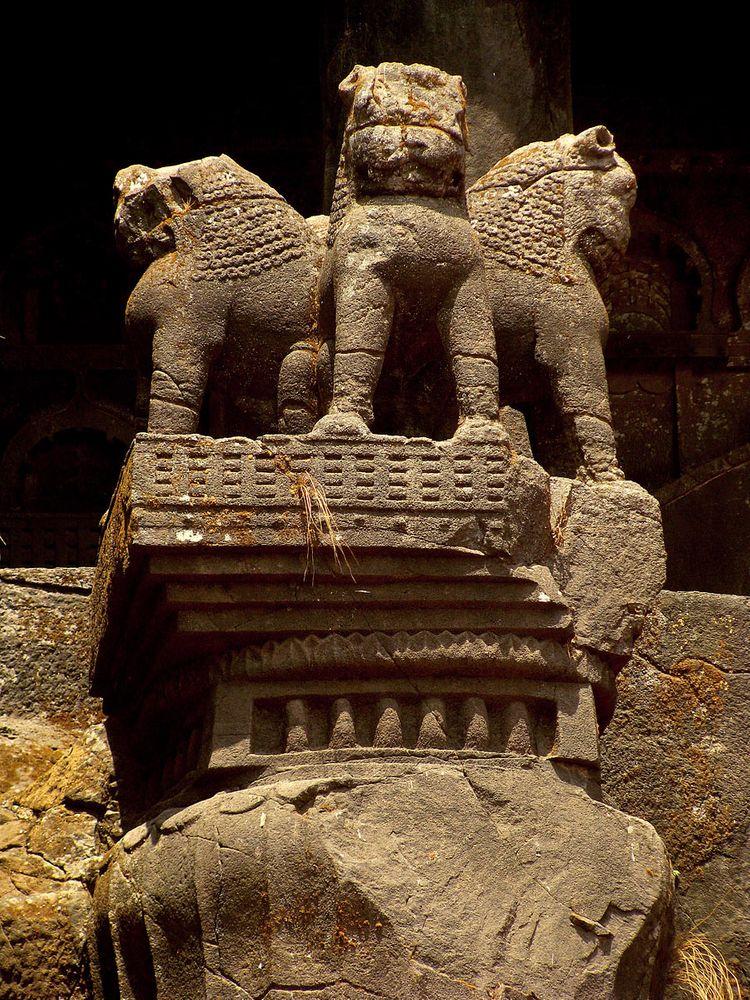
The decoration in the verandah looks to be a literal copy of a wooden construction. There are inscriptions on the verandah that indicated who founded the chāitya and who added the different sculptures inside and outside. The chāitya was established by a certain Seth Bhûtapâla from what is now Banavasi, which from ca. 345 AD was the capital of the Kadamba Dynasty.
The decorations and statues are often inscribed with the name and status of the people who made donations, e.g. a Buddhist preacher, a perfumer, a housewife, a carpenter, and even a female mendicant. Later royal patrons bestowed land to support the chāityas and vihāras (monasteries). In those days bestowing land sometimes also meant bestowing villages with all their inhabitants.
The role of the inscriptions is interesting because many include an identifier and are dated. We have mentioned that an inscription might be for a 'Dhamma-kathika' which means a preacher of the system/norm (being the Dhamma). The 'system or norm' was a technical term used for a Buddhist teacher who speaks/preaches as one who has a wide knowledge of traditions and the ethical doctrine, as opposed to the Vinaya, or the rules and procedures that govern a Buddhist monastic community. Another donation was made by a "woman who knows a Suttanta by heart" where a Suttanta is an explanation of a part of the Pāli canonical literature. And another donation was from "one who knows the five Nikāyas by heart" where Nikāya means volume or collection of Buddhist texts. These inscriptions refer to Buddhist texts, and are conclusive proof that they existed before the dates of the inscriptions, i.e. also before the time of Ashoka. If fact Ashoka in his inscriptions on his columns make reference to very specific portions of the canonical Buddhist texts.
In one analysis of inscriptions found in rock-cut caves they found that merchants topped the list of donors. Out of 222 inscriptions, merchants provided 46 donations (35%), royalty 30 donation (23%), government officials 16 donations (12%), monks and nuns 16 donations (12%), farmers and craftsmen 14 donations (10%), and foreigners 10 donations (8%). More than 30% of the donations were made by women.
We will close our visit to the 'Grand Chāitya' with a look at the wonderfully detailed interior façade of the verandah, which has been dated to ca. 60-50 BC.
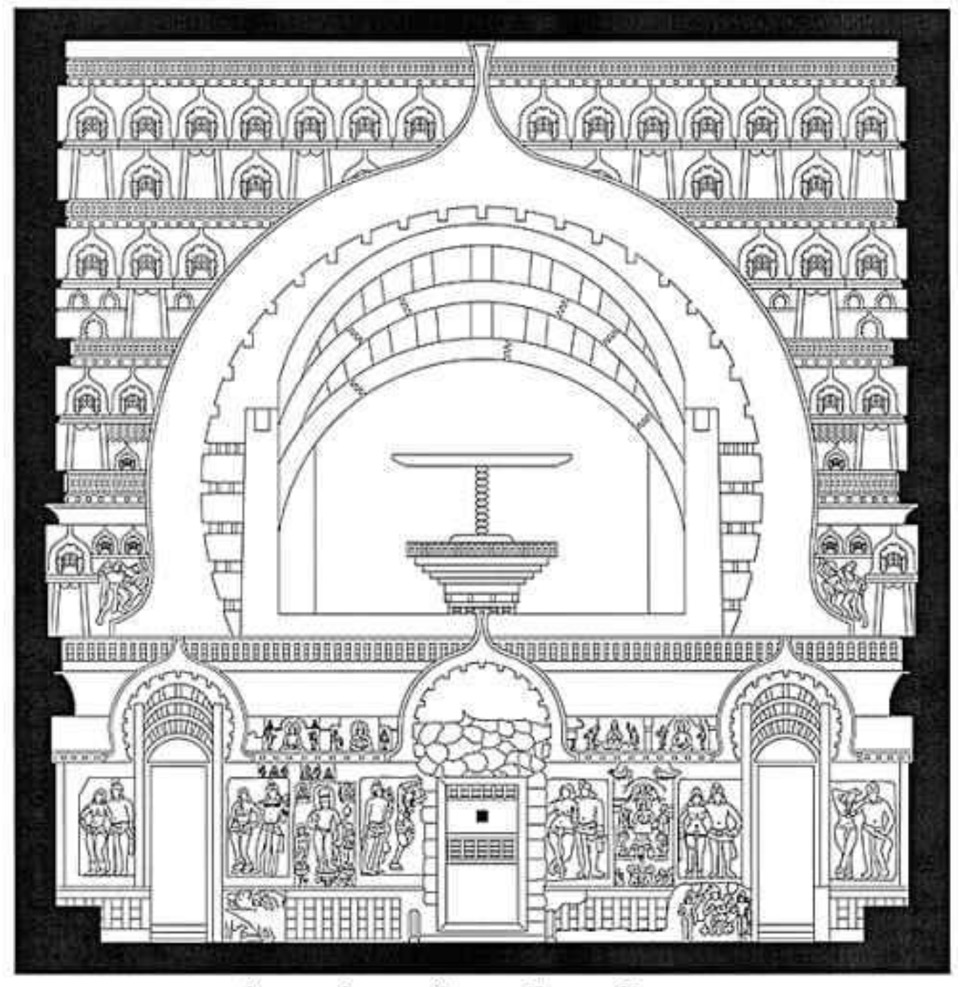
The interior façade is one of the finest and most complete examples in existence, and it is said that there would also have been a wooden screen in the great arch (in the 1880's the original wooden screen was still in place).
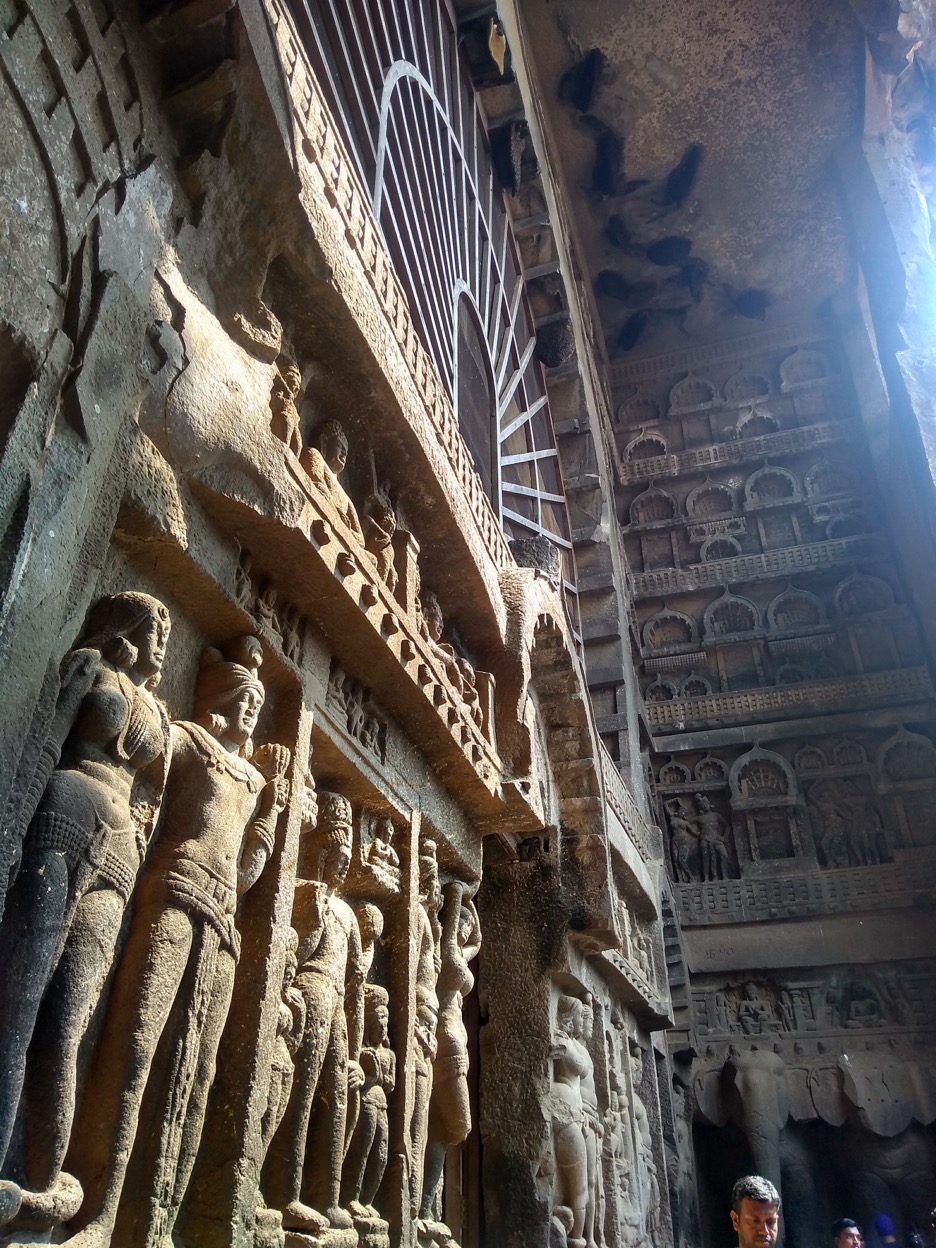
Originally the exterior façade would have been in wood, and around 1900 the great arch still had its original teak wood screen. The upper part of the interior façade consists of repetitions, on a smaller scale, of what might have been on the original wooded façade. We can see the three doorways, with the central one about twice the width of the side ones.
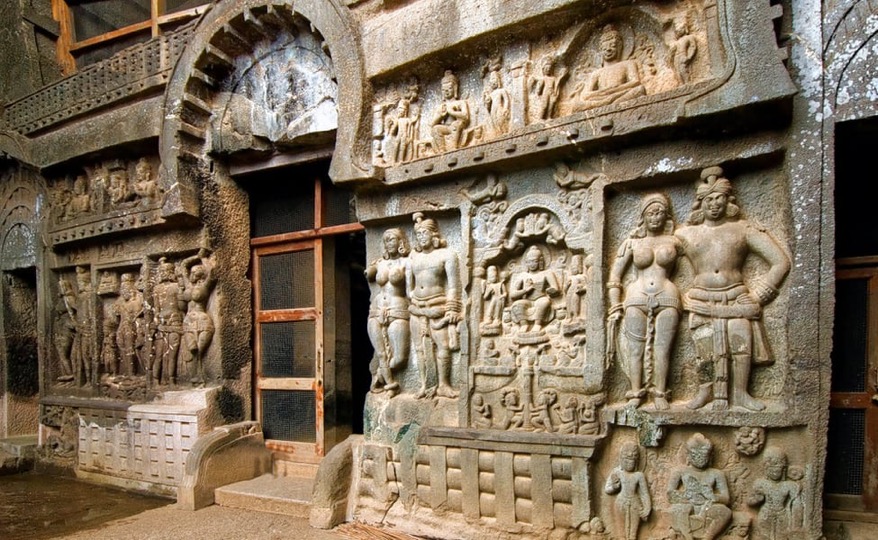
It is thought that the only original panels are the six lower panels each with a male and female figure (they have their original inscriptions). All the other panels, etc. were subsequently inserted in the 5th C or 6th C AD.

The six couples are the Yaksha (yakshas and yakshis), which are semi-gods that embody the abundance and fertility of nature. However they are also a kind of ghost that "fly about in palaces and temples and enjoy all kinds of pleasures and material advantages". They appear to be on the one hand evil and violent, but on the other hand they are also known to protect the righteous.
Check out these video resources, Karla Caves. Ajanta - the history and mystery, Ajanta Caves (4K), Ellora Caves and Ellora Caves (4K).
Plaster and decoration in the caves
Primitive tools and decorative rock paintings dating from 10,000 years ago have been found in the rock shelters of Bhimbetka. There are many figures of men, women and children in the early rock shelters, most are portrayed hunting. There are also some domesticated animals, carts, etc. (elephant, horse, ass, goat, bull, cow, and pig), and some wild animals can also be identified, e.g. pangolin, rhinoceros, porcupine, wild boar, tiger, antelope, hare, rat, monkey, and buffalo. There are also some cult figures, but no sign of agriculture. A variety of colours are used, and size and style varies.
During the time of Buddha, monks also used natural caves, but it was during the 3rd C BC that rock-cut architecture began to develop. In some cases extremely hard granite rock was cut into geometrical forms and polished to a mirror-like finish. A first wave of construction cumulated with the Karla Caves (ca. 160 BC). It looks as if initially cave walls were smoothed and polished, but left unpainted, and it was only after the 2nd C AD that wall plastering and painting started to become the norm. As donations and endowments were made, cave interiors started to be decorated with paintings, reliefs, and intricate carvings. Polished caves rapidly disappeared, but there was a huge effort made in building religious caves through to the 6th C AD. Cave building appears to have occurred in two waves, the first through to the end of the 2nd C AD, and then a new wave in the 5th C and 6th C AD. This second wave was characterised by a profusion of decorate sculpture, intricately carved columns, carved reliefs, decorative pillars and brackets, and richly etched ceiling panels.
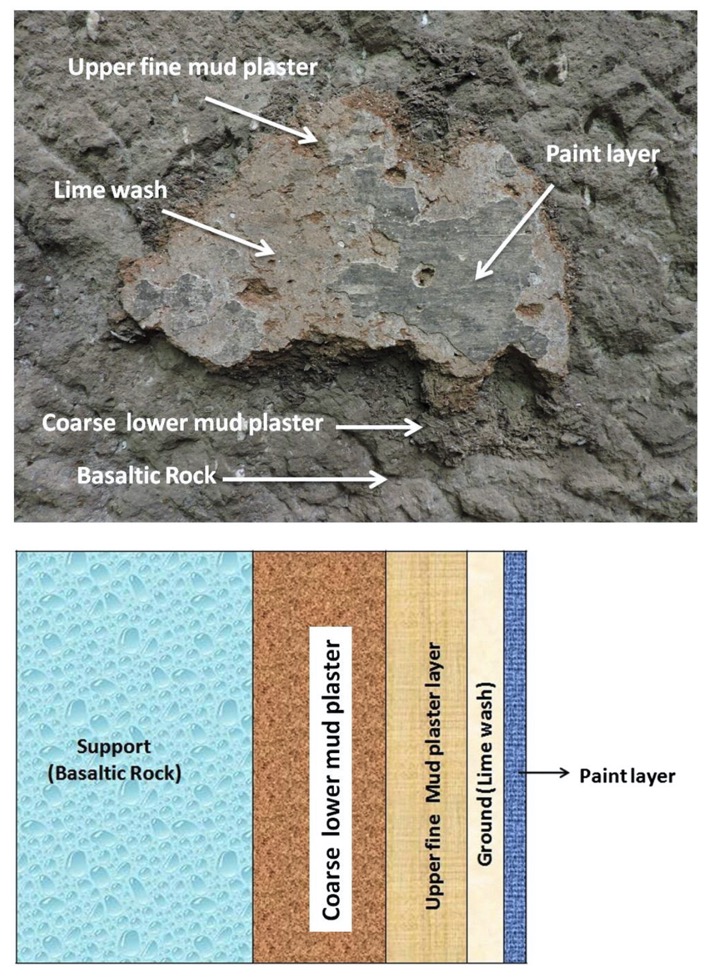
In the Karla Caves there were paintings executed on an earthen plaster ground on the basaltic rock, however they are now blacked by smoke from cooking fires. The decorative pigments of mineral origin have survived in the ceiling and pillars. The mud plaster has been found to have been mixed with organic additives like plant stem fibres and husks of local origin. According to this article the plaster contained local sand and silt with clay providing the binding. In Karla the earthen plaster was applied in two layers, the lower layer levelling the roughness of the rock surface, and the upper layer acting as a painting base. Materials such as plant straw, coarse sand, plant and animal base fibres were added to the sand to control shrinkage and avoid cracks. In particular bark fibre from Careya arborea and rice husks was added to plaster in the Karla Caves. In the Bhaja Caves the additives were rice husks and Paspalum grains, and it has been reported that Cannabis sativa fibres were added to earthen plaster in the Ellora Caves. In this last case it was noted that hemp plaster has an ability to store heat, is fire-resistant, absorbs about 90% of airborne sound, is also pest resistant.
In terms of the painting techniques, there appears to have been two different techniques, a northern way and a southern way. The northern way was a tempera technique. Walls and ceilings to be painted were covered with a thick mud plaster with a brownish orange colour. Over this a lime-primer was laid, smoothed, and then painted. The binding was animal gum, and the light surface was ideal for painting murals which would have been vivid and colourful. Unfortunately this type of technique did not survive.
The southern way involved two plaster coats. The first was with a plaster containing coarse sand, and the second was with a finer sand. The pigments were mixed with lime and a gum additive, and the colour were put onto a dry plaster. They would drench the dry plaster the night before, adding a little lime or baryte. They would then wet it again in the morning. The pigments would also be mixed with just a little lime. The result would be quite heavy, opaque and physically durable, but not chemically permanent, since the pigments are on the surface. There is a suggestion that brushes were possibly made of fine vegetable fibre, but none have survived.

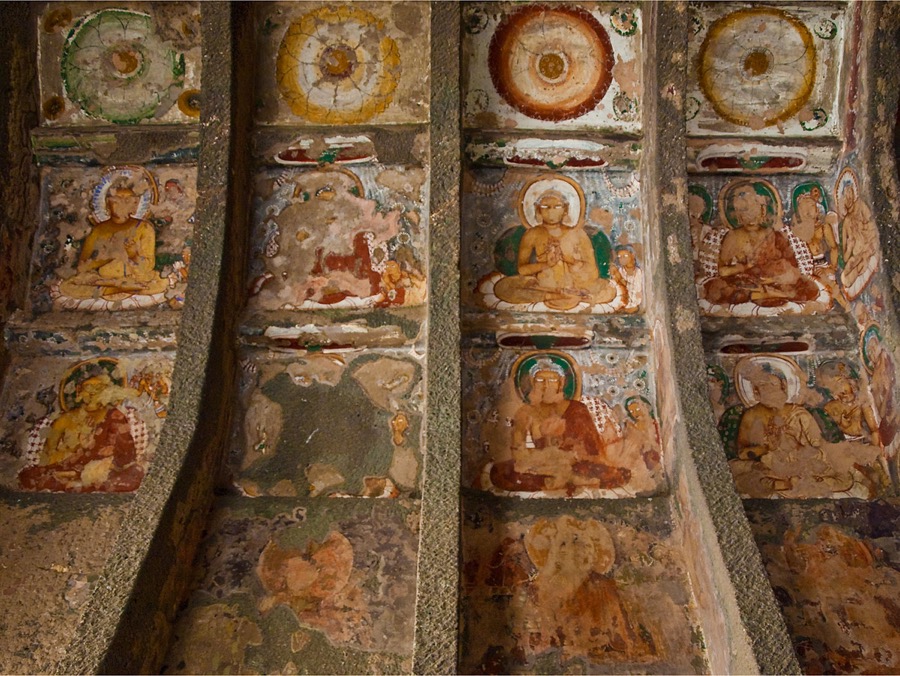
The Ajanta Caves contains some of the oldest Indian paintings, dating from the 1st C BC, and also some of the most interesting dating from 400-650 AD. It is suggested that already the paintings were executed by a 'professional'. Some experts have called the technique used 'fresco a secco', i.e. a tempera technique executed on a dry fresco. Firstly the cave wall would be 'chapped' to be able to hold the plaster layer. The first layer would be soil, cow dung, and stone dust. Sometimes husks of corn could also be found in this layer. Different versions can be found, but one suggestion was that over the second layer a thin white layer of lime was added and then the surface would be polished to make it smooth. One suggestion is that the dust of conch shells might have been used to make the surface whiter. Red outlines were then drawn, and then a 'terra verde' green (a soil diluted green colour) was painted over the entire surface, but the red lines could still be seen. Now the colours would be added, and the original red outline painted again in black. Some shading was used not to give a sense of depth but to make some colours more or less intense. The sense of depth was achieved by using opposing colours. This technique had limited colours, whereas a tempura allowed the use of colours such as pink, purple, etc.
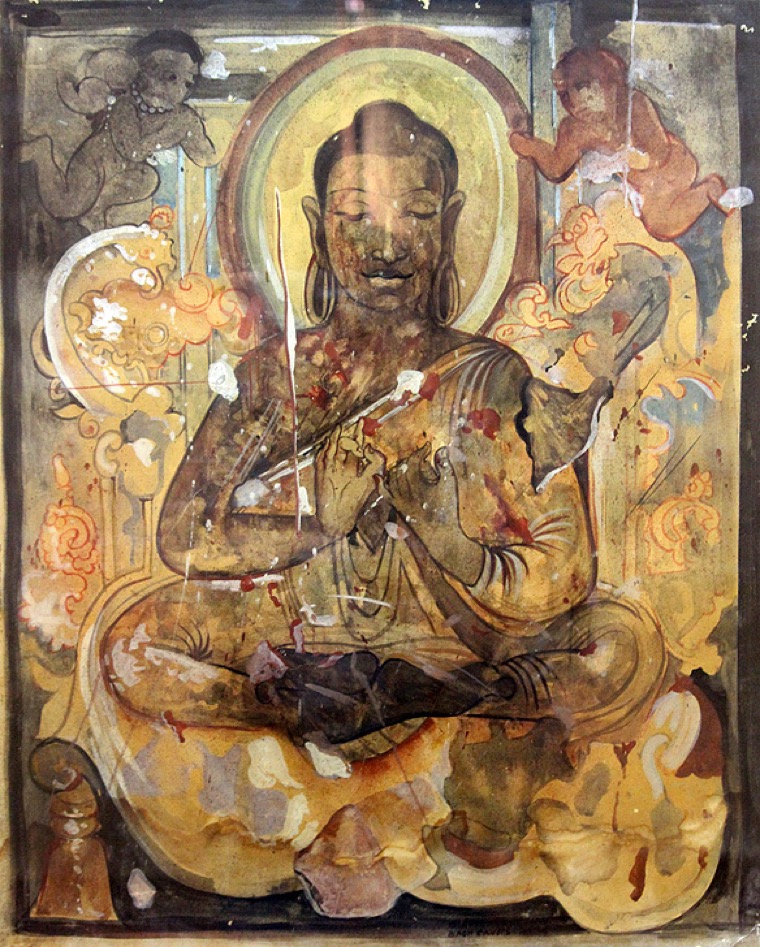
The Bagh Caves are home to some of the most sophisticated artwork executed between the 4th C and 6th C AD.
As compared to the Karla Caves, the earthen plaster used at Ajanta and Ellora contained far more silt and less clay. One important evolution appears to have been to use much finer grain sizes and a lower percentage of clay, which produced a much more resistant plaster. The presence of clay minerals produced a strong and flexible plaster, but contraction and expansion of the clay due to changes in relative humidity resulted in severe long-term damage. This clearly shows how techniques evolved over time, because the earthen plaster in Ajanta and Ellora was more rigid and survived better.
The Indian Iron Age
In reading up about the rock-cut caves, etc. I wondered about how the caves were cut. There are a multitude of books, reports, etc. that talk at length about the caves, but none mention how the caves were actually physically cut into the rock.
The Indian sub-continent developed an Iron Age after their Neolithic, Chalcolithic and Bronze Ages, and generally a date of ca. 1800 BC is used as the starting point for iron working. However this depended upon the region of India, and the source of information used, e.g. archaeological remains or foreign and indigenous literary references to iron production. For example, the earliest mention of Indian steel dates from the late 6th C BC (see Wootz steel which is usually dated from 300 BC). However, there are fire pits that have been dated to ca. 1000 BC, iron objects dated to ca. 1045 BC, iron nails dated to as early as the 15th C BC, and smelting furnaces from ca. 700 BC.
It does not look as if the regions that were home to the majority of Buddhist caves were at the forefront of early Indian iron and steel production. However certainly by 500 BC or later there must have been an ample supply iron for weapons, arrow heads, knife blades, hooks, axes, chisel heads, tool sharpeners, grinding stones, daggers, nails, sickles, hoes, borers, spearheads, tongs, needles, etc.
Hardening and quenching methods (i.e. for low carbon steel) have been identified in a sickle dating from the 3rd C BC. And iron clamps have been found at the Bodh Gaya temple, and dated also to the 3rd C BC. Iron spikes, nails and other pieces have been unearthed in the monastery at Piprahwa, and have been dated to the 1st or 2nd C AD.
Unfortunately I've not found any useful references to the tools and techniques that were used to carve and polish the stone in Buddhist caves, etc. Nor have I found any discussion on the construction practices used to create a Buddhist rock-cave.
The best I've found is that the conventional method was chisel and hammer. The idea is that chiselling would follow a pre-determined shape, and then detail would be added once the initial form had been carved. According to the experts cutting into the rock would have started by cutting narrow passages through the future access points (e.g. windows/doors) at ceiling level. Then the ceiling would be carved out, then the hall would be cut out leaving in place any columns, then the corridors would be widened, and finally any secondary chambers would be created. Cutting, sculpting and polishing were undertaken simultaneously, and there is a strong chance that specialist 'decorator' monks would move from one site to another. There are references to different categories of craftsmen, e.g. stone masons, polishers, carpenters, etc. Basalt is a porous material with naturally occurring holes in it, but it difficult to carve because of its hardness. Colours can vary, but it is usually a dull, soft colour.
Ceiling heights varied, with low ceilings and small windows in the vihāras (monks cells) and high ceilings and big windows in the chāityas (temples). The vihāras were designed to focus on quiet and meditation, whereas the chāityas were designed to impress and focus attention on the stūpa at the back. From one cave to another, columns varied in style, placement and size, as if there was much experimentation to find the best option. We tend not to focus too much on the columns, but if fact they represent an almost infinite variety of sizes, shapes, decorations, etc. Just as an example, below we have the columns in the main vihāra at the Elephanta Caves (dated from the 5th C or 6th C AD). They may look a bit 'unfinished' but in fact this was typical of the style during the Chalukya Dynasty in southern and central India (6th C to 12 C AD). In an old survey of temple designs the authors identified 63 different forms of columns used during the Chalukya Dynasty. On the right I've placed a different, much simpler, column design from a chāitya at the Nasik Caves (Cave 18), and could be dated to as early as ca. 120 AD. There are at least 21 different column designs at the Nasik Caves. This particular design is called a Ghata-Pallava pillar, which uses a pot filled with flowers or leaves as an important decorative motif. In Vedic literature it is the symbol of life, the source of all vegetation. The symbol was prominent in all periods, but it became very popular from the 5th C AD in Northern India, and continued to be used until the 15th C. A 'full vessel' was a ceremonial offering in Buddhism, Jainism, and Hinduism, and was offered to a deity or honoured guest.
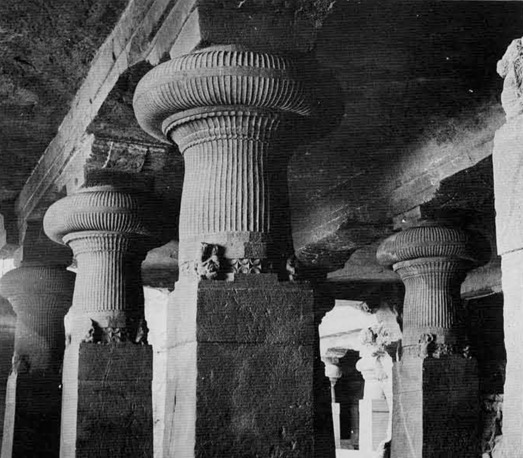
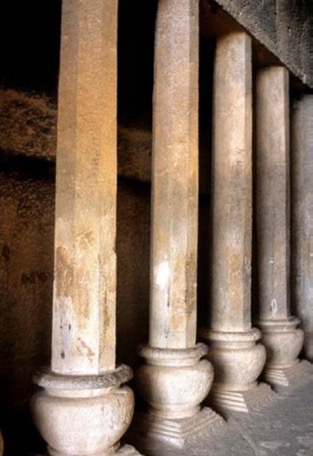
Oddly in many caves, beams were carved despite them having no structural importance, and even in the 6th C AD the original wooden temple construction was still being copied in stone. There are no wells inside the caves, but there were water tanks carved out of the rock, along with channels to collect rainwater. In some of the vihāras cisterns for storing water were carved.
The tower, a new form of temple
Relics were interred in a stūpa, but during the first centuries AD a new type of temple was developed in South Asia. Its purpose was to shelter anthropomorphic sculptures of Buddhist and Hindu deities. In northern India especially, the towering 'Indic-Hindu' temple was called a prāsāda, a Sanskrit term meaning palace. The builders of temples at important Buddhist ritual sites, including the Mahābodhi temple at Bodh Gaya, the site of the Buddha’s enlightenment, used the essential elements of the prāsāda palace, those appearing on the walls of the cave temples, to create a powerful new symbolic architecture.
Bodh Gaya (or Bodhgaya) was once called Uruvela, and archaeological excavations suggest that it was inhabited as early as 1100 BC. As the place where Buddha attained 'enlightenment' sitting under a sacred Bodhi Tree, it is the most important Buddhist religious site. The other three main pilgrimage sites are Lumbini (Buddha's birthplace), Sarnath (when Buddha delivered his first teaching), and Kusinagar (where Buddha died).
In ca. 260 BC Ashoka had constructed a small shrine-temple to mark the birth place of Buddha, and during 200 BC through to 100 AD Bodh Gaya became a place of pilgrimage. There is an inscription dated sometime between the 1st C AD and the 2nd C AD mentioning that Ashoka's shrine was converted into a temple, later known as the Mahābodhi temple.
A Chinese monk visited the site in 409 AD, and although his report is not that extensive, it is presumed that the temple was built sometime between 380-400 AD. One telling point was that he referred to the building as a temple and not just a stūpa. During 400-800 AD there is a suggestion that the temple was remodelled, or even completely rebuilt. Another Chinese pilgrim produced an extensive report on his stay in 637 AD. He noted that the Mahābodhi sangharama (monastery) had been built by a former king of Sri Lanka, and had six halls, with towers for observation, and a defensive wall of 10-13 metres high, and all ornamented in the richest colours. There was a statue of Buddha cast in gold and silver, and there were large stūpas containing the relics of Buddha. He also noted that there were more than 1,000 monks on the site. His description of the temple itself with the blush brick, the sculptures, the two storey pavilion on one side, the overall dimensions, etc. tallies closely with the temple as it now stands.
Let's now quickly backtrack to better understand how this type of temple evolved over time. The earliest temples were thought to have been isolated buildings housing some form of relic or aniconic symbol of Buddha. It was ca. 100 AD that anthropomorphic Buddha images started to replace all the aniconic symbols inside the sanctum sanctorum of the Buddhist temple (chāitya). For example, in the Mahābodhi temple a throne and a Bodhi Tree were replaced. Naturally in some cases a stūpa-temple would mix relics with images of Buddha. A multitude of options emerged, from the Chinese pagoda temple, to the stūpa-temple in monasteries, to the terraced mountain temples found in Southeast Asia.
We have seen that the Buddhist rock-hewn cave temples and stūpas are better known and better documented, but unfortunately many of the earliest free-standing temples and shrines were constructed in wood and wattle-and-daub and have totally disappeared. Evan as early as the 3rd C BC some temples would have been multi-storeyed and built with timber and brick (or stone) and covered in several layers of plaster. Below we have the example of the Bairat Temple built ca. 3rd C BC. From the foundations we can see that it was a circular temple, built around a small stūpa. We can also see that it already had its devotional path around the stūpa.
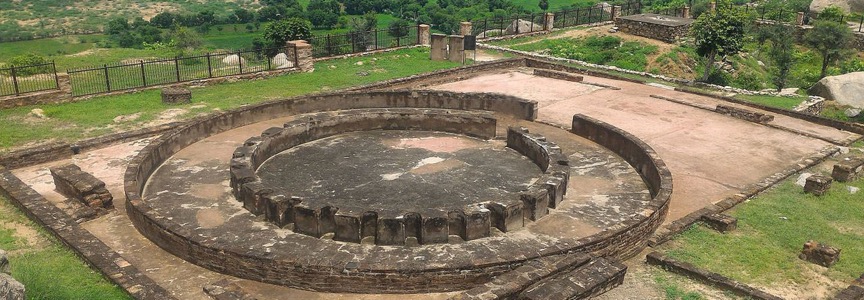
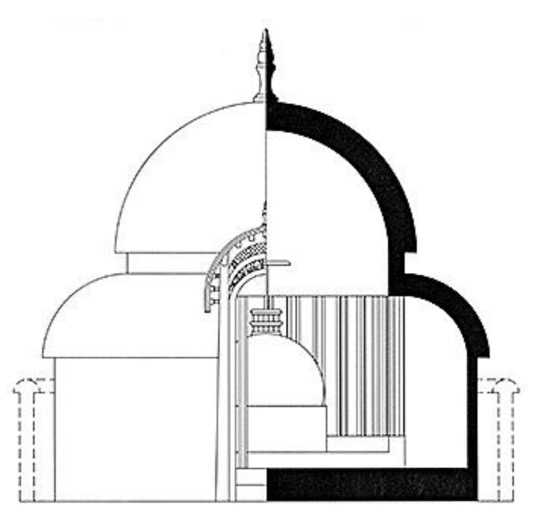
One of the earliest free-standing temples in India is the Sanchi Temple 40, which is dated to the 3rd C BC. It was an apsidal hall almost certainly made of timber, and sitting on a raised rectangular stone platform. In the 2nd C BC it burned down and was replaced with a larger platform and a hall with 50 pillars, of which the stumps remain.
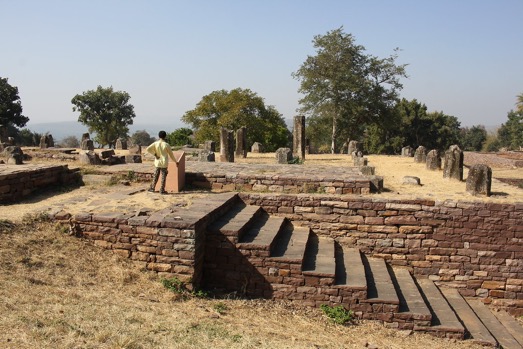

As we can see the chāitya-arch, the dome, the apsidal, and the barrel vault were certainly known in the Kushan Dynasty period (ca. 30-375 AD). There are sculptured reliefs that show that free-standing square or octagonal multi-storeyed or multi-tiered temples existed from as early as the 1st C BC. The sacred relic would have been placed in the centre of the top storey, and the overall height could have exceeded 12 metres or more. None of these towers exist today.
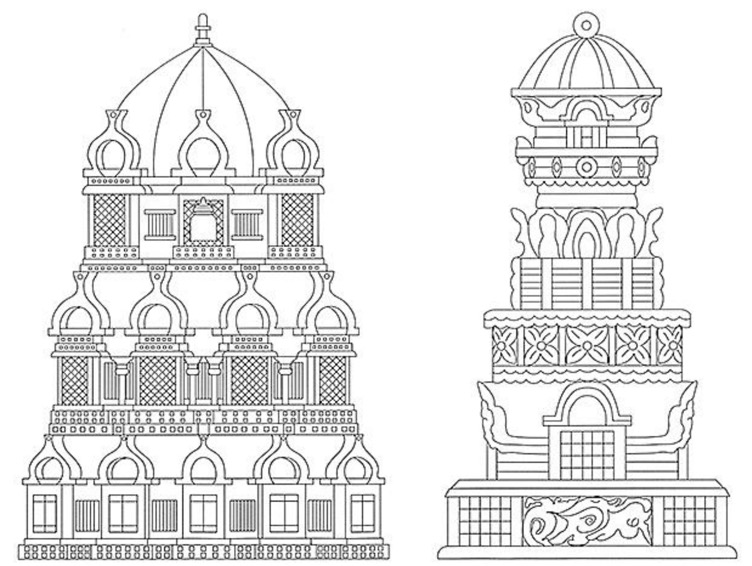
The flat roofs of the early Gupta temples would be another feature that appeared in the 4th C AD. The circular temple seen above was certainly rarer that the free-standing apsidal chāitya, which was the most common design through to the 6th C AD. The Ter Temple or Trivikrama Temple dates from sometime between the 2nd C AD and the 3rd C AD.
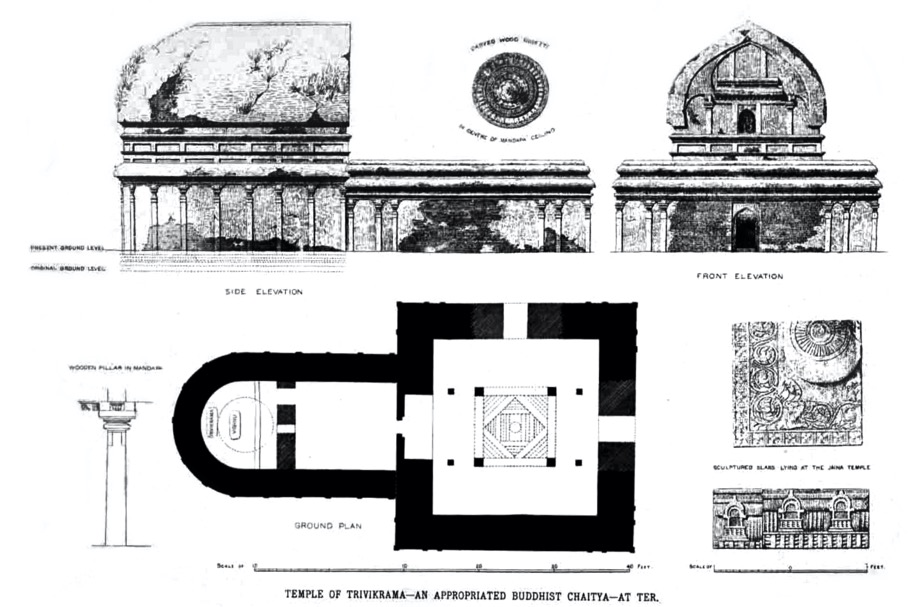

The front flat-roofed hall (mandapa) and all the exterior pilasters and moulding appear to date from the 6th C AD when it was converted into a Hindu temple.
Over time a new architectural direction was introduced from Gandhara (through to 5th C AD). This would gradually replace the Indian tradition of the chāitya-arch, dome, apsidal, and the barrel vault, in favour of the tower-style temple seen at Bodh Gaya.
Later (ca. 540-700 AD), Buddhist temples would evolve with the quincunxial and cruciform (simple cross) designs, along with the straight-edged pyramidal tower or spire. Quincunxial is just another way of saying a plan with five towers, four in each corner of a square, and one in the middle (as seen in the Mahābodhi temple). This type of plan was also adopted in the so-called panchayatana temple layout, with a central shrine surrounded by four subsidiary shrines. The arch-and-vault, particularly the pointed arch, would be employed to support the heavier loads associated with multiple-storeys.
It is unclear when the Mahābodhi temple was first built, there are no reliable records, and it has undergone several ancient and modern renovations. The only certitude is that the temple more or less as seen today, existed in 637 AD.

There is also the Bodh Gaya Plaque, a small clay disk showing a slopping tower with a pinnacle on top and an arched chamber at its base. But there is no absolute proof that the tower shown is the Mahābodhi temple. Below we have a small model of the temple dated from the 11th C AD.
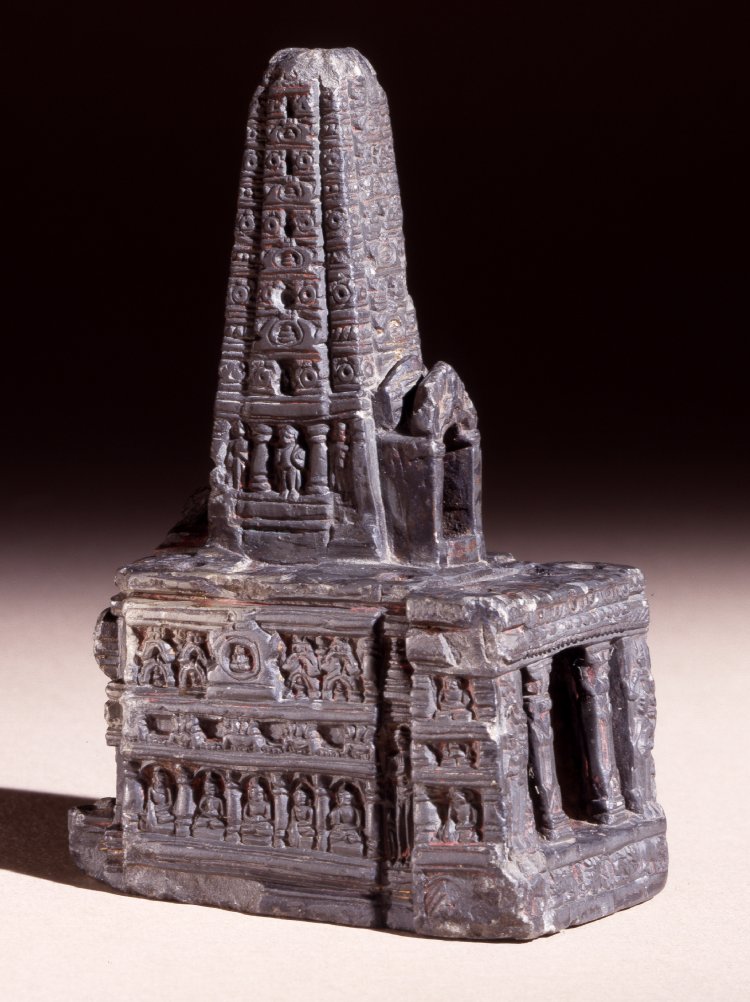
In late 1100 AD Bodh Gaya fell under the Delhi Sultanate and the temples and monasteries started to decay, although there is record of a visitor staying at the monastery in 1234. Later rootless Buddhist monks continued to visit Bodh Gaya, but it was the Shaivite Hindu ascetics that established a permanent monastery on the site, which then gradually became a major landowner and the local ruler.
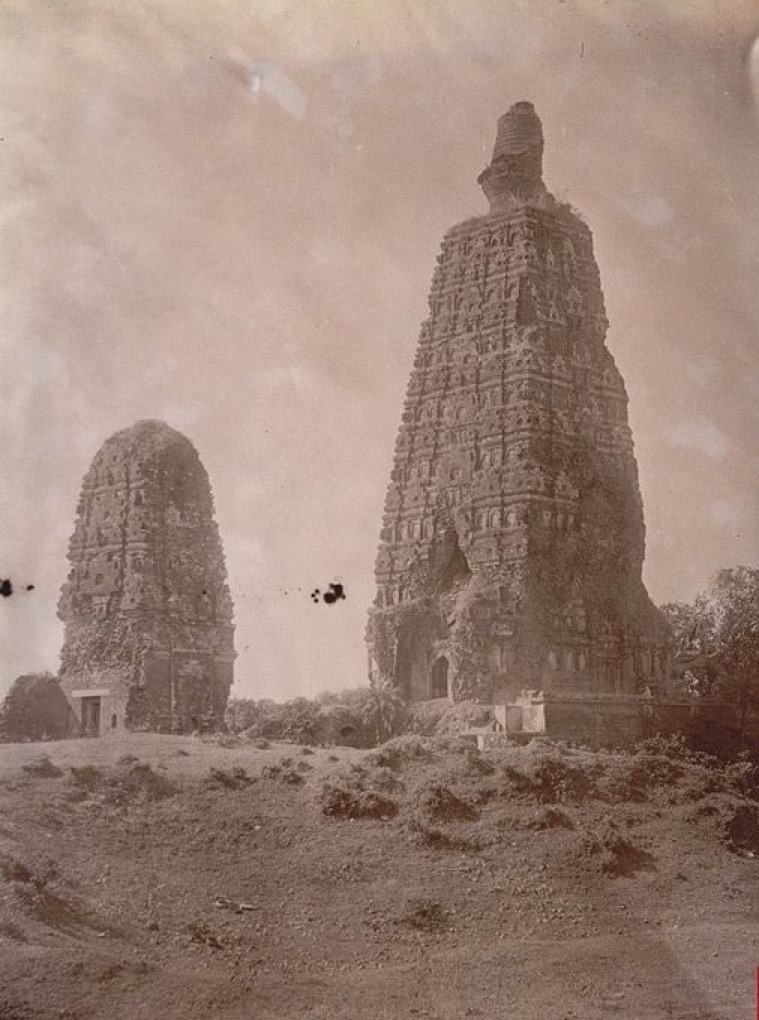
In the period 1800-1947, given the state of disrepair, the temple was excavated and restored (the above photograph dates from before the restoration, ca. 1870). Finally in 1956 the temple fell under joint Buddhist-Hindu management. Also in 1956, to celebrate a Buddhist Era of 2500 years, India invited all Buddhist countries to establish monasteries in the area of Bodh Gaya, and I have read that at least 59 monasteries have been built by countries as varied as Thailand, China, Bangladesh, Burma, Cambodia, Japan, Korea, Sri Lanka, Lao, Vietnam, Bhutan, Taiwan, and Mongolia.
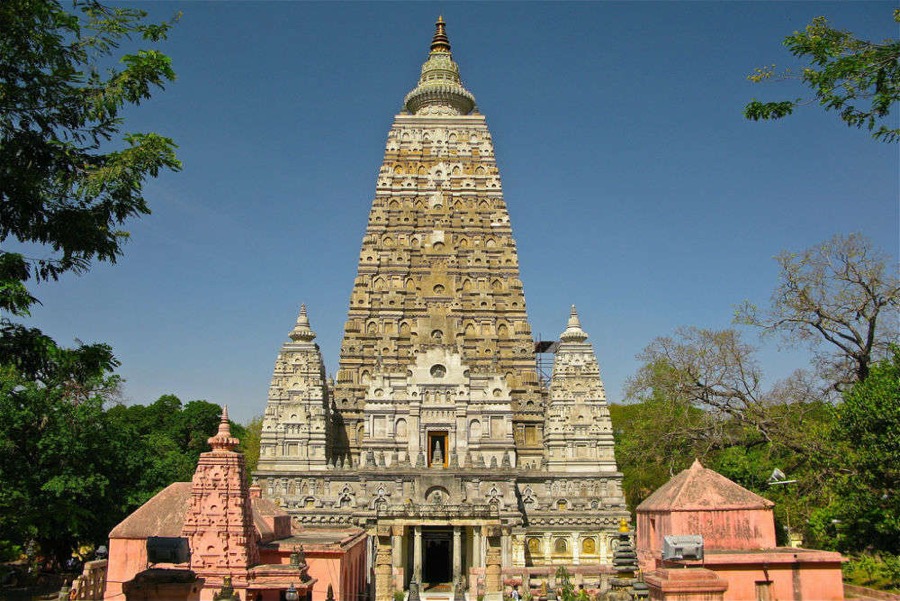
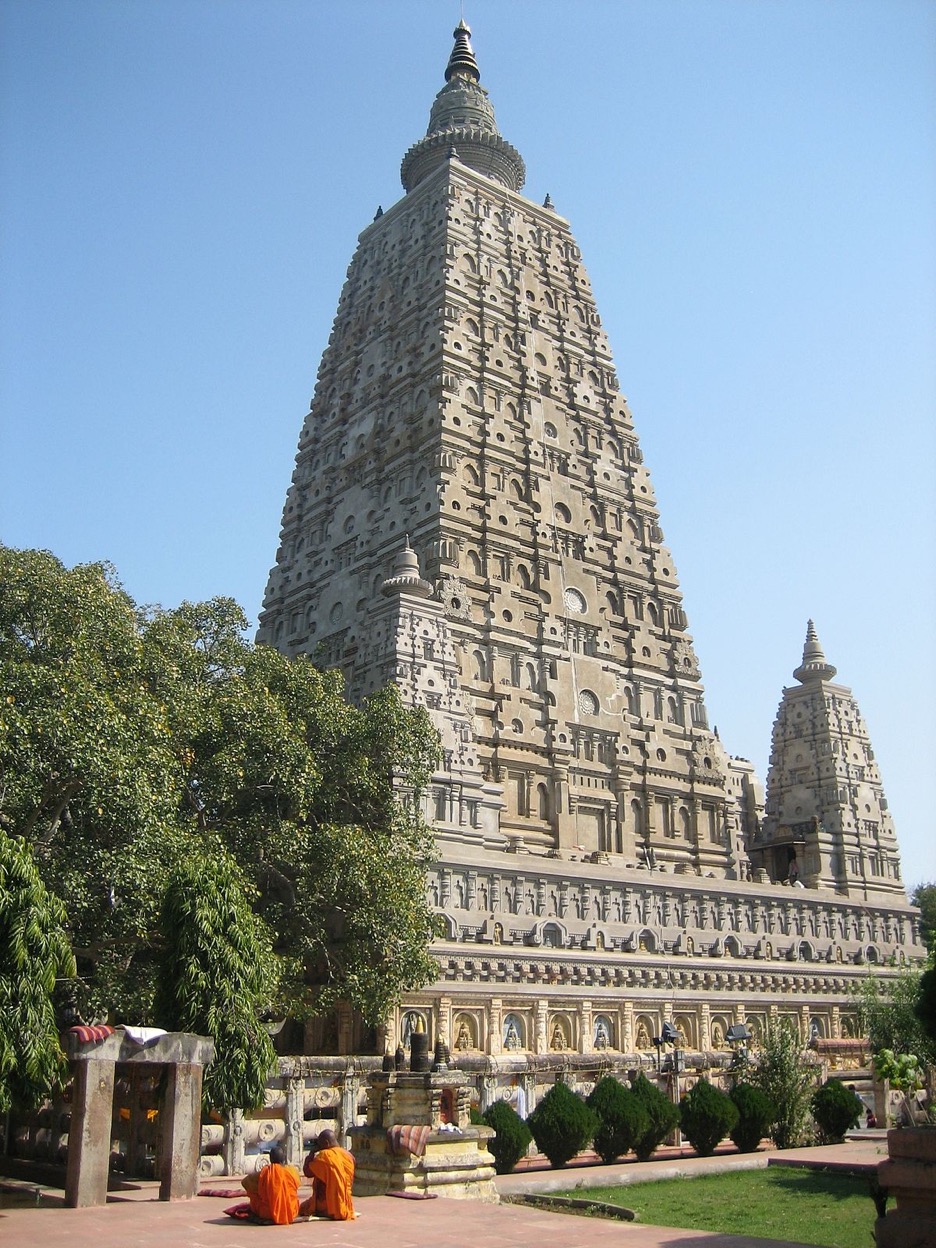
For a very detailed description of the past and present of the sacred Mahābodhi temple check out the PhD thesis "The Control of 'Sacred' Place", which also documents the conflicts of the temples from 1874 until 2012.
Check out this video resource, Bodhi Gaya - the sacred land of Buddhahood.
The spread of Buddhism
The spread of Buddhism must be associated with the spread of trade. It is said that Ashoka sent a Buddhist mission to Burma in the 3rd C BC, and that a diplomatic mission from India reached Rome in 21 BC. We also know that trade with China was already established by 65 AD, and that during the period 222-589 AD Mahayana Buddhism spread across Southeast Asia, following the early trade routes between India and Central Asia. The argument is simple, clan chieftains were looking for ways to legitimise themselves, command respect from their subjects, and establish a royal lineage. A new religion from the West could help, so many local rulers allied themselves with higher gods by becoming Buddhists or Hindus. Impressive temples were a way to display the wealth and prestige of the nation-state, and the power of the leader. By ca. 6th C AD, kings would be consecrated as divine through great rituals and state ceremonies conducted by Hindu and Buddhist holy men. Classical Sanskrit literature (the theological texts of Dharmasāstras, Arthashastra on statecraft, Kamasastra on desire, Rāmāyana on the life of Rama, Mahabharata on war and fate, …) educated and informed the political elite. Temples became focal points as centres of learning, political power, and religion. Indigenous beliefs were integrated so as to ensure popular support from the population.
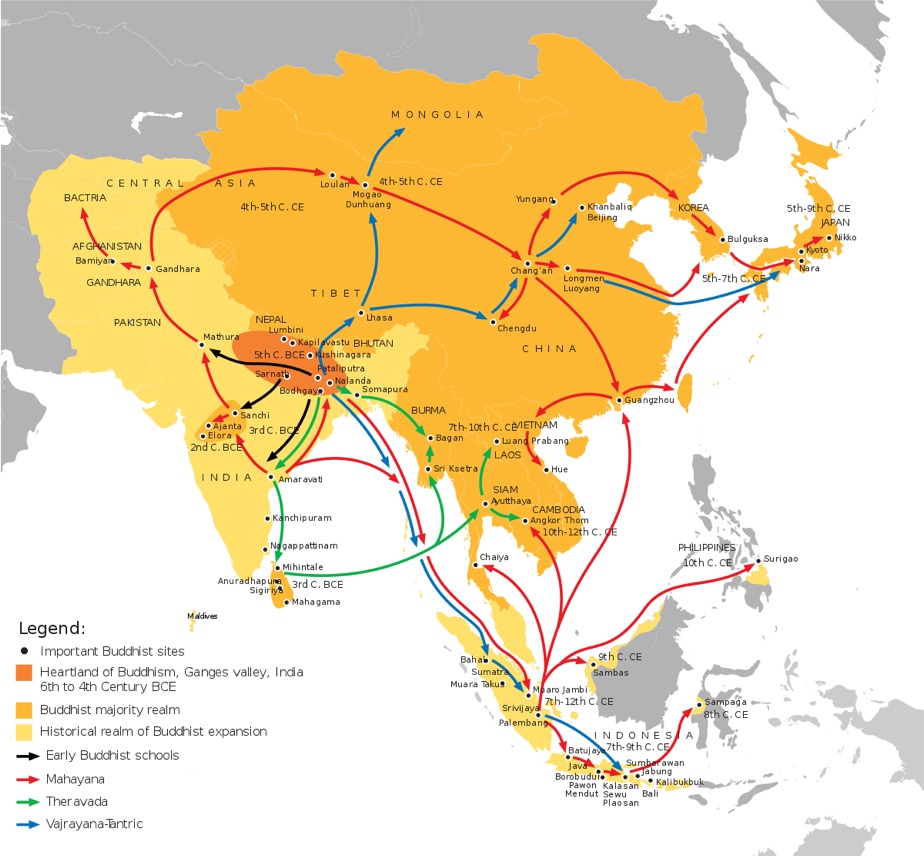
The spread of Buddhism in China, Korea, Japan and Tibet was greatly assisted by the patronage of Buddhist rulers (see Chinese Buddhism, Korean Buddhism, Buddhism in Japan, Tibetan Buddhism). In Southeast Asia the monarchy were often seen as practicing Buddhists. It was Ashoka who encourage monks and nuns to spread dharma throughout India. It was in the 12th C, with the destruction of Buddhist centres of learning by Muslim invaders, that Buddhism disappeared from India.
Tradition has it that the monk Mahinda, declared to be the son of Ashoka, brought Theravāda Buddhism to Sri Lanka (see Buddhism in Sri Lanka). Over time an interwoven relationship between the monarchy and monastic orders was formed, and monks became landlords with endowed villages and lands. Theravāda Buddhism also spread to Burma (Myanmar), and both Burma and Sri Lanka are seen today as guardians of Theravāda Buddhism and the Pāli texts.
Travelling Buddhist monks and traders introduced Buddhism into Southeast Asia (Thailand, Cambodia and Laos) possibly as early as the 2nd C BC (see Buddhism in Thailand, Buddhism in Cambodia, Buddhism in Laos). Both Hindu and Buddhist traditions enjoyed a privileged status at the royal courts, and both helped to strengthen and legitimise the rulers. It was in the 13th C that Theravāda Buddhism became the most powerful movement, e.g. Thailand often imported monks from Sri Lanka.
Travelling monks and laypersons also brought the practices and teachings of Buddha in to China in ca. 100 AD, but it would take another 200 years before it could gain a footing with the educated elite and high aristocracy. By this time monks were Chinese and the Sanskrit texts had also been translated into Chinese. By aligning Buddhism with Chinese indigenous concepts it finally was considered on par with Confucianism and Daoism/Taoism.
Buddhism, Confusian and Daoist concepts arrived in Vietnam through China, but it was not until the 10th C that Buddhism obtained its royal sponsorship, and its elevation to official state religion (see Buddhism in Vietnam).
Buddhism was introduced in Korea by the Chinese in the 4th C, and through to ca. 1400 it was patronised by the royal court. It was the Koreans that transmitted Buddhism to Japan in about 550 AD. The ruling family adopted Buddhism as an ideological bias for their centralised state and as a legitimation of their power.
Both Buddhism and Hinduism also arrived in Indonesia sometime in the 1st C AD and it was only at the end of the 16th C that Islam had supplanted Hinduism and Buddhism as the dominant religions of Java and Sumatra (see Buddhism in Indonesia). This period produced some of the most impressive examples of Buddhist art and architecture, most notable was the 9th C temple at Borobudur, which was and still is the largest Buddhist temple in the world.
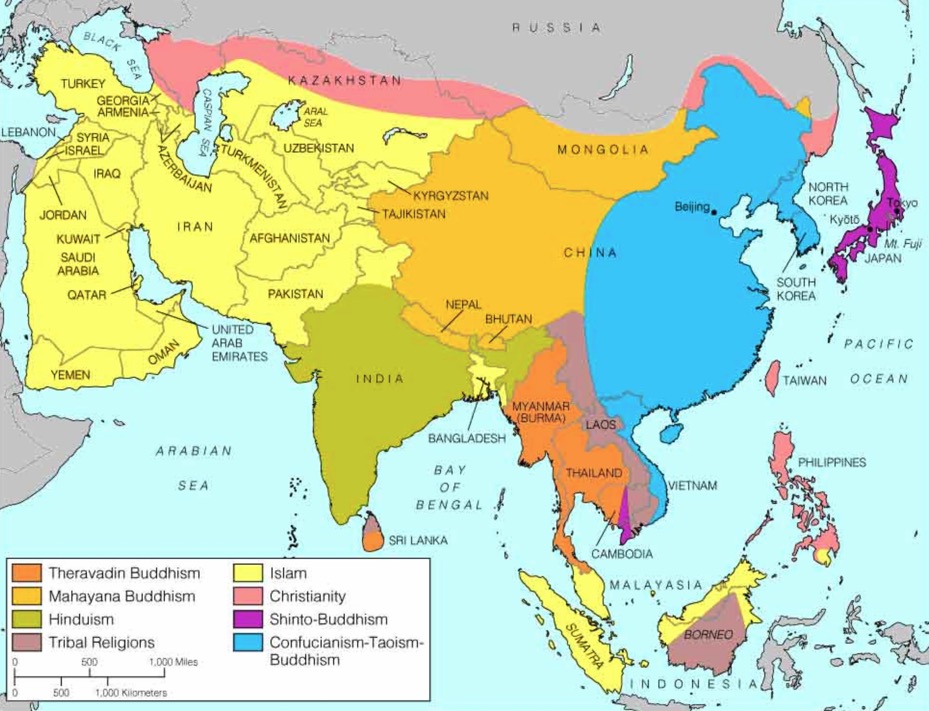
Naturally in many Asian countries Buddhism had its up's and down's. Today Bhutan (75%), Cambodia (97%), Mongolia (55%), Myanmar (80%), Laos (55%), Sri Lanka (69%), and Thailand (93%) host dominant Buddhist cultures. Buddhists are also a sizeable minority in Vietnam (16%), Taiwan (21%), Singapore (34%), Nepal (10%), Malaysia (20%), Macau (17%), South Korea (23%), Japan (36%), Hong Kong (13%), and China (18%). This represents about 500 million people, of which around half are Chinese.
References
Rare Book Society of India (truly a wonderful website to browse and study)
Sanchi (an extensive review)
A Guide to Sanchi, John Marshall (1918)
Buddhist Cave Temples and their Inscriptions, Jas Burgess (1881)
Prehistoric Ancient and Hindu India, R.D. Banerji (1939)
Rock-Cut Temples of India, James Fergusson (1845)
The Rock-Cut Caves of Pitalkhora in the Deccan, M.N. Deshpande (1959)
The Bhilsa Topes, Alexander Cunningham (1854)
Buddhist India, T.W. Rhys Davids (1903)
Tree and Serpent Worship, James Fergusson (1868)
Bones, Stones, and Buddhist Monks, Gregory Schopen (1997)
Lay Ritual in the Early Buddhist Art of India, Susan L. Huntington (2012)
Buddhist Shrines in India, Indian Ministry of Information and Broadcasting (1951)
Bodhgaya - the site of enlightenment, edited by Janice Leoshko (1988)
Mahabodhi, Alexander Cunningham (1892)
Buddhist Cave Temples in India, Owen C. Kail (1975)
Ellura Cave Temples, Jas Burgess (1883)
Resurgence from Ruins - the Sanchi Saga, Archaeological Survey of India (2019)
The Production and Reproduction of a Monument: The Many Lives of the Sanchi Stūpa, Tapati Guha-Thakurta (2013)
The Sculpture of India (3000 BC - 1300 AD), Pramod Chandra (1985)
The Story of the Stūpa, A.H. Longhurst (1979)
Exploring the Rock Art Sites of Central India, Jean Clottes
Trade and Trade Routes in Ancient India, Moti Chandra (1977)
The Buddhist Caves at Aurangabad, Pia Brancaccio (1966)
Buddhist Architecture, Le Huu Phuoc (2012)
Ancient Irrigation and Buddhist History in Central India, Julia Shaw, et.al. (2007)
Reconstructing a Latina Temple Spire: Temple 45, Sanchi, Fiona Buckee, dissertation (2010)
Live History India is worth a look, and provided me a number of interesting articles
History of Indian and Eastern Architecture, James Fergusson (1891)
The Indira Gandhi National Centre for the Arts hosts an extensive collection of publications and resources
The Archaeological Survey of India is also a rich source of information, and includes past issues of the Indian Archaeology Review
A Handbook of Indian Art, E.B. Havel (1920)
I have pdf copies of most these references, so if you need one just send me an email at bernard.smith@mac.com